Paul van Yperen's Blog
October 6, 2025
Edna Purviance
Le Giornate del Cinema Muto is the world’s leading international silent film festival. From 4 to 11 July 2025, EFSP follows the 44th edition of the festival. This year, Ulrich Rüdel & Steve Massa continue their 'Origins of Slapstick' programme in Pordenone with 'The Chaplin Connection'. Chaplin originals will be shown, but also several imitations. Tomorrow, The Bond (Charles Chaplin, 1918) will be screened. It is a short advertisement for cinemas in order to sell Liberty Bonds for WWI. Charlie's co-star is Edna Purviance (1895-1958), who was his leading lady in more films than any other actress in Chaplin's career. In eight years, she appeared in 33 films with him, and Chaplin designed the feature film A Woman of Paris (1923) specially for Purviance. But without Chaplin acting in it, the film was not a huge public success, though critics liked it. It effectively meant the end of Purviance's career.
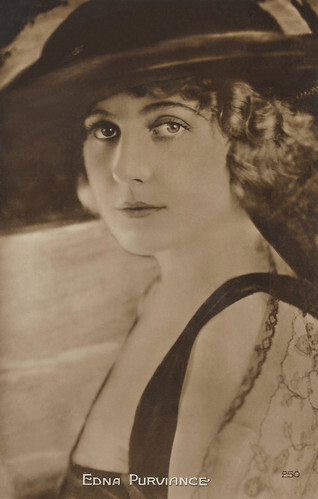
French postcard by Cinémagazine-Edition, Paris, no. 250.
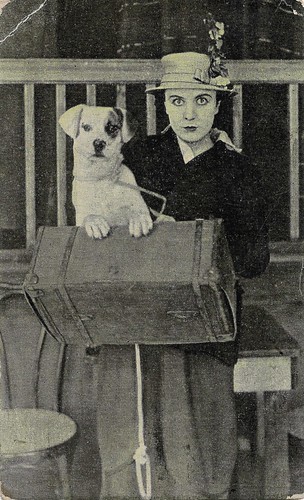
Spanish collector card by Chocolate Amatller, Marca Luna series 9, no. 4. Photo: First National. Edna Purviance in A Dog's Life (Charlie Chaplin, 1918).
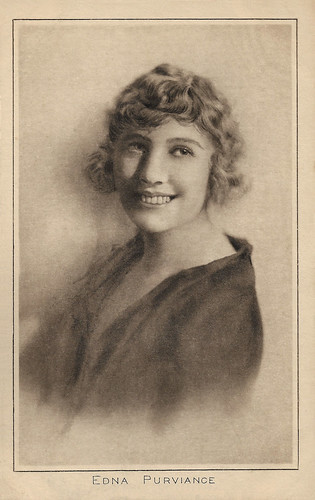
British postcard in the 'Pictures' Portrait Gallery, no. 94, by Pictures Ltd., London.
Too serious for a comic role?
Olga Edna Purviance was born in 1895 in Paradise Valley, Nevada. She lived there until 1898. Then the family moved to Lovelock, where her parents ran a hotel. In 1902, her parents divorced. She was a talented piano player as a teenager. In 1913, Edna went to San Francisco and moved in with her married sister Bessie while attending business college. She began working as a stenographer in San Francisco.
In 1915, a talent scout for Charles Chaplin discovered Edna in a café and invited her to the Essanay Studio. Chaplin was looking for a leading lady for his next film, His Night Out. He was not convinced about her at first and thought she would be too serious for a comic role. Finally, he gave her the part, and she debuted in His Night Out (Charlie Chaplin, 1915).
Her relationship with Charles Chaplin became, at one point, romantic as well as professional (1915-1917). However, the romance was abruptly over after he was forced into a shotgun wedding with 16-year-old Mildred Harris. Nevertheless, Purviance continued to be his leading lady.
Over the next seven years, she appeared as his leading lady in over 30 Chaplin films made by Essanay, Mutual, and First National. These included the classics The Tramp (1915), The Immigrant (1917), Easy Street (1917), The Kid (1921), and The Idle Class (1921).
Her sweet, girlish counterbalance to his rambunctious antics became a marketable commodity. It was later speculated that if they had married, Chaplin could have been spared much of the domestic troubles and scandals that would plague him in his life.
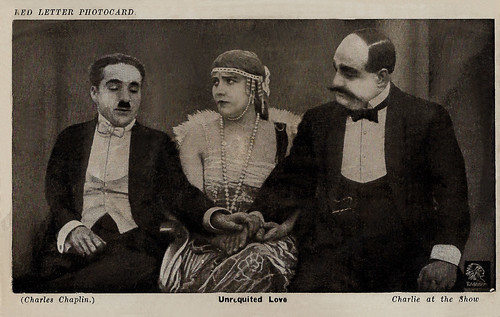
British postcard by Red Letter. Photo: Essanay. Charlie Chaplin in his film A Night in the Show/Charlie at the Show (Charles Chaplin, 1915), in which he played a double role. Right of him, Edna Purviance, the man may be George Cleethorpe. Caption: Unrequited Love.
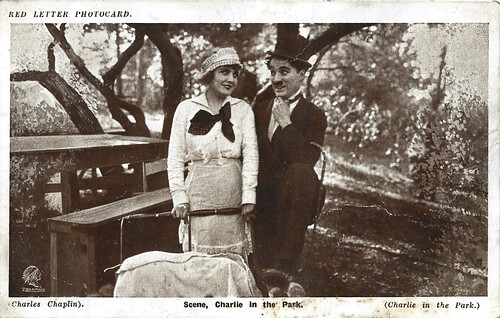
British postcard by Red Letter. Photo: Essanay. Charlie Chaplin and Edna Purviance in In the Park (Charles Chaplin, 1915). Caption: Scene, Charlie in the Park (Charlie in the Park).
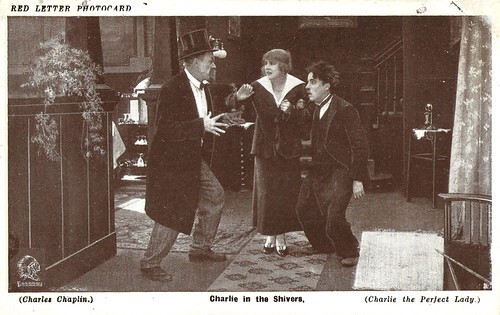
British postcard by Red Letter. Photo: Essanay. Charlie Chaplin in A Woman (Charles Chaplin, 1915), also with Edna Purviance as the daughter and Charles Inslee as the father. Caption: Charlie in the Shivers (Charlie the Perfect Lady.)
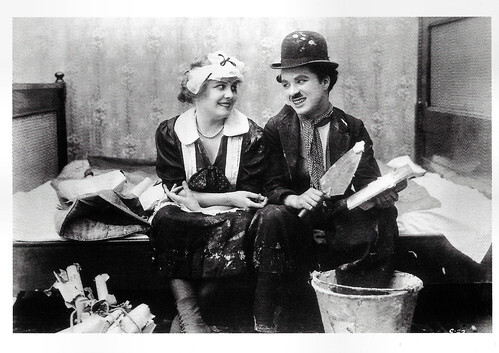
Vintage postcard, printed in Italy, by CVB Publishers / News Productions, no. 56617. Photo: C. Bubbles Inc. / Collection de la Cinematheque Suisse. Edna Purviance and Charlie Chaplin in Work (Charles Chaplin, 1915).
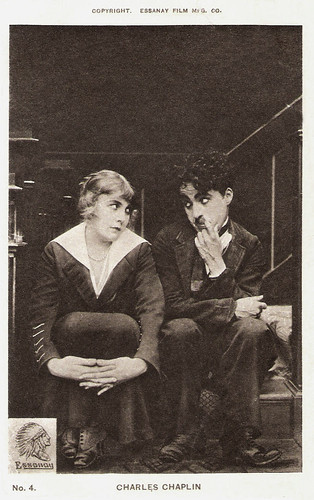
British postcard by Red Letter, no. 4. Photo: Essanay. Charlie Chaplin and Edna Purviance.
Showing her more concern and consideration than his former wives
As a repayment for Edna Purviance's years of work with him, Charles Chaplin intended real stardom for her with the film drama A Woman of Paris: A Drama of Fate (Charlie Chaplin, 1923). The film was a commercial failure, though it advanced the career of Adolphe Menjou .
Edna Purviance made two more silent films. The first was Sea Gulls / A Woman of the Sea (Josef von Sternberg, 1926), produced by Charles Chaplin . Chaplin never released the film, and now the film is considered lost. In 1933, the negative was destroyed so that all losses incurred by the production could be written off.
Edna's final silent production was the French film Éducation de prince / Education of a Prince (Henri Diamant-Berger, 1927). In France, Purviance was injured when she fell from a sleigh being pulled by runaway horses in Lyons. Armand Bernard , who had just made the Éducation de prince / Education of a Prince with her, was injured trying to stop the horses.
After her retirement, Charles Chaplin kept Purviance on his payroll at $1000 a month for decades, showing her much more concern and consideration than he did to any of his former wives. Her last two appearances were non-speaking extra parts in his Monsieur Verdoux (1947) and Limelight (1952).
In 1938, Edna Purviance married John P. Squire, a Pan-American Airlines pilot, who died in 1945. Chaplin's monthly payments resumed after her husband's death. Edna Purviance died of throat cancer in 1958 at the Motion Picture & Television Country House and Hospital in Los Angeles. She was interred in the West Mausoleum at Grand View Memorial Park, Glendale, California. She was portrayed by Penelope Ann Miller in the film Chaplin (Richard Attenborough, 1992).
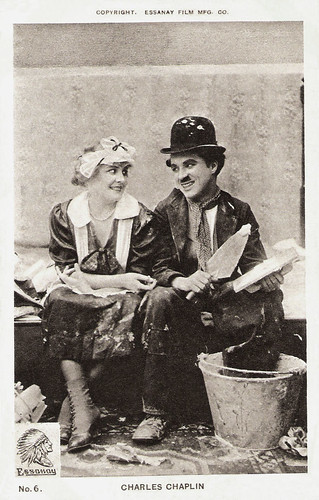
British postcard by Red Letter, no. 6. Photo: Essanay. Charlie Chaplin and Edna Purviance in Work (Charles Chaplin, 1915).
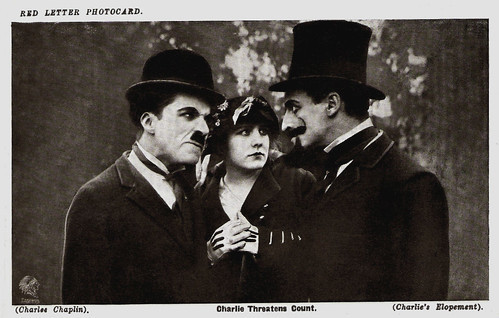
British postcard by Red Letter. Photo: Essanay. Charlie Chaplin , Edna Purviance and Leo White in A Jitney Elopement (Charles Chaplin, 1915). Caption: Charlie Threatens Count. (Charlie's Elopement.)
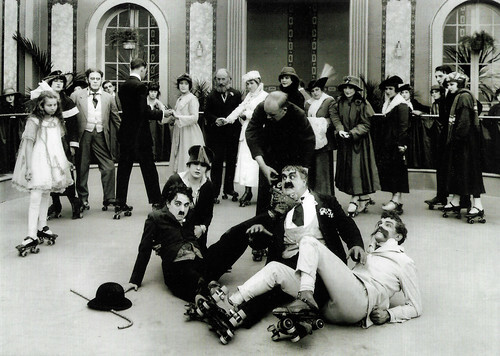
French postcard by Lobster Films, Prsi, no. 30. Charlie Chaplin , Edna Purviance, Eric Campbell and Albert Austin in The Rink (Charles Chaplin, 1916).
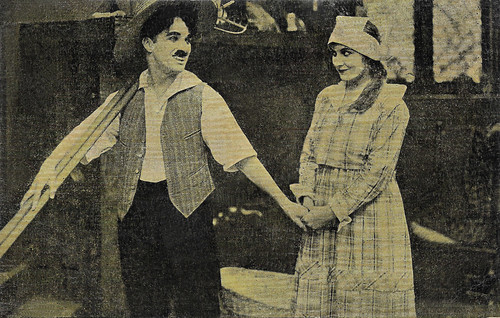
Spanish collector card by Chocolate Amatller, Marca Luna series 9, no. 13. Photo: First National. Charlie Chaplin in A Dog's Life (Charles Chaplin, 1918).
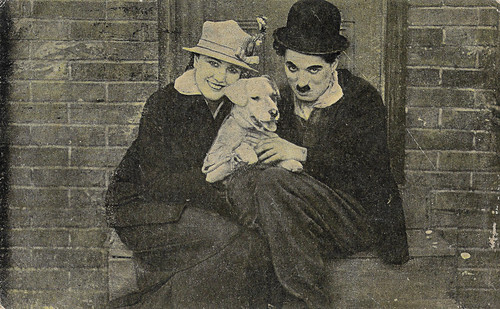
Spanish collector card by Chocolate Amatller, Marca Luna series 9, no. 16. Photo: First National. Charlie Chaplin in A Dog's Life (Charles Chaplin, 1918).
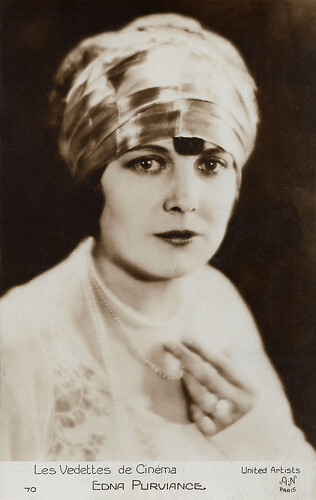
French postcard by A.N., Paris in the series Les Vedettes de Cinéma, no. 70. Photo: United Artists.
Sources: (IMDb), Wikipedia (English and Dutch) and .

French postcard by Cinémagazine-Edition, Paris, no. 250.

Spanish collector card by Chocolate Amatller, Marca Luna series 9, no. 4. Photo: First National. Edna Purviance in A Dog's Life (Charlie Chaplin, 1918).

British postcard in the 'Pictures' Portrait Gallery, no. 94, by Pictures Ltd., London.
Too serious for a comic role?
Olga Edna Purviance was born in 1895 in Paradise Valley, Nevada. She lived there until 1898. Then the family moved to Lovelock, where her parents ran a hotel. In 1902, her parents divorced. She was a talented piano player as a teenager. In 1913, Edna went to San Francisco and moved in with her married sister Bessie while attending business college. She began working as a stenographer in San Francisco.
In 1915, a talent scout for Charles Chaplin discovered Edna in a café and invited her to the Essanay Studio. Chaplin was looking for a leading lady for his next film, His Night Out. He was not convinced about her at first and thought she would be too serious for a comic role. Finally, he gave her the part, and she debuted in His Night Out (Charlie Chaplin, 1915).
Her relationship with Charles Chaplin became, at one point, romantic as well as professional (1915-1917). However, the romance was abruptly over after he was forced into a shotgun wedding with 16-year-old Mildred Harris. Nevertheless, Purviance continued to be his leading lady.
Over the next seven years, she appeared as his leading lady in over 30 Chaplin films made by Essanay, Mutual, and First National. These included the classics The Tramp (1915), The Immigrant (1917), Easy Street (1917), The Kid (1921), and The Idle Class (1921).
Her sweet, girlish counterbalance to his rambunctious antics became a marketable commodity. It was later speculated that if they had married, Chaplin could have been spared much of the domestic troubles and scandals that would plague him in his life.

British postcard by Red Letter. Photo: Essanay. Charlie Chaplin in his film A Night in the Show/Charlie at the Show (Charles Chaplin, 1915), in which he played a double role. Right of him, Edna Purviance, the man may be George Cleethorpe. Caption: Unrequited Love.

British postcard by Red Letter. Photo: Essanay. Charlie Chaplin and Edna Purviance in In the Park (Charles Chaplin, 1915). Caption: Scene, Charlie in the Park (Charlie in the Park).

British postcard by Red Letter. Photo: Essanay. Charlie Chaplin in A Woman (Charles Chaplin, 1915), also with Edna Purviance as the daughter and Charles Inslee as the father. Caption: Charlie in the Shivers (Charlie the Perfect Lady.)

Vintage postcard, printed in Italy, by CVB Publishers / News Productions, no. 56617. Photo: C. Bubbles Inc. / Collection de la Cinematheque Suisse. Edna Purviance and Charlie Chaplin in Work (Charles Chaplin, 1915).

British postcard by Red Letter, no. 4. Photo: Essanay. Charlie Chaplin and Edna Purviance.
Showing her more concern and consideration than his former wives
As a repayment for Edna Purviance's years of work with him, Charles Chaplin intended real stardom for her with the film drama A Woman of Paris: A Drama of Fate (Charlie Chaplin, 1923). The film was a commercial failure, though it advanced the career of Adolphe Menjou .
Edna Purviance made two more silent films. The first was Sea Gulls / A Woman of the Sea (Josef von Sternberg, 1926), produced by Charles Chaplin . Chaplin never released the film, and now the film is considered lost. In 1933, the negative was destroyed so that all losses incurred by the production could be written off.
Edna's final silent production was the French film Éducation de prince / Education of a Prince (Henri Diamant-Berger, 1927). In France, Purviance was injured when she fell from a sleigh being pulled by runaway horses in Lyons. Armand Bernard , who had just made the Éducation de prince / Education of a Prince with her, was injured trying to stop the horses.
After her retirement, Charles Chaplin kept Purviance on his payroll at $1000 a month for decades, showing her much more concern and consideration than he did to any of his former wives. Her last two appearances were non-speaking extra parts in his Monsieur Verdoux (1947) and Limelight (1952).
In 1938, Edna Purviance married John P. Squire, a Pan-American Airlines pilot, who died in 1945. Chaplin's monthly payments resumed after her husband's death. Edna Purviance died of throat cancer in 1958 at the Motion Picture & Television Country House and Hospital in Los Angeles. She was interred in the West Mausoleum at Grand View Memorial Park, Glendale, California. She was portrayed by Penelope Ann Miller in the film Chaplin (Richard Attenborough, 1992).

British postcard by Red Letter, no. 6. Photo: Essanay. Charlie Chaplin and Edna Purviance in Work (Charles Chaplin, 1915).

British postcard by Red Letter. Photo: Essanay. Charlie Chaplin , Edna Purviance and Leo White in A Jitney Elopement (Charles Chaplin, 1915). Caption: Charlie Threatens Count. (Charlie's Elopement.)

French postcard by Lobster Films, Prsi, no. 30. Charlie Chaplin , Edna Purviance, Eric Campbell and Albert Austin in The Rink (Charles Chaplin, 1916).

Spanish collector card by Chocolate Amatller, Marca Luna series 9, no. 13. Photo: First National. Charlie Chaplin in A Dog's Life (Charles Chaplin, 1918).

Spanish collector card by Chocolate Amatller, Marca Luna series 9, no. 16. Photo: First National. Charlie Chaplin in A Dog's Life (Charles Chaplin, 1918).

French postcard by A.N., Paris in the series Les Vedettes de Cinéma, no. 70. Photo: United Artists.
Sources: (IMDb), Wikipedia (English and Dutch) and .
Published on October 06, 2025 22:00
October 5, 2025
Zingari (1920)
Le Giornate del Cinema Muto is the world’s leading international silent film festival. From 4 to 11 July 2025, EFSP contributor Ivo Blom is in Pordenone in Northern Italy to attend the 44th edition of the festival. And like Ivo, the festival is still going strong and presents many rediscoveries and highlights. Gabriele Perrone, Paolo Tosini, and Marco Grifo curated a programme on Italian diva Italia Almirante Manzini. Tonight, her film Zingari / The Gypsy Feud (1920) will be presented, accompanied by Günter Buchwald, Elizabeth-Jane Baldry and Frank Bockius. Italia Almirante stars as Vielka, the daughter of the King of the gypsies. The film was directed by her husband, Mario Almirante, for the Fert Film studio.
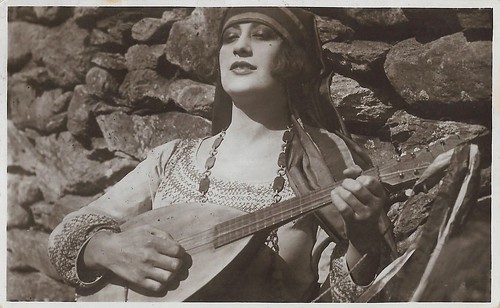
Italian postcard for Zingari (Mario Almirante, 1920), starring Italia Almirante .
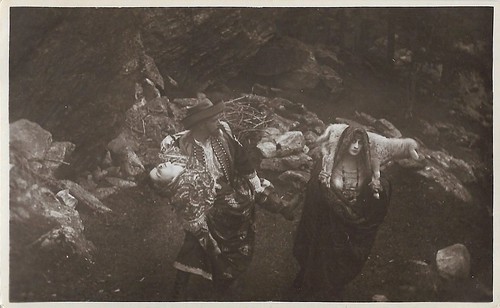
Italian postcard for Zingari (Mario Almirante, 1920). Caption: The first encounter between Vielka ( Italia Almirante ) and Sindel ( Amleto Novelli ). The woman Novelli carries may be Rosetta Solari, who plays Radscia.
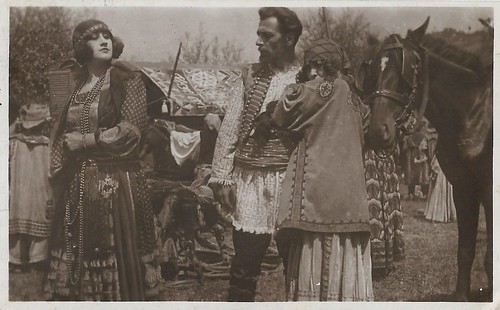
Italian postcard for Zingari (Mario Almirante, 1920). Caption: Vielka challenges Sindel. The second woman may be Rosetta Solari.
A warm, vigorous and deeply human performance
In Zingari / The Gypsy Feud (1920), Old Jammadar (Alfonso Cassini), King of the gypsies, wants to marry his daughter Vielka ( Italia Almirante ) to Gudlo (Franz Sala), a member of an important and valuable clan, but also a violent and ambitious man.
Vielka, instead, loves the head of another clan, Sindel ( Amleto Novelli ). When Jammadar dies, Vielka is crowned Queen of the gypsies. The proud Sindel distances himself from the woman out of fear of becoming a prince's consort. The perfidious Gudlo wounds and betrays Sindel, but Vielka renounces her crown and thus regains Sindel's love, who chases Gudlo from the clan.
Zingari was produced by Fert Film and distributed by Pittaluga. The film was scripted and directed by Mario Almirante and photographed by Ubaldo Arata. It was one of Arata's first films. The active cinematographer did over 100 films between 1918 and 1947, including Roberto Rossellini's Roma città aperta / Rome, Open City (1945).
The film premiered on 27 December 1920. At the time, critics wrote mixed reviews. The Neapolitan Cine-Fono wrote that despite the luxurious mise-en-scene, the script and direction were not top-notch, while Italia Almirante was beautiful but too external and lacking psychology, and her co-star, Amleto Novelli, was straight-jacked in his acting.
Instead, the Roman journal Febo wrote that despite well-known romantic elements, the story was solid, convincing and at times original. Also, the mise-en-scène was impeccable, faithful to the interiors, and picturesque for the exteriors, while the film technology used showed modernity and innovation. Among the performances of the actors, in particular that of Italia Almirante was singled out as warm, vigorous and deeply human.
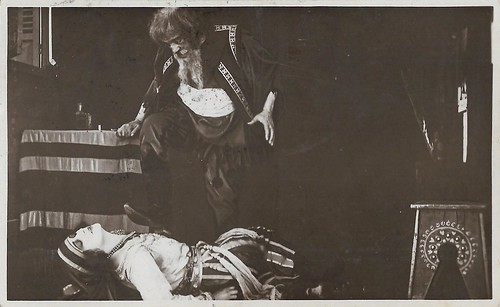
Italian postcard for Zingari (Mario Almirante, 1920). Caption: Jammadar (Alfonso Cassini) shouts to Vielka ( Italia Almirante ): I will crush you!
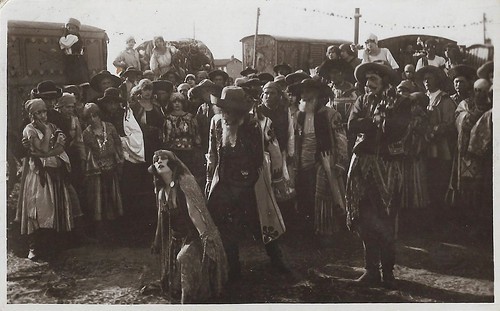
Italian postcard for Zingari (Mario Almirante, 1920). Caption: Jammadar forces Vielka to marry Gudlo.
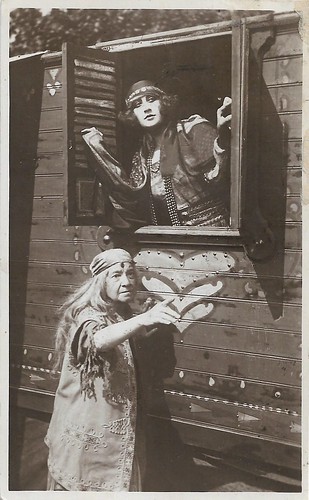
Italian postcard for Zingari (Mario Almirante, 1920). Caption: Vielka returns to the gypsy wagon.
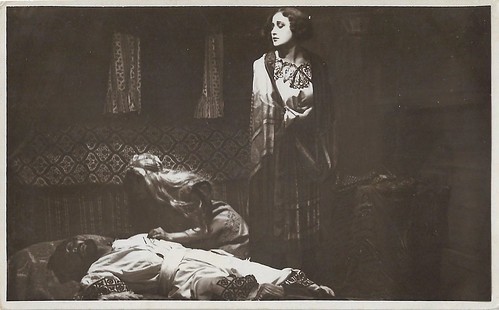
Italian postcard for Zingari (Mario Almirante, 1920). Caption: Vielka ( Italia Almirante ) tends to the wounded Sindel ( Amleto Novelli ) in her wagon.
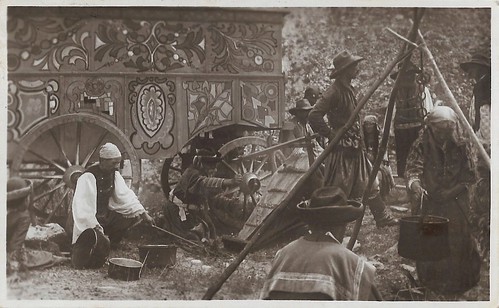
Italian postcard for Zingari (Mario Almirante, 1920). Caption: The gypsy camp.
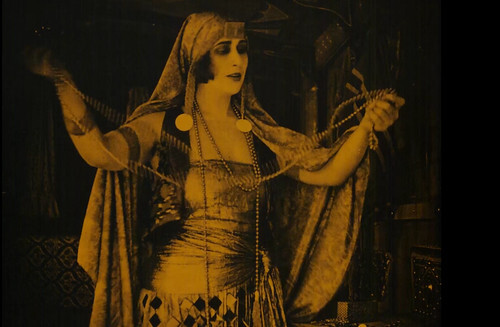
Publicity still for Le Giornate del Cinema Muto 2025. Credits: CSC - Cineteca Nazionale. Italia Almirante Manzini in Zingari (Mario Almirante, 1920).
Sources: Vittorio Martinelli (Il cinema muto italiano 1920 - Italian), Wikipedia (Italian and English), and IMDb.

Italian postcard for Zingari (Mario Almirante, 1920), starring Italia Almirante .

Italian postcard for Zingari (Mario Almirante, 1920). Caption: The first encounter between Vielka ( Italia Almirante ) and Sindel ( Amleto Novelli ). The woman Novelli carries may be Rosetta Solari, who plays Radscia.

Italian postcard for Zingari (Mario Almirante, 1920). Caption: Vielka challenges Sindel. The second woman may be Rosetta Solari.
A warm, vigorous and deeply human performance
In Zingari / The Gypsy Feud (1920), Old Jammadar (Alfonso Cassini), King of the gypsies, wants to marry his daughter Vielka ( Italia Almirante ) to Gudlo (Franz Sala), a member of an important and valuable clan, but also a violent and ambitious man.
Vielka, instead, loves the head of another clan, Sindel ( Amleto Novelli ). When Jammadar dies, Vielka is crowned Queen of the gypsies. The proud Sindel distances himself from the woman out of fear of becoming a prince's consort. The perfidious Gudlo wounds and betrays Sindel, but Vielka renounces her crown and thus regains Sindel's love, who chases Gudlo from the clan.
Zingari was produced by Fert Film and distributed by Pittaluga. The film was scripted and directed by Mario Almirante and photographed by Ubaldo Arata. It was one of Arata's first films. The active cinematographer did over 100 films between 1918 and 1947, including Roberto Rossellini's Roma città aperta / Rome, Open City (1945).
The film premiered on 27 December 1920. At the time, critics wrote mixed reviews. The Neapolitan Cine-Fono wrote that despite the luxurious mise-en-scene, the script and direction were not top-notch, while Italia Almirante was beautiful but too external and lacking psychology, and her co-star, Amleto Novelli, was straight-jacked in his acting.
Instead, the Roman journal Febo wrote that despite well-known romantic elements, the story was solid, convincing and at times original. Also, the mise-en-scène was impeccable, faithful to the interiors, and picturesque for the exteriors, while the film technology used showed modernity and innovation. Among the performances of the actors, in particular that of Italia Almirante was singled out as warm, vigorous and deeply human.

Italian postcard for Zingari (Mario Almirante, 1920). Caption: Jammadar (Alfonso Cassini) shouts to Vielka ( Italia Almirante ): I will crush you!

Italian postcard for Zingari (Mario Almirante, 1920). Caption: Jammadar forces Vielka to marry Gudlo.

Italian postcard for Zingari (Mario Almirante, 1920). Caption: Vielka returns to the gypsy wagon.

Italian postcard for Zingari (Mario Almirante, 1920). Caption: Vielka ( Italia Almirante ) tends to the wounded Sindel ( Amleto Novelli ) in her wagon.

Italian postcard for Zingari (Mario Almirante, 1920). Caption: The gypsy camp.

Publicity still for Le Giornate del Cinema Muto 2025. Credits: CSC - Cineteca Nazionale. Italia Almirante Manzini in Zingari (Mario Almirante, 1920).
Sources: Vittorio Martinelli (Il cinema muto italiano 1920 - Italian), Wikipedia (Italian and English), and IMDb.
Published on October 05, 2025 22:00
October 4, 2025
Lil Dagover
This evening's show in Teatro Verdi in Pordenone is a screening of Der Müde Tod / Destiny (1921) by Fritz Lang with live accompaniment by Ilya Poletaev. Star is the German, Dutch-born film actress Lil Dagover (1887-1980), an exotic, dark beauty, who featured prominently during the golden age of the German silent cinema. She had her breakthrough as the prey of Dr. Caligari's monster in the classic expressionist film Das Cabinet des Dr. Caligari (1920). In Der Müde Tod, she plays a young woman who is determined to rescue her fiancé from death. Death, in human form, reluctantly allows the desperate woman the chance to bring her beloved back to life via three successive scenarios. Each is set in a distinct cultural and historical realm, offering contrasting possibilities for the film’s visual design.
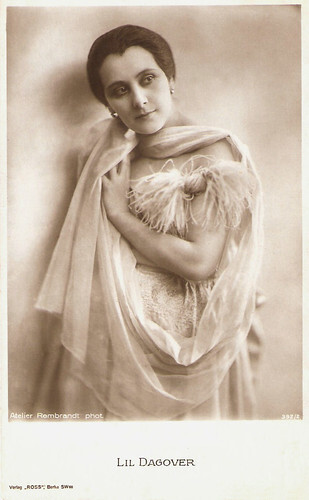
German postcard by Ross Verlag, Berlin, no. 392/2, 1919-1924. Photo: Atelier Rembrandt, Berlin.
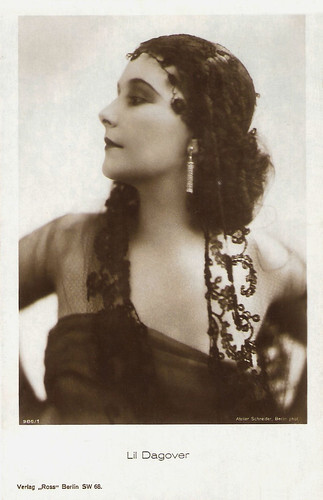
German postcard by Ross Verlag, Berlin, no. 905/1, 1925-1926. Photo: Atelier Schneider, Berlin.
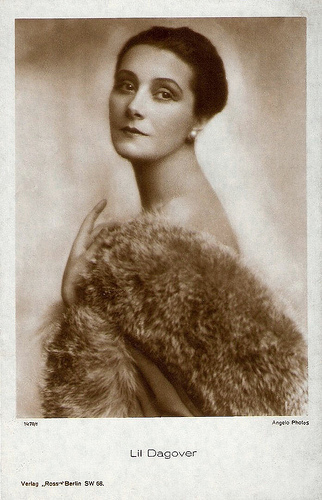
German postcard by Ross Verlag, Berlin, no. 1470/1, 1927-1928. Photo: Angelo Photos.
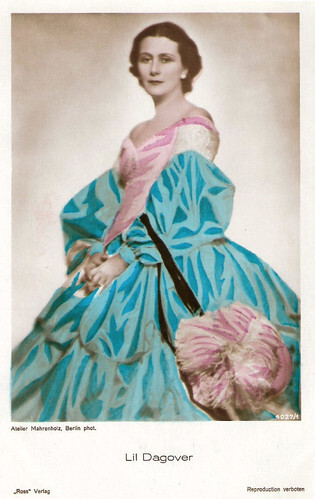
German postcard by Ross Verlag, Berlin, no. 4027/1, 1929-1930. Photo: Atelier Mahrenholz, Berlin.
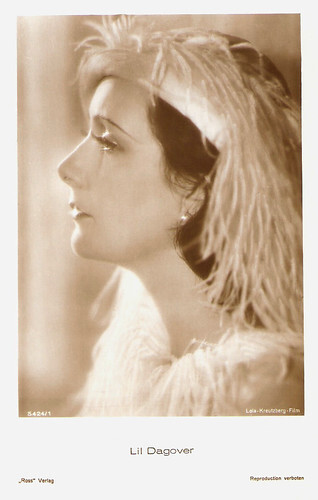
German postcard by Ross Verlag, Berlin, no. 5424/1, 1930-1931. Photo: Lola - Kreutzberg - Film.
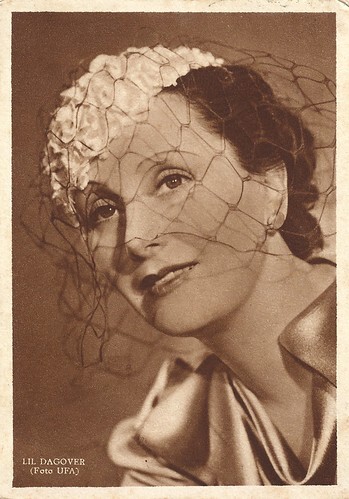
Italian postcard by Rizzoli, 1940. Photo: Ufa.
Victimised heroine
Lil Dagover was born Maria Antonia Siegelinde Martha Seubert in Madiun on the island of Java in the Dutch East Indies, now Indonesia, in 1887 (some sources say 1894 or 1897). She was the daughter of a forest ranger in the service of the Dutch colonial authorities.
From the age of 10, she was educated in Baden-Baden, Germany. She made her film debut in 1913 as a snake dancer in Schlangentanz / Snake Dance, a documentary by Louis Held. Although she never got acting lessons, she played parts in Die Retterin/The Saviour (Christa Christensen, 1916), Lebendig tot/Living Dead (Alwin Neuss, 1918) and Die Maske / The Mask (Ewald André Dupont, 1919).
In 1917, she married actor Fritz Daghofer, who was 25 years her senior. He introduced her to the directors Robert Wiene and Fritz Lang . The couple divorced in 1919, and the union produced a daughter, Eva Marie, born the year of the divorce. Lil kept her husband's surname but slightly changed it to Dagover. Eva married Hungarian director Géza von Radványi in 1930.
Lil Dagover's career gathered speed with Die Spinnen / The Spiders (Fritz Lang, 1919-1920) and Harakiri (Fritz Lang, 1919). In the latter film, she already impersonated the fine lady whom she usually played in her future films. Next, she appeared in the classic expressionist film Das Cabinet des Dr. Caligari / The Cabinet of Dr. Caligari (Robert Wiene, 1920). In this film, her jet-black hair parted in the middle and flattened to the shape of her head, her long, white face, and her huge, expressive eyes all served to create the archetypal, victimised heroine of the expressionist melodramas.
For Fritz Lang , she played in two more masterpieces, Der müde Tod / Destiny (Fritz Lang, 1921), as a woman begging Death to hand her lover back, and Dr. Mabuse, der Spieler - Ein Bild der Zeit / Dr. Mabuse: the Gambler (Fritz Lang, 1922). She also appeared in two silent classics by Friedrich Wilhelm Murnau , Phantom / The Phantom (F.W. Murnau, 1922) with Alfred Abel , and Tartüff / Tartuffe (F.W. Murnau, 1925) with Emil Jannings , and in Zur Chronik von Grieshuus / At the Grey House (Arthur von Gerlach, 1925).
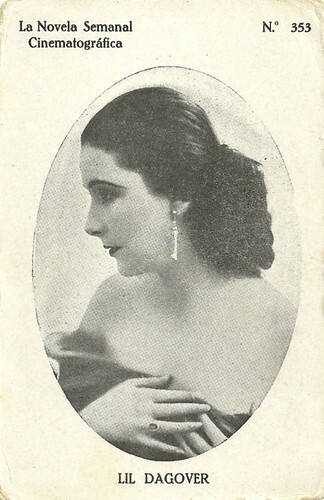
Spanish postcard by La Novela Semanal Cinematografica, no. 353.
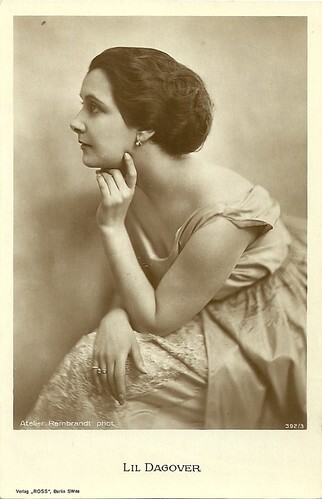
German postcard by Ross Verlag, no. 392/3, 1919-1924. Photo: Atelier Rembrandt.
![Lil Dagover [?] in Der Tänzer (1919)](https://i.gr-assets.com/images/S/compressed.photo.goodreads.com/hostedimages/1759655035i/37279593.jpg)
German postcard by Ross Verlag, no. 632/1, 1919-1924. Photo: Maxim Film. Lil Dagover in Der Tänzer / The Dancer (Carl Froehlich, 1919) and based on the novel by Felix Holländer.
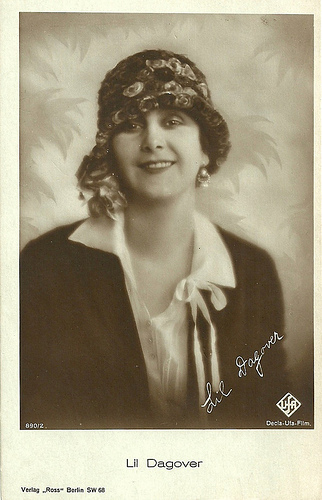
German postcard by Ross Verlag, no. 890/2, 1925-1926. Photo: Decla-Ufa-Film.
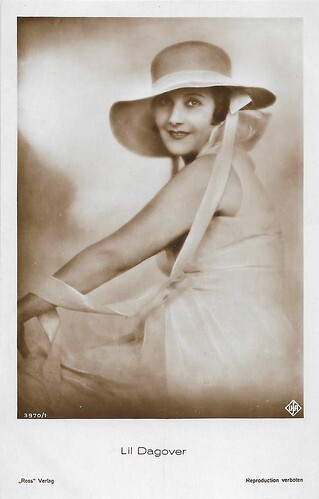
German postcard by Ross Verlag, no. 3970/1, 1928-1929. Photo: Ufa.
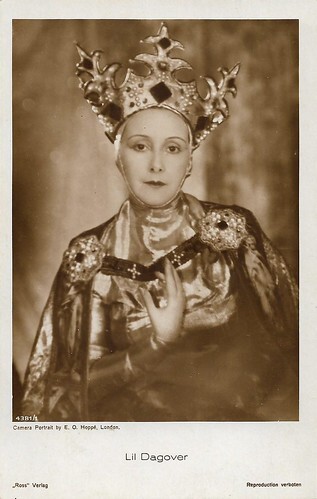
German postcard by Ross Verlag, no. 4381/1, 1929-30. Photo: E.O. Hoppé, London. Hoppé shot many celebrities on and off the Ufa film sets in Berlin in 1927-1928.
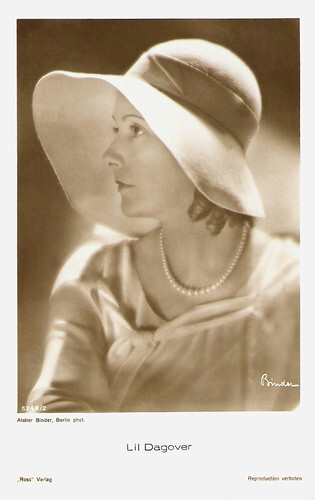
German postcard by Ross Verlag, no. 5249/2, 1930-1931. Photo: Atelier Binder.
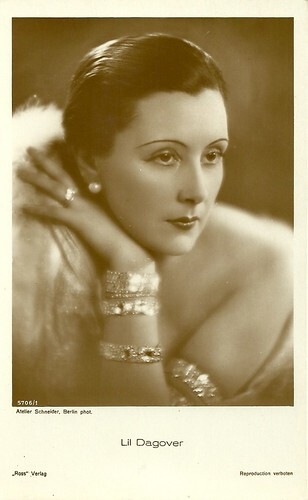
German postcard by Ross Verlag, no. 5706/1, 1930-1931. Photo: Atelier Schneider, Berlin.
Salondame
In 1925, Lil Dagover made her stage debut under the direction of Max Reinhardt . In the following years, she played in Reinhardt’s Deutsches Theater in Berlin and also at the Salzburg Festival. Apart from trips to Sweden, France, and Hollywood, most of her career and fate were linked to that of German cinema.
Initially, her role was that of the frail, menaced heroine, but gradually her fine and evanescent beauty changed over time. Film historian Vittorio Martinelli describes in 'Cinegrafie' that "her face became calmer, her figure acquired a harmonious and restful opulence which, together with the natural elegance of her bearing and the constant accuracy of her style of dressing, turned her into a 'Salondame', a lady of the screen."
In 1926, she married producer Georg Witt, who produced many of her following films. Roles in Die Brüder Schellenberg / The Brothers Schellenberg (Karl Grune, 1926) opposite Conrad Veidt , Der geheime Kurier / The Secret Courier (Gennaro Righelli, 1928) with Ivan Mozzhukhin and Ungarische Rhapsodie / Hungarian Rhapsody (Hanns Schwarz, 1928) with Willy Fritsch , were well suited to her new allure.
She also made several films in Sweden for directors Olof Molander and Gustaf Molander and appeared in French silent films. Her last film appearance of the 1920s was in the French silent film Monte Cristo (Henri Fescourt, 1929) opposite Jean Angelo and Marie Glory .
With her theatre experience, she easily survived the coming of sound. In 1930, she made her sound debut in the crime comedy Va Banque (Erich Waschneck, 1930). Her deep voice went down well in such films as the popular operetta Der Kongreß tanzt / The Congress Dances (Erik Charell, 1931). She also visited Hollywood, where she appeared in The Woman from Monte Carlo (Michael Curtiz, 1931) with Walter Huston, shot on location in the United States. It was not a success, and she returned to Germany.
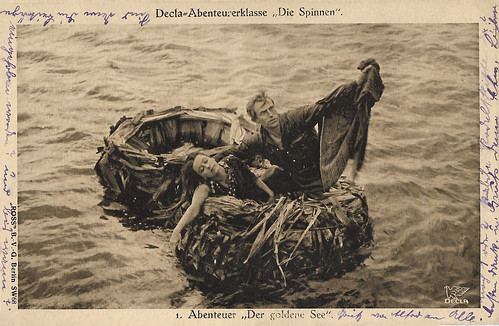
German postcard by Ross Verlag, no. 3143. Photo Decla. Carl de Vogt and Lil Dagover in Die Spinnen, 1. Teil - Der Goldene See (Fritz Lang, 1919). Caption: Decla-Abenteuerklasse "Die Spinnen, 1. Abenteuer "Der Goldene See". (Decla-adventure class "The Spiders", 1st adventure "The Golden Lake".) Sent by mail in 1924.
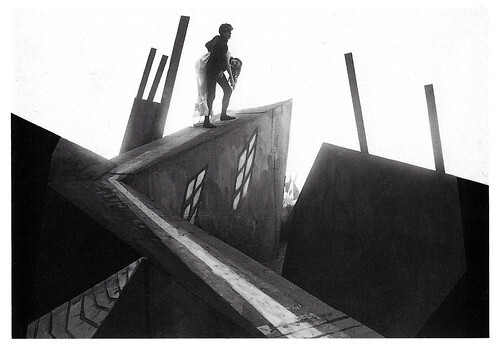
Swiss-German-British postcard by News Productions, Baulmes / Filmwelt Berlin, Bakede / News Productions, Stroud, no. 56535. Photo: Collection Cinémathèque Suisse, Lausanne. Conrad Veidt and Lil Dagover in Das Kabinett des Dr. Caligari / Das Cabinet des Dr. Caligari (Robert Wiene, 1920), produced by Decla Film, Berlin - Bolz und Cie.
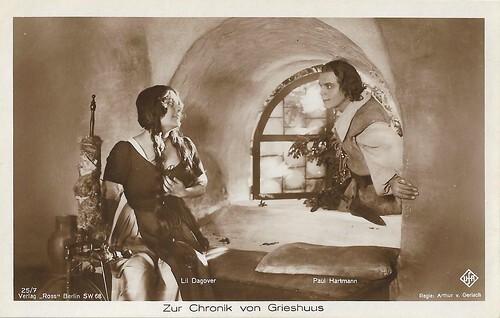
German postcard by Ross Verlag, no. 25/7. Photo: Ufa. Lil Dagover and Paul Hartmann in the German silent film Zur Chronik von Grieshuus / The Chronicles of the Gray House (Arthur von Gerlach, 1925).
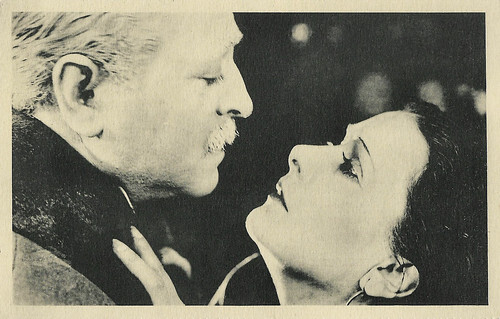
French postcard by Film français Aubert, Paris. Photo: Gaston Jacquet and Lil Dagover in Le Tourbillon de Paris / The Maelstrom of Paris (Julien Duvivier, 1928).
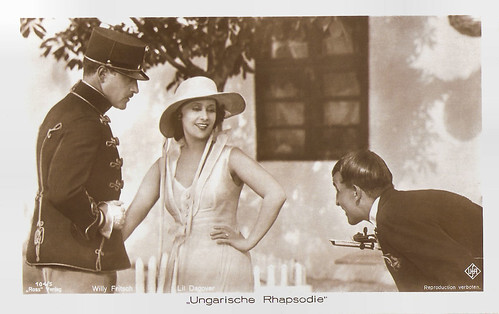
German postcard by Ross Verlag, no. 104/5. Photo: Ufa. Willy Fritsch and Lil Dagover in Ungarische Rhapsodie / Hungarian Rhapsody (Hanns Schwarz, 1928).
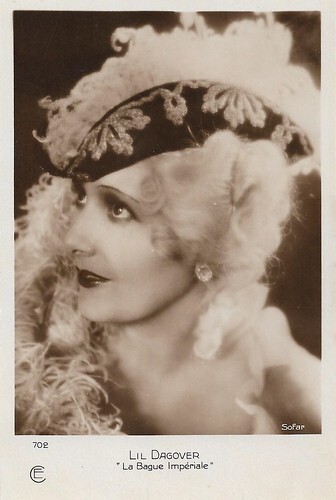
French postcard by Cinémagazine-Edition, no. 702. Photo: Sofar / Greenbaum-Film. Lil Dagover as Empress Maria Theresia in the period drama La Bague impériale, the French release title of the German film Der Günstling von Schönbrunn (Erich Waschneck, Max Reichmann, 1929), with Ivan Petrovich in the male lead as Colonel Trenck.
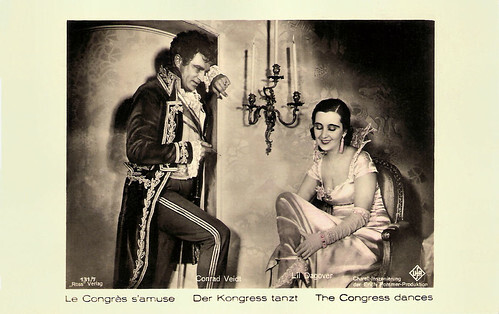
German postcard by Ross Verlag, no. 131/7. Photo: Ufa. Conrad Veidt as Count Metternich and Lil Dagover as Countess in Der Kongress tanzt / The Congress dances (Erik Charell, 1931).
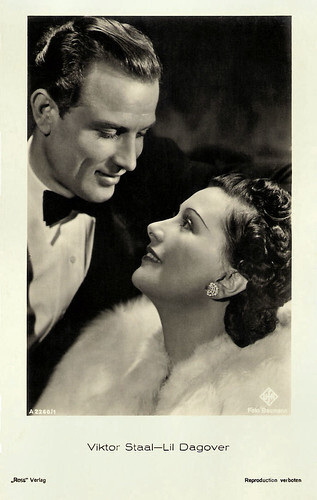
German postcard by Ross Verlag, no. A 2260/1, 1939-1940. Photo: Baumann / Ufa. Viktor Staal and Lil Dagover in Umwege zum Glück / Detours to happiness (Fritz Peter Buch, 1939).
War merits cross
Reportedly, Lil Dagover was a close friend of Adolph Hitler. She avoided overt political involvement and generally appeared in popular costume musicals and comedies during World War II. However, she acted in army shows and at war theatres and in 1944 she received the War Merits Cross.
During the Nazi era, she starred in films like the Oscar Wilde adaptation Lady Windermeres Fächer / Lady Windermere's Fan (Heinz Hilpert, 1935), Der Höhere Befehl / The Higher Command (Gerhard Lamprecht, 1935), Schlussakkord / Final Accord (Detlev Sierck (Douglas Sirk), 1936), the first (short) German colour film Das Schönheitsfleckchen / The Little Beauty Mark (Rolf Hansen, 1936), Kreutzersonate / The Kreutzer Sonata (Veit Harlan, 1937) and Bismarck (Wolfgang Liebeneiner, 1940).
She easily continued her career in post-war Germany and acted occasionally on stage and television. She played ‘age parts’ in films like Vom Teufel gejagt/Hunted by the Devil (Victor Tourjansky, 1950), Rosen im Herbst / Roses in Autumn (Rudolf Jugert, 1955), Bekenntnisse des Hochstaplers Felix Krull / Confessions of Felix Krull (Kurt Hoffmann, 1957) and Buddenbrooks / The Buddenbrooks (Alfred Weidenmann, 1959), an adaptation of the Thomas Mann novel with Liselotte Pulver .
A great succès d'estime was her role as an eccentric old woman in the Edgar Wallace adaptation Die seltsame Gräfin / The Strange Countess (Josef von Báky, 1961). The last highlights of the ‘Grande Dame’ comprised the Academy Award-nominated and Golden Globe-winning for Best Foreign-Language Foreign Film of 1974 - Der Fusssgänger / The Pedestrian (Maximilian Schell, 1973), Karl May (Hans-Jürgen Syberberg, 1974), the crime-drama Der Richter und sein Henker / Getting Away with Murder (Maximilian Schell, 1975) with Donald Sutherland, and Geschichten aus dem Wiener Wald / Tales from the Vienna Woods (Maximilian Schell, 1979).
Her film career lasted over half a century, and she won many awards, including the Bundesfilmpreis in 1954 and the Filmband in Gold in 1962. She justly titled her memoirs 'Ich war die Dame' (I was the Lady) in 1979. Lil Dagover died in 1980, in Munich, Germany, at the age of 92. She was buried at the Waldfriedhof Grünwald cemetery in Munich.
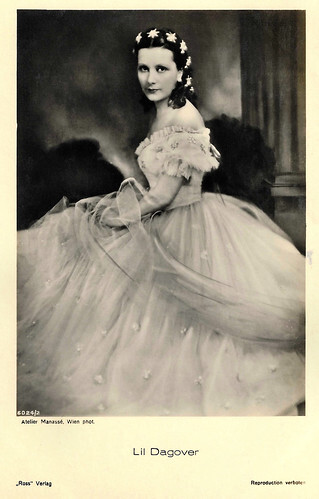
German postcard by Ross Verlag, no. 6024/2, 1931-1932. Photo: Atelier Manassé, Wien. Lil Dagover in Elisabeth von Österreich / Elisabeth of Austria (Adolf Trotz, 1931). Collection: Geoffrey Donaldson Institute.
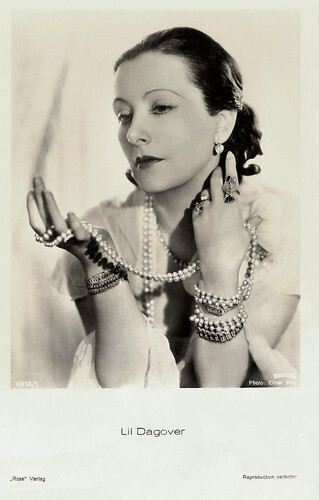
German postcard by Ross Verlag, Berlin, no. 6312/1, 1931-1932. Photo: Elmer Fry.
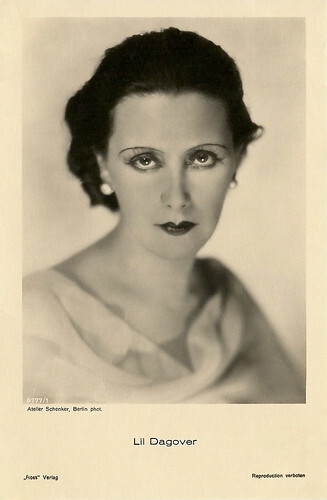
German postcard by Ross Verlag, Berlin, no. 6777/1, 1931-1932. Photo: Atelier Schenker, Berlin. Collection: Didier Hanson.
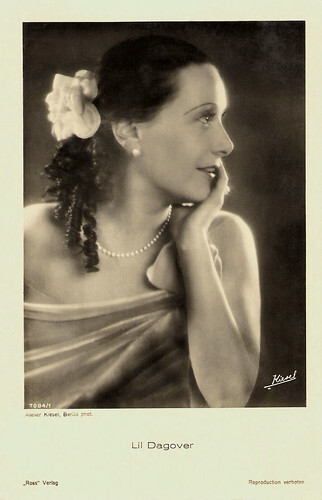
German postcard by Ross Verlag, Berlin, no. 7084/1, 1932-1933. Photo: Atelier Kiesel, Berlin.
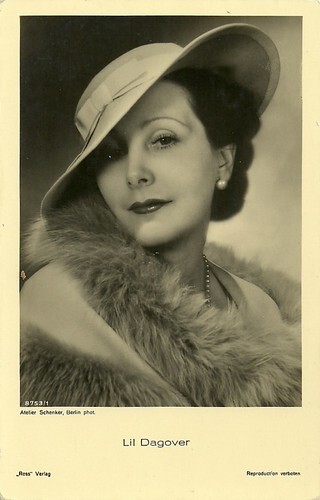
German postcard by Ross Verlag, no. 8753/1, 1933-1934. Photo: Atelier Schenker, Berlin.
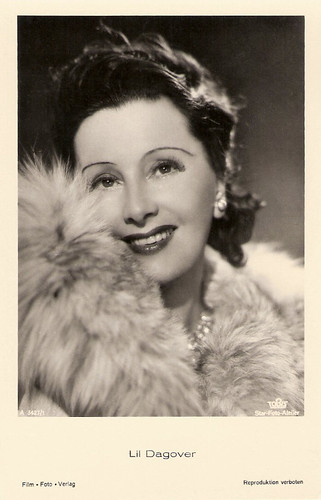
German postcard by Film-Foto-Verlag, no. A 3427/1, 1941-1944. Photo: Star-Foto-Atelier / Tobis.
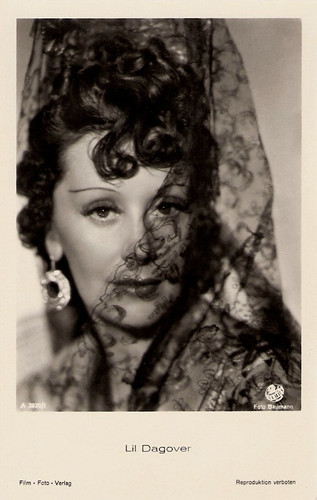
German postcard by Film-Foto-Verlag, no. A 3920/1, 1941-1944. Photo: Baumann / Terra. Lil Dagover in Musik in Salzburg / Music in Salzburg (Herbert Maisch, 1944).
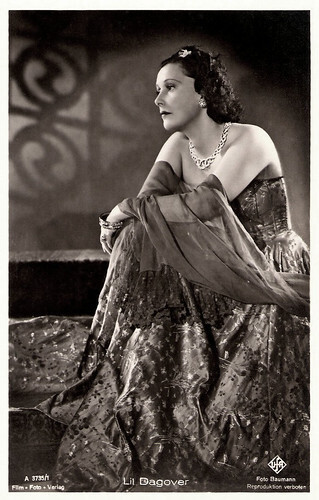
German postcard by Film-Foto-Verlag, no. A 3735/1, 1941-1944. Photo: Baumann.
Sources: Le Giornate del Cinema Muto, Vittorio Martinelli (Portraits of Ladies in 'Cinegrafie 12: Divine Apparitions'), Hans Michael Bock (Filmportal.de - German), Thomas Staedeli (Cyranos), Filmreference.com, Wikipedia (German and English) and .

German postcard by Ross Verlag, Berlin, no. 392/2, 1919-1924. Photo: Atelier Rembrandt, Berlin.

German postcard by Ross Verlag, Berlin, no. 905/1, 1925-1926. Photo: Atelier Schneider, Berlin.

German postcard by Ross Verlag, Berlin, no. 1470/1, 1927-1928. Photo: Angelo Photos.

German postcard by Ross Verlag, Berlin, no. 4027/1, 1929-1930. Photo: Atelier Mahrenholz, Berlin.

German postcard by Ross Verlag, Berlin, no. 5424/1, 1930-1931. Photo: Lola - Kreutzberg - Film.

Italian postcard by Rizzoli, 1940. Photo: Ufa.
Victimised heroine
Lil Dagover was born Maria Antonia Siegelinde Martha Seubert in Madiun on the island of Java in the Dutch East Indies, now Indonesia, in 1887 (some sources say 1894 or 1897). She was the daughter of a forest ranger in the service of the Dutch colonial authorities.
From the age of 10, she was educated in Baden-Baden, Germany. She made her film debut in 1913 as a snake dancer in Schlangentanz / Snake Dance, a documentary by Louis Held. Although she never got acting lessons, she played parts in Die Retterin/The Saviour (Christa Christensen, 1916), Lebendig tot/Living Dead (Alwin Neuss, 1918) and Die Maske / The Mask (Ewald André Dupont, 1919).
In 1917, she married actor Fritz Daghofer, who was 25 years her senior. He introduced her to the directors Robert Wiene and Fritz Lang . The couple divorced in 1919, and the union produced a daughter, Eva Marie, born the year of the divorce. Lil kept her husband's surname but slightly changed it to Dagover. Eva married Hungarian director Géza von Radványi in 1930.
Lil Dagover's career gathered speed with Die Spinnen / The Spiders (Fritz Lang, 1919-1920) and Harakiri (Fritz Lang, 1919). In the latter film, she already impersonated the fine lady whom she usually played in her future films. Next, she appeared in the classic expressionist film Das Cabinet des Dr. Caligari / The Cabinet of Dr. Caligari (Robert Wiene, 1920). In this film, her jet-black hair parted in the middle and flattened to the shape of her head, her long, white face, and her huge, expressive eyes all served to create the archetypal, victimised heroine of the expressionist melodramas.
For Fritz Lang , she played in two more masterpieces, Der müde Tod / Destiny (Fritz Lang, 1921), as a woman begging Death to hand her lover back, and Dr. Mabuse, der Spieler - Ein Bild der Zeit / Dr. Mabuse: the Gambler (Fritz Lang, 1922). She also appeared in two silent classics by Friedrich Wilhelm Murnau , Phantom / The Phantom (F.W. Murnau, 1922) with Alfred Abel , and Tartüff / Tartuffe (F.W. Murnau, 1925) with Emil Jannings , and in Zur Chronik von Grieshuus / At the Grey House (Arthur von Gerlach, 1925).

Spanish postcard by La Novela Semanal Cinematografica, no. 353.

German postcard by Ross Verlag, no. 392/3, 1919-1924. Photo: Atelier Rembrandt.
![Lil Dagover [?] in Der Tänzer (1919)](https://i.gr-assets.com/images/S/compressed.photo.goodreads.com/hostedimages/1759655035i/37279593.jpg)
German postcard by Ross Verlag, no. 632/1, 1919-1924. Photo: Maxim Film. Lil Dagover in Der Tänzer / The Dancer (Carl Froehlich, 1919) and based on the novel by Felix Holländer.

German postcard by Ross Verlag, no. 890/2, 1925-1926. Photo: Decla-Ufa-Film.

German postcard by Ross Verlag, no. 3970/1, 1928-1929. Photo: Ufa.

German postcard by Ross Verlag, no. 4381/1, 1929-30. Photo: E.O. Hoppé, London. Hoppé shot many celebrities on and off the Ufa film sets in Berlin in 1927-1928.

German postcard by Ross Verlag, no. 5249/2, 1930-1931. Photo: Atelier Binder.

German postcard by Ross Verlag, no. 5706/1, 1930-1931. Photo: Atelier Schneider, Berlin.
Salondame
In 1925, Lil Dagover made her stage debut under the direction of Max Reinhardt . In the following years, she played in Reinhardt’s Deutsches Theater in Berlin and also at the Salzburg Festival. Apart from trips to Sweden, France, and Hollywood, most of her career and fate were linked to that of German cinema.
Initially, her role was that of the frail, menaced heroine, but gradually her fine and evanescent beauty changed over time. Film historian Vittorio Martinelli describes in 'Cinegrafie' that "her face became calmer, her figure acquired a harmonious and restful opulence which, together with the natural elegance of her bearing and the constant accuracy of her style of dressing, turned her into a 'Salondame', a lady of the screen."
In 1926, she married producer Georg Witt, who produced many of her following films. Roles in Die Brüder Schellenberg / The Brothers Schellenberg (Karl Grune, 1926) opposite Conrad Veidt , Der geheime Kurier / The Secret Courier (Gennaro Righelli, 1928) with Ivan Mozzhukhin and Ungarische Rhapsodie / Hungarian Rhapsody (Hanns Schwarz, 1928) with Willy Fritsch , were well suited to her new allure.
She also made several films in Sweden for directors Olof Molander and Gustaf Molander and appeared in French silent films. Her last film appearance of the 1920s was in the French silent film Monte Cristo (Henri Fescourt, 1929) opposite Jean Angelo and Marie Glory .
With her theatre experience, she easily survived the coming of sound. In 1930, she made her sound debut in the crime comedy Va Banque (Erich Waschneck, 1930). Her deep voice went down well in such films as the popular operetta Der Kongreß tanzt / The Congress Dances (Erik Charell, 1931). She also visited Hollywood, where she appeared in The Woman from Monte Carlo (Michael Curtiz, 1931) with Walter Huston, shot on location in the United States. It was not a success, and she returned to Germany.

German postcard by Ross Verlag, no. 3143. Photo Decla. Carl de Vogt and Lil Dagover in Die Spinnen, 1. Teil - Der Goldene See (Fritz Lang, 1919). Caption: Decla-Abenteuerklasse "Die Spinnen, 1. Abenteuer "Der Goldene See". (Decla-adventure class "The Spiders", 1st adventure "The Golden Lake".) Sent by mail in 1924.

Swiss-German-British postcard by News Productions, Baulmes / Filmwelt Berlin, Bakede / News Productions, Stroud, no. 56535. Photo: Collection Cinémathèque Suisse, Lausanne. Conrad Veidt and Lil Dagover in Das Kabinett des Dr. Caligari / Das Cabinet des Dr. Caligari (Robert Wiene, 1920), produced by Decla Film, Berlin - Bolz und Cie.

German postcard by Ross Verlag, no. 25/7. Photo: Ufa. Lil Dagover and Paul Hartmann in the German silent film Zur Chronik von Grieshuus / The Chronicles of the Gray House (Arthur von Gerlach, 1925).

French postcard by Film français Aubert, Paris. Photo: Gaston Jacquet and Lil Dagover in Le Tourbillon de Paris / The Maelstrom of Paris (Julien Duvivier, 1928).

German postcard by Ross Verlag, no. 104/5. Photo: Ufa. Willy Fritsch and Lil Dagover in Ungarische Rhapsodie / Hungarian Rhapsody (Hanns Schwarz, 1928).

French postcard by Cinémagazine-Edition, no. 702. Photo: Sofar / Greenbaum-Film. Lil Dagover as Empress Maria Theresia in the period drama La Bague impériale, the French release title of the German film Der Günstling von Schönbrunn (Erich Waschneck, Max Reichmann, 1929), with Ivan Petrovich in the male lead as Colonel Trenck.

German postcard by Ross Verlag, no. 131/7. Photo: Ufa. Conrad Veidt as Count Metternich and Lil Dagover as Countess in Der Kongress tanzt / The Congress dances (Erik Charell, 1931).

German postcard by Ross Verlag, no. A 2260/1, 1939-1940. Photo: Baumann / Ufa. Viktor Staal and Lil Dagover in Umwege zum Glück / Detours to happiness (Fritz Peter Buch, 1939).
War merits cross
Reportedly, Lil Dagover was a close friend of Adolph Hitler. She avoided overt political involvement and generally appeared in popular costume musicals and comedies during World War II. However, she acted in army shows and at war theatres and in 1944 she received the War Merits Cross.
During the Nazi era, she starred in films like the Oscar Wilde adaptation Lady Windermeres Fächer / Lady Windermere's Fan (Heinz Hilpert, 1935), Der Höhere Befehl / The Higher Command (Gerhard Lamprecht, 1935), Schlussakkord / Final Accord (Detlev Sierck (Douglas Sirk), 1936), the first (short) German colour film Das Schönheitsfleckchen / The Little Beauty Mark (Rolf Hansen, 1936), Kreutzersonate / The Kreutzer Sonata (Veit Harlan, 1937) and Bismarck (Wolfgang Liebeneiner, 1940).
She easily continued her career in post-war Germany and acted occasionally on stage and television. She played ‘age parts’ in films like Vom Teufel gejagt/Hunted by the Devil (Victor Tourjansky, 1950), Rosen im Herbst / Roses in Autumn (Rudolf Jugert, 1955), Bekenntnisse des Hochstaplers Felix Krull / Confessions of Felix Krull (Kurt Hoffmann, 1957) and Buddenbrooks / The Buddenbrooks (Alfred Weidenmann, 1959), an adaptation of the Thomas Mann novel with Liselotte Pulver .
A great succès d'estime was her role as an eccentric old woman in the Edgar Wallace adaptation Die seltsame Gräfin / The Strange Countess (Josef von Báky, 1961). The last highlights of the ‘Grande Dame’ comprised the Academy Award-nominated and Golden Globe-winning for Best Foreign-Language Foreign Film of 1974 - Der Fusssgänger / The Pedestrian (Maximilian Schell, 1973), Karl May (Hans-Jürgen Syberberg, 1974), the crime-drama Der Richter und sein Henker / Getting Away with Murder (Maximilian Schell, 1975) with Donald Sutherland, and Geschichten aus dem Wiener Wald / Tales from the Vienna Woods (Maximilian Schell, 1979).
Her film career lasted over half a century, and she won many awards, including the Bundesfilmpreis in 1954 and the Filmband in Gold in 1962. She justly titled her memoirs 'Ich war die Dame' (I was the Lady) in 1979. Lil Dagover died in 1980, in Munich, Germany, at the age of 92. She was buried at the Waldfriedhof Grünwald cemetery in Munich.

German postcard by Ross Verlag, no. 6024/2, 1931-1932. Photo: Atelier Manassé, Wien. Lil Dagover in Elisabeth von Österreich / Elisabeth of Austria (Adolf Trotz, 1931). Collection: Geoffrey Donaldson Institute.

German postcard by Ross Verlag, Berlin, no. 6312/1, 1931-1932. Photo: Elmer Fry.

German postcard by Ross Verlag, Berlin, no. 6777/1, 1931-1932. Photo: Atelier Schenker, Berlin. Collection: Didier Hanson.

German postcard by Ross Verlag, Berlin, no. 7084/1, 1932-1933. Photo: Atelier Kiesel, Berlin.

German postcard by Ross Verlag, no. 8753/1, 1933-1934. Photo: Atelier Schenker, Berlin.

German postcard by Film-Foto-Verlag, no. A 3427/1, 1941-1944. Photo: Star-Foto-Atelier / Tobis.

German postcard by Film-Foto-Verlag, no. A 3920/1, 1941-1944. Photo: Baumann / Terra. Lil Dagover in Musik in Salzburg / Music in Salzburg (Herbert Maisch, 1944).

German postcard by Film-Foto-Verlag, no. A 3735/1, 1941-1944. Photo: Baumann.
Sources: Le Giornate del Cinema Muto, Vittorio Martinelli (Portraits of Ladies in 'Cinegrafie 12: Divine Apparitions'), Hans Michael Bock (Filmportal.de - German), Thomas Staedeli (Cyranos), Filmreference.com, Wikipedia (German and English) and .
Published on October 04, 2025 22:00
October 3, 2025
Cirano di Bergerac (1923)
Tonight, the screening of the Franco-Italian historical film Cirano di Bergerac / Cyrano de Bergerac (1923) will be the opening event of Le Giornate del Cinema Muto or the Pordenone Silent Film Festival. We will follow the 44th Giornate during the whole festival. Director Augusto Genina based his film on Edmond Rostand's often-filmed play 'Cyrano de Bergerac'. Pierre Magnier starred as Cyrano de Bergerac, the gentleman with the unusually long nose, Linda Moglia played his beautiful but unreachable niece Roxane, and Angelo Ferrari played his friend and rival in love, Christian de Neuvillette. Will Cyrano ever find love? Enjoy the festival!
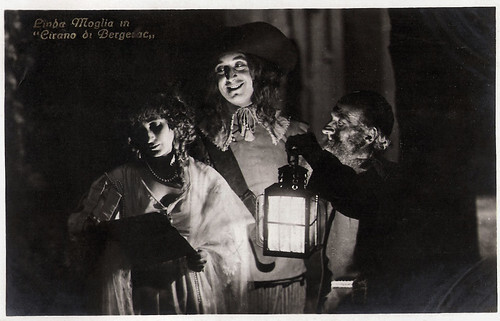
Italian postcard by G.B. Falci, Milano, no. 226. Photo: UCI. Linda Moglia as Roxane and Angelo Ferrari as Christian de Neuvillette in Cirano di Bergerac (Augusto Genina, 1923), based on Edmond Rostand's famous play 'Cyrano de Bergerac'.
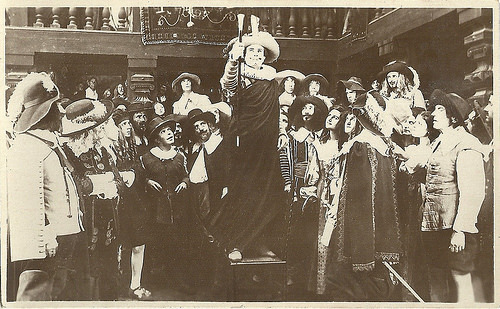
Italian postcard. Photo: UCI. Pierre Magnier as Cyrano de Bergerac in Cirano di Bergerac (Augusto Genina, 1923). Caption: The witty remarks by Cyrano cause for hilarity among the populace present at the theatre.
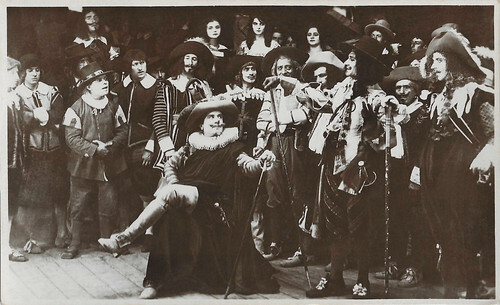
Italian postcard. Photo: UCI. Pierre Magnier as Cyrano de Bergerac in Cirano di Bergerac (Augusto Genina, 1923). Caption: Before the duel.
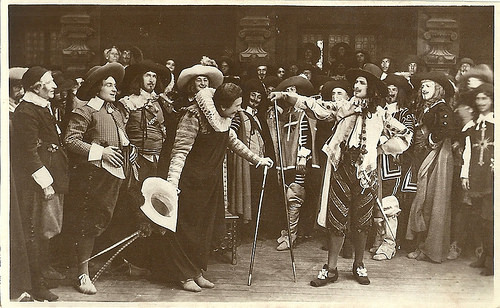
Italian postcard. Photo: UCI. Pierre Magnier as Cyrano de Bergerac in Cirano di Bergerac (Augusto Genina, 1923). Caption: Jokingly, Cyrano ironises the presumptuous Gascogne noble, before duelling with him.
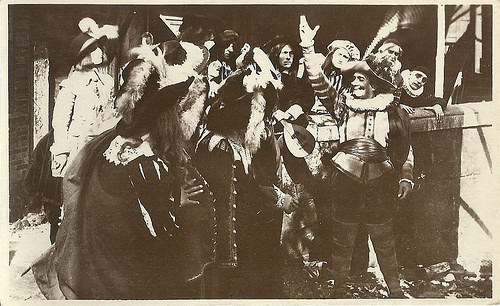
Italian postcard. Photo: UCI. Pierre Magnier as Cyrano de Bergerac in Cirano di Bergerac (Augusto Genina, 1923). Caption: A tale by Cyrano.
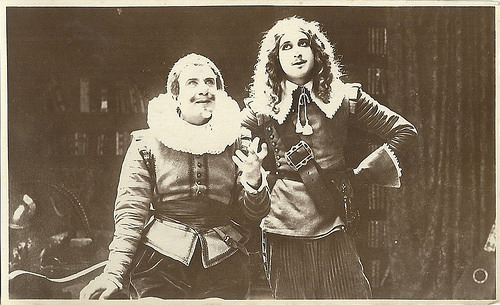
Italian postcard. Photo: UCI. Pierre Magnier as Cyrano de Bergerac and Angelo Ferrari as Christian de Neuvillette in Cirano di Bergerac (Augusto Genina, 1923). Caption: Cyrano addresses to Roxane his most ardent words of love by the lips of Christian, who, incapable of inventing such words, memorises them thanks to Cyrano.
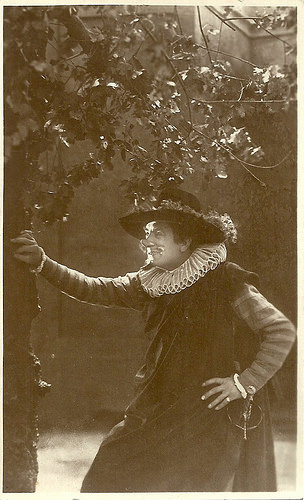
Italian postcard. Photo: UCI. Pierre Magnier as Cyrano de Bergerac in Cirano di Bergerac (Augusto Genina, 1923). Caption: Hidden between the foliage in the garden, Cyrano suggests to Christian the magic, sublime words that the latter isn't capable of inventing and that, aside from Roxane's delicate inhibitions.
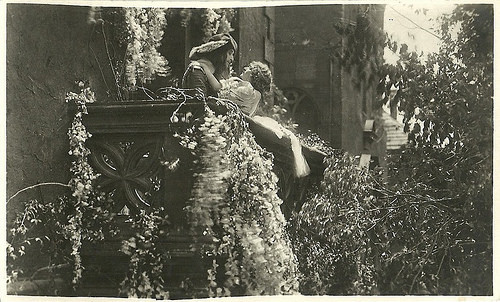
Italian postcard. Photo: UCI. Linda Moglia as Roxane and Angelo Ferrari as Christian de Neuvillette in Cirano di Bergerac (Augusto Genina, 1923). Caption: Christian joins the baluster, finally embracing Roxane. He bends towards her mouth to receive the kiss from her, who has bent because of the sweet words Cyrano lent him.
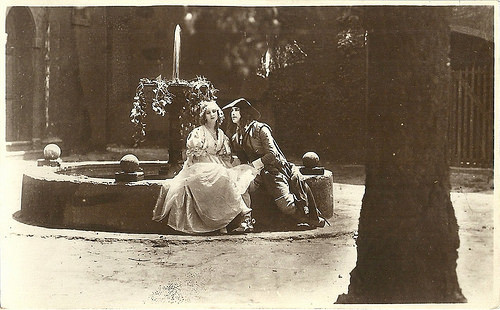
Italian postcard. Photo: UCI. Linda Moglia as Roxane and Angelo Ferrari as Christian de Neuvillette in Cirano di Bergerac (Augusto Genina, 1923). Caption: The nice phrases of Christian he learned from Cyrano, have conquered and seduced Roxane.
A brave and eloquent gentleman doted on an unusually long nose
Cirano di Bergerac / Cyrano de Bergerac (Augusto Genina, 1923) traces the classical story by Edmond Rostand about the strong, witty and eloquent gentleman, a poet, in 17th-century France. Cirano, a leader filled with plenty of charisma and bravado, has only one flaw: an unusually long nose. The play was inspired by a real person, Cyrano de Bergerac, Savinen (1619-1655), an author known for his swordsmanship and large nose, but the play is a fictionalisation of his life that follows the broad outlines of it.
Future film director Mario Camerini wrote the script for the silent film version. Cirano di Bergerac was shot in 1922. French stage and screen actor Pierre Magnier played Cirano di Bergerac (Cyrano de Bergerac). Magnier would act in over 100 films and was also known for La roue (Abel Gance, 1923) and La règle du jeu (Jean Renoir, 1939).
Whoever challenges Cyrano for his nose will meet his sword. As Cyrano cannot have his beautiful niece Roxana (Roxanne) ( Linda Moglia ) because of his looks, he secretly helps young Christian de Neuvillette (Angelo Ferrari) to seduce her using Cyrano's poetic words. Christian and Roxane secretly marry before he goes to war, together with Cyrano. From the camp, Cyrano writes Roxane poetic letters in Christian's name, which increase her love for the young man, so much that she visits the camp and declares to Christian she would even love him if he were not beautiful anymore, hurting Christian's feelings.
Just as Cyrano is about to confess to Roxane his fraud, Christian is shot, and he dies in Roxane's arms, content that Roxane really loves him. Five years later, like always, Cyrano visits Roxane in the convent where she has retired. This day, his old enemies have mortally wounded him, but he covers the wound with his hat. When Cyrano is once more reciting Christian's last letter and can do so from the head, Roxane discovers Cyrano was the true author of all of Christian's poetry and understands. It is too late. Cyrano dies reciting his lines.
In 1923, the film won an award at the Turin festival. Afterwards, the whole film was stencil-coloured in Pathé-color. This took three years to complete, delaying the film's release until 1925. The colouring process involved cutting stencils for each frame of the film, one for each of up to four colours. This was done in Paris by Mme. Marie-Berthe Thuillier, the most famous stencil-colour artist. She projected each frame onto a ground glass screen and traced with a Pantograph. These stencils were then used to apply colours to black-and-white prints in a process similar to silk-screening. Each shot was processed separately, so different colour palettes could be used for each shot. In 1999, this colour version was fully restored by Film Preservation Associates for ARTE, in collaboration with Avid Shepard, and with post-production by Lobster. Kurt Kuenne composed new music, executed by the Olympia Chamber Orchestra led by Timothy Brock.
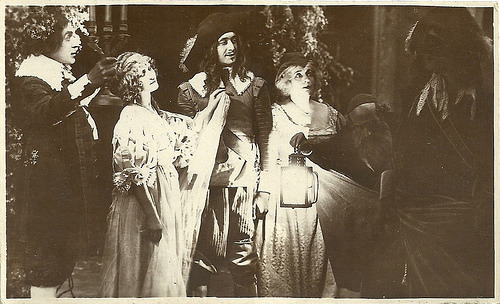
Italian postcard. Photo: UCI. Publicity still for Cirano di Bergerac (Augusto Genina, 1923) with Linda Moglia as Roxane and Angelo Ferrari as Christian de Neuvillette. Caption: Roxane and Christian de Neuvillette marry.
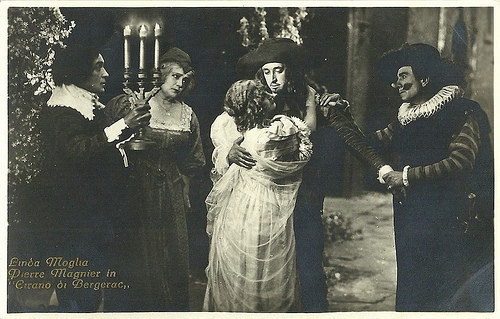
Italian postcard. Photo: UCI. Publicity still for Cirano di Bergerac (Augusto Genina, 1923) with Linda Moglia as Roxane and Pierre Magnier as Cyrano de Bergerac.
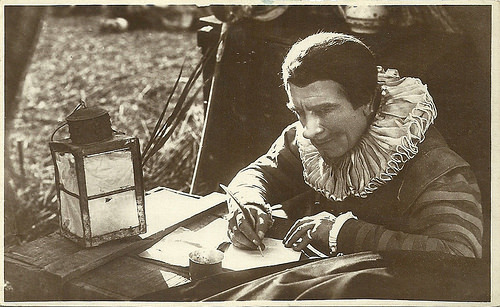
Italian postcard. Photo: UCI. Publicity still for Cirano di Bergerac (Augusto Genina, 1923) with Pierre Magnier as Cyrano de Bergerac. Caption: During the siege of Arras, Cyrano writes to Roxane on behalf of Christian the most ardent words an enamoured heart could have suggested.
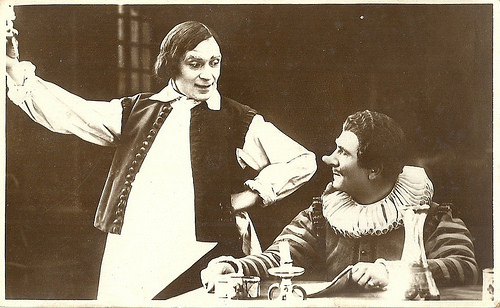
Italian postcard. Photo: UCI. Publicity still for Cirano di Bergerac (Augusto Genina, 1923) with Pierre Magnier as Cyrano de Bergerac. Caption: Cyrano writes...
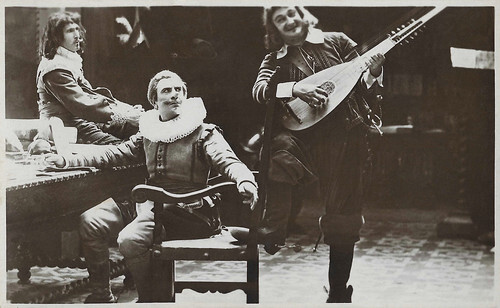
Italian postcard. Photo: UCI. Pierre Magnier as Cyrano de Bergerac in Cirano di Bergerac (Augusto Genina, 1923), based on Edmond Rostand's play 'Cyrano de Bergerac'. Caption: Songs of a distant homeland.
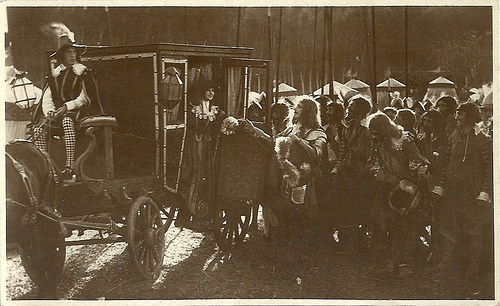
Italian postcard. Photo: UCI. Publicity still for Cirano di Bergerac (Augusto Genina, 1923) with Linda Moglia as Roxane and Angelo Ferrari as Christian de Neuvillette. Caption: Defying danger, Roxane joins Christian at Arras, where he is camping with the soldiers.
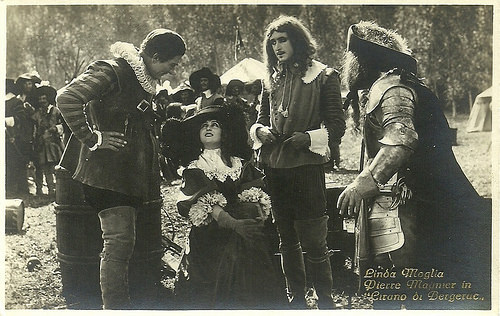
Italian postcard. Photo: UCI. Publicity still for Cirano di Bergerac (Augusto Genina, 1923) with Linda Moglia as Roxane and Pierre Magnier as Cyrano de Bergerac.
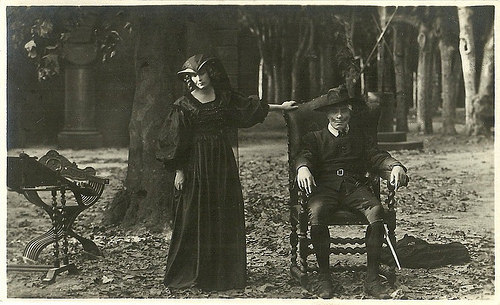
Italian postcard. Photo: UCI. Publicity still for Cirano di Bergerac (Augusto Genina, 1923) with Linda Moglia as Roxane and Pierre Magnier as Cyrano de Bergerac. Caption: A few cronies of the Duke de Guiche have treacherously hit Cyrano. He still has the force to go to his beloved Roxane, and involuntarily, he reveals his heroic sacrifice.
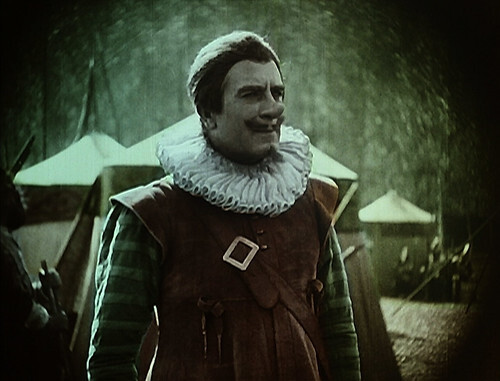
Publicity still for Le Giornate del Cinema Muto 2025. Credit: FPA Classics, Paris. Pierre Magnier in Cirano di Bergerac / Cyrano de Bergerac (Augusto Genina, 1923).
Sources: Wikipedia and IMDb. For those who can't join the festival, a DVD of Cirano di Bergerac has been released by Absolute Medien, together with ARTE.

Italian postcard by G.B. Falci, Milano, no. 226. Photo: UCI. Linda Moglia as Roxane and Angelo Ferrari as Christian de Neuvillette in Cirano di Bergerac (Augusto Genina, 1923), based on Edmond Rostand's famous play 'Cyrano de Bergerac'.

Italian postcard. Photo: UCI. Pierre Magnier as Cyrano de Bergerac in Cirano di Bergerac (Augusto Genina, 1923). Caption: The witty remarks by Cyrano cause for hilarity among the populace present at the theatre.

Italian postcard. Photo: UCI. Pierre Magnier as Cyrano de Bergerac in Cirano di Bergerac (Augusto Genina, 1923). Caption: Before the duel.

Italian postcard. Photo: UCI. Pierre Magnier as Cyrano de Bergerac in Cirano di Bergerac (Augusto Genina, 1923). Caption: Jokingly, Cyrano ironises the presumptuous Gascogne noble, before duelling with him.

Italian postcard. Photo: UCI. Pierre Magnier as Cyrano de Bergerac in Cirano di Bergerac (Augusto Genina, 1923). Caption: A tale by Cyrano.

Italian postcard. Photo: UCI. Pierre Magnier as Cyrano de Bergerac and Angelo Ferrari as Christian de Neuvillette in Cirano di Bergerac (Augusto Genina, 1923). Caption: Cyrano addresses to Roxane his most ardent words of love by the lips of Christian, who, incapable of inventing such words, memorises them thanks to Cyrano.

Italian postcard. Photo: UCI. Pierre Magnier as Cyrano de Bergerac in Cirano di Bergerac (Augusto Genina, 1923). Caption: Hidden between the foliage in the garden, Cyrano suggests to Christian the magic, sublime words that the latter isn't capable of inventing and that, aside from Roxane's delicate inhibitions.

Italian postcard. Photo: UCI. Linda Moglia as Roxane and Angelo Ferrari as Christian de Neuvillette in Cirano di Bergerac (Augusto Genina, 1923). Caption: Christian joins the baluster, finally embracing Roxane. He bends towards her mouth to receive the kiss from her, who has bent because of the sweet words Cyrano lent him.

Italian postcard. Photo: UCI. Linda Moglia as Roxane and Angelo Ferrari as Christian de Neuvillette in Cirano di Bergerac (Augusto Genina, 1923). Caption: The nice phrases of Christian he learned from Cyrano, have conquered and seduced Roxane.
A brave and eloquent gentleman doted on an unusually long nose
Cirano di Bergerac / Cyrano de Bergerac (Augusto Genina, 1923) traces the classical story by Edmond Rostand about the strong, witty and eloquent gentleman, a poet, in 17th-century France. Cirano, a leader filled with plenty of charisma and bravado, has only one flaw: an unusually long nose. The play was inspired by a real person, Cyrano de Bergerac, Savinen (1619-1655), an author known for his swordsmanship and large nose, but the play is a fictionalisation of his life that follows the broad outlines of it.
Future film director Mario Camerini wrote the script for the silent film version. Cirano di Bergerac was shot in 1922. French stage and screen actor Pierre Magnier played Cirano di Bergerac (Cyrano de Bergerac). Magnier would act in over 100 films and was also known for La roue (Abel Gance, 1923) and La règle du jeu (Jean Renoir, 1939).
Whoever challenges Cyrano for his nose will meet his sword. As Cyrano cannot have his beautiful niece Roxana (Roxanne) ( Linda Moglia ) because of his looks, he secretly helps young Christian de Neuvillette (Angelo Ferrari) to seduce her using Cyrano's poetic words. Christian and Roxane secretly marry before he goes to war, together with Cyrano. From the camp, Cyrano writes Roxane poetic letters in Christian's name, which increase her love for the young man, so much that she visits the camp and declares to Christian she would even love him if he were not beautiful anymore, hurting Christian's feelings.
Just as Cyrano is about to confess to Roxane his fraud, Christian is shot, and he dies in Roxane's arms, content that Roxane really loves him. Five years later, like always, Cyrano visits Roxane in the convent where she has retired. This day, his old enemies have mortally wounded him, but he covers the wound with his hat. When Cyrano is once more reciting Christian's last letter and can do so from the head, Roxane discovers Cyrano was the true author of all of Christian's poetry and understands. It is too late. Cyrano dies reciting his lines.
In 1923, the film won an award at the Turin festival. Afterwards, the whole film was stencil-coloured in Pathé-color. This took three years to complete, delaying the film's release until 1925. The colouring process involved cutting stencils for each frame of the film, one for each of up to four colours. This was done in Paris by Mme. Marie-Berthe Thuillier, the most famous stencil-colour artist. She projected each frame onto a ground glass screen and traced with a Pantograph. These stencils were then used to apply colours to black-and-white prints in a process similar to silk-screening. Each shot was processed separately, so different colour palettes could be used for each shot. In 1999, this colour version was fully restored by Film Preservation Associates for ARTE, in collaboration with Avid Shepard, and with post-production by Lobster. Kurt Kuenne composed new music, executed by the Olympia Chamber Orchestra led by Timothy Brock.

Italian postcard. Photo: UCI. Publicity still for Cirano di Bergerac (Augusto Genina, 1923) with Linda Moglia as Roxane and Angelo Ferrari as Christian de Neuvillette. Caption: Roxane and Christian de Neuvillette marry.

Italian postcard. Photo: UCI. Publicity still for Cirano di Bergerac (Augusto Genina, 1923) with Linda Moglia as Roxane and Pierre Magnier as Cyrano de Bergerac.

Italian postcard. Photo: UCI. Publicity still for Cirano di Bergerac (Augusto Genina, 1923) with Pierre Magnier as Cyrano de Bergerac. Caption: During the siege of Arras, Cyrano writes to Roxane on behalf of Christian the most ardent words an enamoured heart could have suggested.

Italian postcard. Photo: UCI. Publicity still for Cirano di Bergerac (Augusto Genina, 1923) with Pierre Magnier as Cyrano de Bergerac. Caption: Cyrano writes...

Italian postcard. Photo: UCI. Pierre Magnier as Cyrano de Bergerac in Cirano di Bergerac (Augusto Genina, 1923), based on Edmond Rostand's play 'Cyrano de Bergerac'. Caption: Songs of a distant homeland.

Italian postcard. Photo: UCI. Publicity still for Cirano di Bergerac (Augusto Genina, 1923) with Linda Moglia as Roxane and Angelo Ferrari as Christian de Neuvillette. Caption: Defying danger, Roxane joins Christian at Arras, where he is camping with the soldiers.

Italian postcard. Photo: UCI. Publicity still for Cirano di Bergerac (Augusto Genina, 1923) with Linda Moglia as Roxane and Pierre Magnier as Cyrano de Bergerac.

Italian postcard. Photo: UCI. Publicity still for Cirano di Bergerac (Augusto Genina, 1923) with Linda Moglia as Roxane and Pierre Magnier as Cyrano de Bergerac. Caption: A few cronies of the Duke de Guiche have treacherously hit Cyrano. He still has the force to go to his beloved Roxane, and involuntarily, he reveals his heroic sacrifice.

Publicity still for Le Giornate del Cinema Muto 2025. Credit: FPA Classics, Paris. Pierre Magnier in Cirano di Bergerac / Cyrano de Bergerac (Augusto Genina, 1923).
Sources: Wikipedia and IMDb. For those who can't join the festival, a DVD of Cirano di Bergerac has been released by Absolute Medien, together with ARTE.
Published on October 03, 2025 22:00
October 2, 2025
Animal Crackers
Tomorrow, 4 October 2025, it is World Animal Day for the 100th time. The World Animal Day 2025 theme is… 'Save Animals, Save the Planet!' For the occasion, we selected 18 postcards with different animals and film stars. And some of the animals were film stars too!
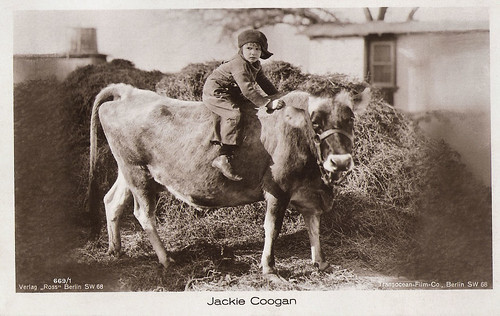
German postcard by Ross Verlag, no. 669/1, 1919-1924. Photo: Transocean-Film-Co., Berlin. A cow with Jackie Coogan in Daddy (1923).
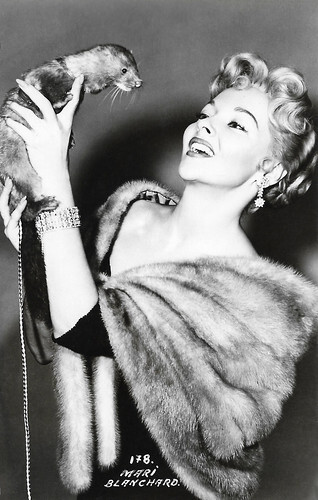
Spanish postcard, no. 178. A Mink with Mari Blanchard .
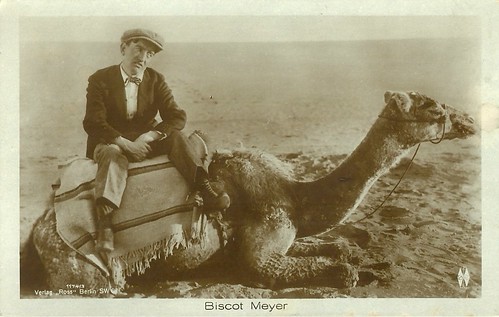
German postcard by Ross Verlag, Berlin, no. 1174/3, 1927-1928. A Dromedary and Georges Biscot , presented in Germany as 'Biscot Meyer', in L'orpheline / The orphan (Louis Feuillade, 1921).
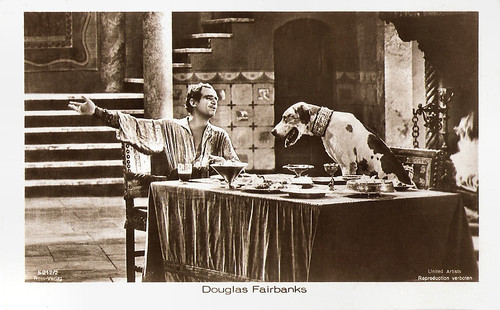
German postcard by Ross-Verlag, no. 5212/2, 1930-1931. Photo: K.O. Rahmn (Knut Olaf Rahmn) / United Artists. A Great Dane and Douglas Fairbanks in The Taming of the Shrew (Sam Taylor, 1930).
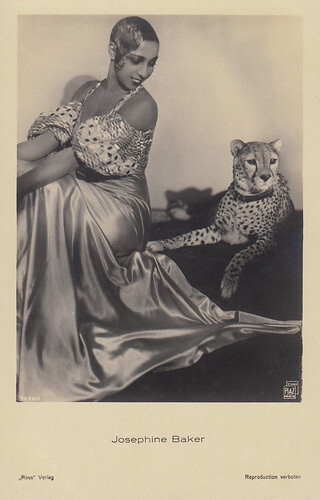
German postcard by Ross Verlag, no. 7426/1, 1932-1933. Photo: Studio Piaz. Collection: Marlene Pilaete. Josephine Baker with Chiquita, her pet Cheetah.
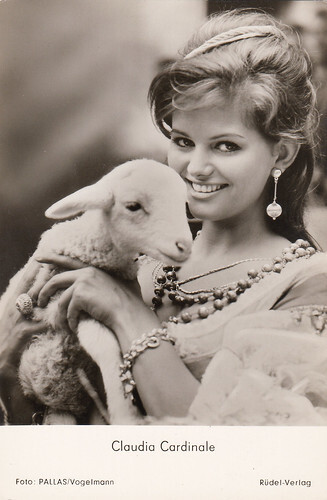
German postcard by Rüdel Verlag, no. 3561. Photo: PALLAS / Vogelmann. A Lamb and Claudia Cardinale in Cartouche (Philippe de Broca, 1962). Collection: Marlene Pilaete.

American postcard by Fotofolio, NY, NY, no. P 348. Photo: Phil Stern. Monkeys and Peter Finch in The Flight of the Phoenix (Robert Aldrich, 1965).
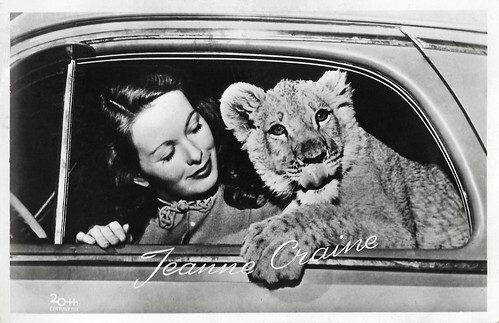
Dutch postcard, no. 3430. Sent by mail in 1950. Photo: 20th Century Fox. Jeanne Crain with her pet Lion, Shah-Shah. Crain later gave the lion to the Los Angeles Zoo. Her surname is mistakenly written here as Craine.
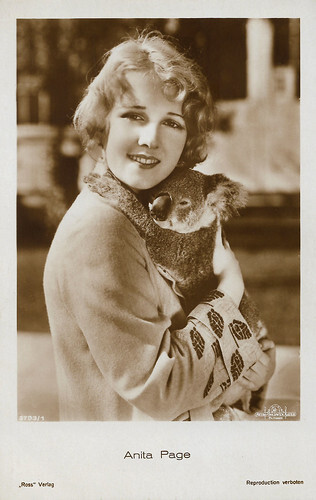
German postcard by Ross Verlag, no. 3793/1, 1928-1929. Photo: Metro-Goldwyn-Mayer. A Koala Bear with Anita Page .
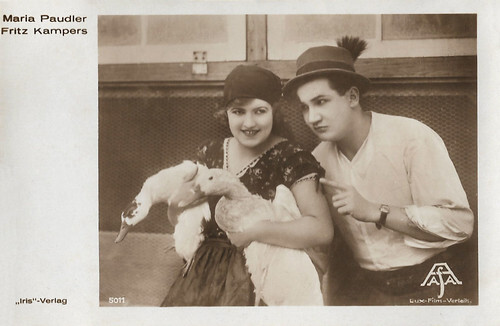
Austrian postcard by Iris-Verlag, no. 5011. Photo: AAFA Film / Lux Film-Verleih. Two Geese and Maria Paudler and Fritz Kampers in Heiratsfieber / Marriage Fever (Rudolf Walther-Fein, 1928).
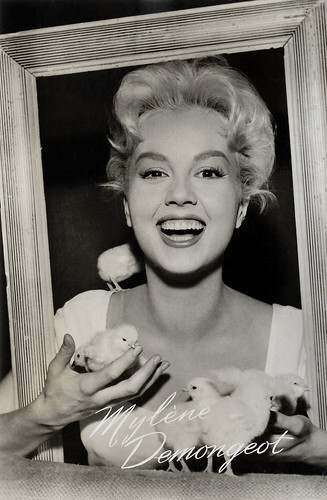
Dutch postcard by Uitg. Takken, Utrecht, no. AX 3864. Chicks and Mylène Demongeot .
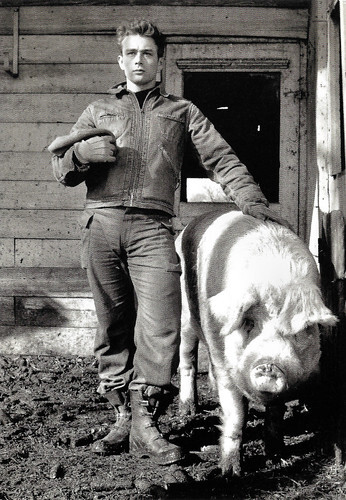
French postcard by Grafique de France, no. SC 109. Photo: Dennis Stock, 1954. A Pig and James Dean . Dean asked Stock to accompany him to his family's farm in Fairmount, Indiana to celebrate his birthday. The photo was published in Life Magazine in 1955. Dennis Stock called this photo 'Ferrotype With Sow' because it reminded him of the old tintype pictures they used to take when photography was in its infancy.
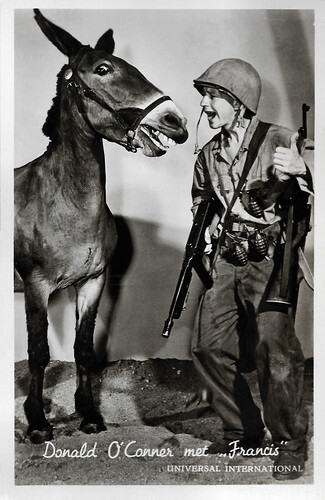
Belgian postcard by Nieuwe Merksemsche Chocolaterie S.P.R.L, Merksem (Anvers), no. B 16. Photo: Universal International. Francis the Talking Mule and Donald O'Connor in Francis in the Navy (Arthur Lubin, 1955).
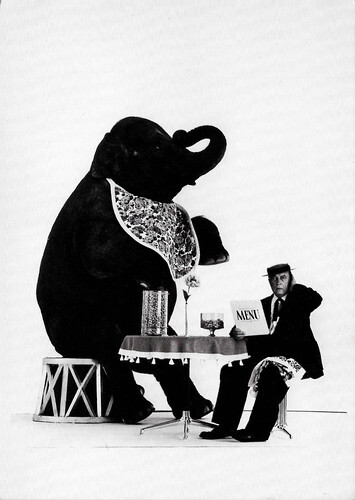
American postcard by Fotofolio, NY, NY, no. P148. Photo: Sid Avery, 1964. Bimbo the Elephant and Buster Keaton . The photo was made for an ad for US Steel.
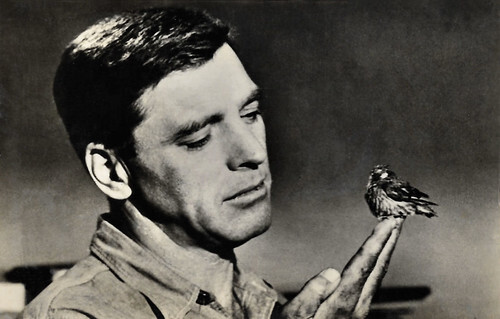
Czech collector card by Pressfoto, Praha, no. S 37.8. A Sparrow and Burt Lancaster in Birdman of Alcatraz (John Frankenheimer, 1962).
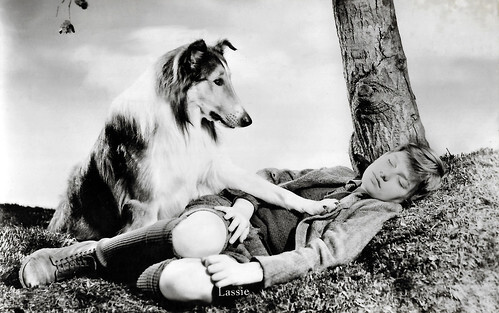
Dutch postcard by Gebr. Spanjersberg N.V., Rotterdam. Pal and Roddy McDowall in Lassie Come Home (Fred M. Wilcox, 1943).
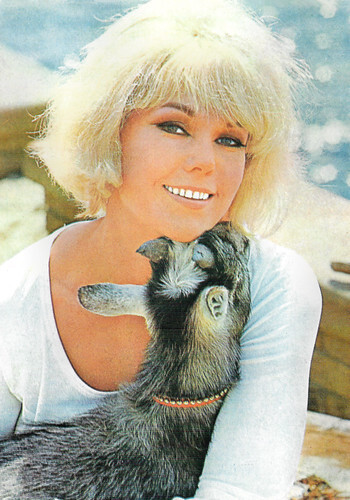
Romanian postcard by Casa Filmului Acin. A Goat and Kim Novak .
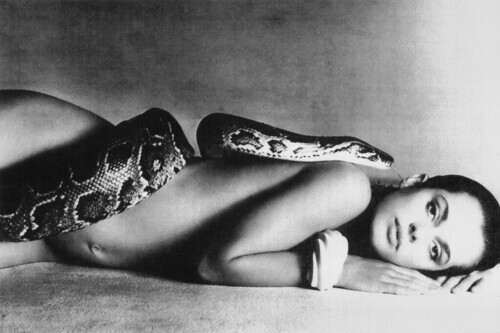
British postcard in the Photographs series, no. 101. Photo: Richard Avedon. A boa constrictor and Nastassja Kinski . The photo title is 'Nastassja and the Serpent'.
"According to American Vogue stylist Polly Mellen, the arrival of a snake on set was an unexpected turn of events. “We were in Los Angeles, and the shoot had already started. We were just doing fashion pictures,” she recalls in the 2001 documentary In Vogue: The Editor’s Eye. Looking for something to give the images a little extra kick, she asked model Nastassja Kinski if she had any ideas. Kinski’s reply? A boa constrictor. Naturally.
In 1981, Kinski was at the height of her career, modelling for the world’s leading fashion titles and appearing on screen for cutting-edge auteurs from Polanski to Wim Wenders. The legendary Richard Avedon had been charged by editor-in-chief Diana Vreeland with capturing the woman of the moment: following his blockbuster 1977 show at the Metropolitan Museum of Art, the largest photographic retrospective the institution had ever staged, Avedon was arguably America’s most famous lensman.
The creative alchemy between these two industry titans would produce one of the most referenced fashion images ever, most recently recreated by Patrick Demarchelier and Jennifer Lawrence for Vanity Fair. Swiftly put into production by Condé Nast as a poster, Nastassja and the Serpent became ubiquitous as the décor feature of choice for any testosterone-fuelled 80s college dorm.
“What I find interesting is that you have this incredibly famous male photographer, so you assume that he’s in control and calling the shots,” explains Sotheby’s Head of Photographs, Brandei Estes. “But then here’s this 21-year-old sex symbol saying, let’s do it with a snake and in the nude. Kinski was completely calm and in control and professional, even as she lay on cold concrete for hours with the snake hooked around her feet.”"
Source: Liam Hess (AnOther).
Please also check out EFSP's Animal House.

German postcard by Ross Verlag, no. 669/1, 1919-1924. Photo: Transocean-Film-Co., Berlin. A cow with Jackie Coogan in Daddy (1923).

Spanish postcard, no. 178. A Mink with Mari Blanchard .

German postcard by Ross Verlag, Berlin, no. 1174/3, 1927-1928. A Dromedary and Georges Biscot , presented in Germany as 'Biscot Meyer', in L'orpheline / The orphan (Louis Feuillade, 1921).

German postcard by Ross-Verlag, no. 5212/2, 1930-1931. Photo: K.O. Rahmn (Knut Olaf Rahmn) / United Artists. A Great Dane and Douglas Fairbanks in The Taming of the Shrew (Sam Taylor, 1930).

German postcard by Ross Verlag, no. 7426/1, 1932-1933. Photo: Studio Piaz. Collection: Marlene Pilaete. Josephine Baker with Chiquita, her pet Cheetah.

German postcard by Rüdel Verlag, no. 3561. Photo: PALLAS / Vogelmann. A Lamb and Claudia Cardinale in Cartouche (Philippe de Broca, 1962). Collection: Marlene Pilaete.

American postcard by Fotofolio, NY, NY, no. P 348. Photo: Phil Stern. Monkeys and Peter Finch in The Flight of the Phoenix (Robert Aldrich, 1965).

Dutch postcard, no. 3430. Sent by mail in 1950. Photo: 20th Century Fox. Jeanne Crain with her pet Lion, Shah-Shah. Crain later gave the lion to the Los Angeles Zoo. Her surname is mistakenly written here as Craine.

German postcard by Ross Verlag, no. 3793/1, 1928-1929. Photo: Metro-Goldwyn-Mayer. A Koala Bear with Anita Page .

Austrian postcard by Iris-Verlag, no. 5011. Photo: AAFA Film / Lux Film-Verleih. Two Geese and Maria Paudler and Fritz Kampers in Heiratsfieber / Marriage Fever (Rudolf Walther-Fein, 1928).

Dutch postcard by Uitg. Takken, Utrecht, no. AX 3864. Chicks and Mylène Demongeot .

French postcard by Grafique de France, no. SC 109. Photo: Dennis Stock, 1954. A Pig and James Dean . Dean asked Stock to accompany him to his family's farm in Fairmount, Indiana to celebrate his birthday. The photo was published in Life Magazine in 1955. Dennis Stock called this photo 'Ferrotype With Sow' because it reminded him of the old tintype pictures they used to take when photography was in its infancy.

Belgian postcard by Nieuwe Merksemsche Chocolaterie S.P.R.L, Merksem (Anvers), no. B 16. Photo: Universal International. Francis the Talking Mule and Donald O'Connor in Francis in the Navy (Arthur Lubin, 1955).

American postcard by Fotofolio, NY, NY, no. P148. Photo: Sid Avery, 1964. Bimbo the Elephant and Buster Keaton . The photo was made for an ad for US Steel.

Czech collector card by Pressfoto, Praha, no. S 37.8. A Sparrow and Burt Lancaster in Birdman of Alcatraz (John Frankenheimer, 1962).

Dutch postcard by Gebr. Spanjersberg N.V., Rotterdam. Pal and Roddy McDowall in Lassie Come Home (Fred M. Wilcox, 1943).

Romanian postcard by Casa Filmului Acin. A Goat and Kim Novak .

British postcard in the Photographs series, no. 101. Photo: Richard Avedon. A boa constrictor and Nastassja Kinski . The photo title is 'Nastassja and the Serpent'.
"According to American Vogue stylist Polly Mellen, the arrival of a snake on set was an unexpected turn of events. “We were in Los Angeles, and the shoot had already started. We were just doing fashion pictures,” she recalls in the 2001 documentary In Vogue: The Editor’s Eye. Looking for something to give the images a little extra kick, she asked model Nastassja Kinski if she had any ideas. Kinski’s reply? A boa constrictor. Naturally.
In 1981, Kinski was at the height of her career, modelling for the world’s leading fashion titles and appearing on screen for cutting-edge auteurs from Polanski to Wim Wenders. The legendary Richard Avedon had been charged by editor-in-chief Diana Vreeland with capturing the woman of the moment: following his blockbuster 1977 show at the Metropolitan Museum of Art, the largest photographic retrospective the institution had ever staged, Avedon was arguably America’s most famous lensman.
The creative alchemy between these two industry titans would produce one of the most referenced fashion images ever, most recently recreated by Patrick Demarchelier and Jennifer Lawrence for Vanity Fair. Swiftly put into production by Condé Nast as a poster, Nastassja and the Serpent became ubiquitous as the décor feature of choice for any testosterone-fuelled 80s college dorm.
“What I find interesting is that you have this incredibly famous male photographer, so you assume that he’s in control and calling the shots,” explains Sotheby’s Head of Photographs, Brandei Estes. “But then here’s this 21-year-old sex symbol saying, let’s do it with a snake and in the nude. Kinski was completely calm and in control and professional, even as she lay on cold concrete for hours with the snake hooked around her feet.”"
Source: Liam Hess (AnOther).
Please also check out EFSP's Animal House.
Published on October 02, 2025 22:00
October 1, 2025
EFSP's 10 most-viewed blogs since 2010
You may have noticed that the number of page views for this blog is now displayed in two rows. Earlier this week, EFSP passed 10 million page views - since January 2010, when Blogger started counting. For those who enjoy statistics, EFSP had 267,964 page views last month. A new record.
We, Ivo Blom and Paul van Yperen, started this blog in 2008 at a time when blogs were in vogue. Interesting and quirky blogs were popping up like mushrooms, purely for the fun of creating in cyberspace. Now, in 2025, European Film Star Postcards is one of the last of its kind. But just like Asterix and his Gaulish village, we are holding our own in an increasingly commercial online world.
We are happy to continue EFSP. And we are lucky we can do this without advertisements, a paywall or a fundraising campaign, and with friends who write amazing guest posts, like our special guest star Marlene 'La Collectionneuse' Pilaete, others who correct our mistakes like Erhanizzet Oncel, or who share their postcard collections with us, like Egbert Barten, founder of the Geoffrey Donaldson Institute. Thank you! We are also grateful for all the creators of the sources we can (still) use freely and, of course, we salute the publishers, filmmakers, photographers and film stars for their wonderful postcards.
For this special occasion, we selected the 10 most-viewed blog posts since January 2010.
On 31 January 2014, EFSP posted an I.M. for Lebanese actress and former belly dancer Aïché Nana (1940-2014), two days after her death. In 1958, a 'striptease' by the then 18-year-old Nana at a Roman party caused an international scandal. Subsequently, she became one of the icons of ‘La Dolce Vita’, the liberated era of sex, drugs and rock & roll as documented by Federico Fellini. Aïché Nana appeared in 15 European films between 1956 and 1985. Her post was viewed 8.580 times.
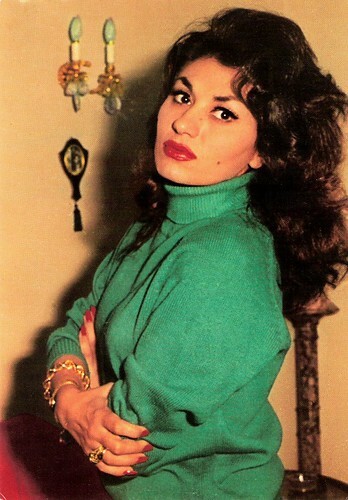
Italian postcard by Rotalcolor, Milano (Milan), no. 238.
Number 9: 11 German directors of the silent era
During the 14 years which comprise the Weimar period, the German film industry enjoyed an unprecedented development. Each year, an average of 250 films were produced, and about 230 film companies were active in Berlin alone. This month, we will focus on the men and women who directed these films. The most famous directors in this industry were Fritz Lang, Friedrich Wilhelm Murnau and Ernst Lubitsch, who all later had success in Hollywood and about whom we posted before. On 8 May 2024, EFSP presented 11 directors who were less famous but who all made several interesting silent films during the 1910s and 1920s. The first director in the post was Fern Andra (1893-1974). She became one of the most popular film stars of German cinema in the 1910s and early 1920s. In 1913, aged 19, she appeared in her first German film, Das Ave Maria / The Ave Maria (Charles Decroix, 1913). Soon, she started her own company, even directing her own films. Georg Glen was the manager of her studio, Fern Andra Atelier. The company produced more than 80 films during World War I. This post was viewed 8.820 times.
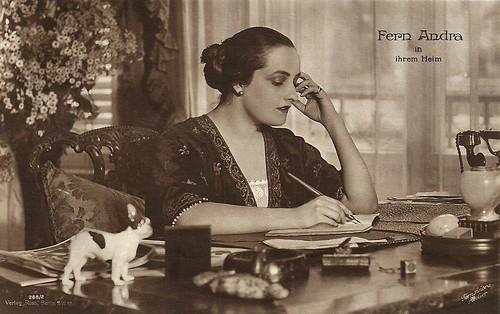
German postcard by Ross Verlag, Berlin, no. 288/2, 1919-1924. Photo: Fern Andra Atelier. Caption: Fern Andra in ihrem Heim (Fern Andra at her home).
Number 8: Claudia Cardinale (1938-2025) - Part 1
One of Europe's iconic and most versatile film stars was Italian actress Claudia Cardinale (1938-2025). The combination of her beauty, dark, flashing eyes, explosive sexuality and genuine acting talent virtually guaranteed her stardom. Her most notable films include the classics 8½ (Federico Fellini, 1963), Il Gattopardo (Luchino Visconti, 1963), and Once Upon a Time in the West (Sergio Leone, 1968). One post was not enough to commemorate La CC, and Part 2 followed the next day. We updated the post for her death earlier this year, but the original version was published on 1 July 2010 and had 9,960 page views.
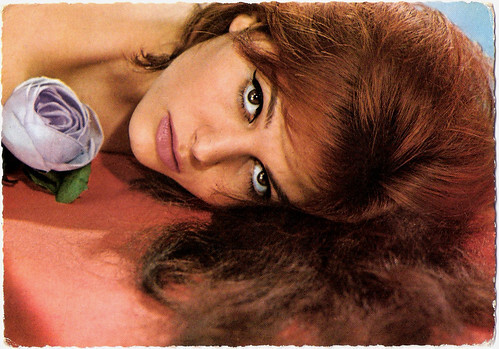
French postcard by E.D.U.G., no. 316. Photo: Sam Lévin.
Number 7: Bud Spencer
An I.M. for Bud Spencer (1929-2016) on 10 July 2016 had 10,704 page views. The huge Italian actor with his trademark black beard was the popular star of many Spaghetti Westerns and low-budget action films of the late 1960s and 1970s. In 18 films, he co-starred with his long-time film partner Terence Hill. In his youth, Spencer (then: Carlo Pedersoli) was the first Italian to swim 100 metres in less than a minute. He also had a law degree, and he registered several patents.
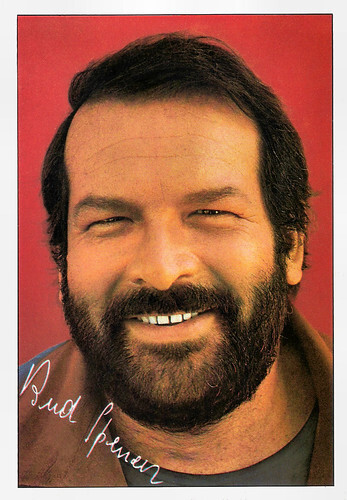
German autograph card by BRAVO.
Number 6: Lupu Pick
Lupu Pick (1886-1931) was a Romanian-German actor, film director, producer, and screenwriter of the silent era. His style as a director differed substantially from the macabre, expressionist fantasies prevalent in German cinema at the time. Together with screenwriter Carl Mayer, he introduced Kammerspielfilme (chamber drama films), intimate psychological dramas about ordinary people in extraordinary circumstances. In the mid-1920s, he briefly returned to acting and then made several films in England and France. Our post on 28 November 2024 was viewed 10.800 times.
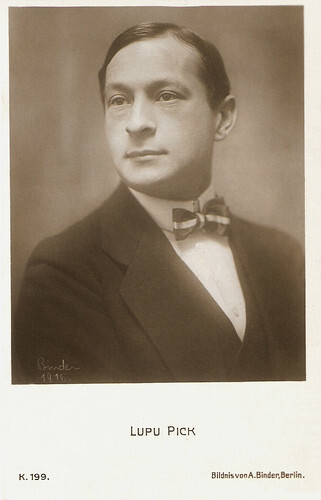
German postcard by Verlag Photochemie, Berlin, no. K. 199. Photo: Alex Binder, 1916.
Number 5: Marina Vlady
Sensual and alluring French star Marina Vlady (1938) had the makings of just another blonde bombshell, but in 1963, she stunned everybody with her performance in L’Ape Regine / The Conjugal Bed. At the Cannes Film Festival, the feline beauty won that year the Golden Palm for Best Actress. The post on 7 July 2012 counted 13,600 page views.
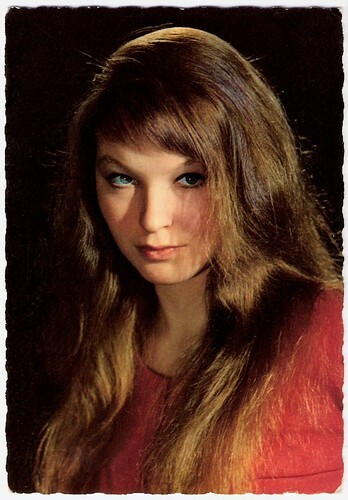
French postcard by E.D.U.G., no. 74. Photo: Sam Levin.
Number 4: Martine Carol
One of the French cinema's most beautiful women was Martine Carol (1920-1967). During the early 1950s, the French sex symbol was a top box office draw as an elegant blonde seductress in many films and was often compared to Marilyn Monroe. Her private life was filled with turmoil, including a suicide attempt, drug abuse, a kidnapping, and her mysterious death at only 46. Her post, last updated on 21 February 2022, is a continuing success and has 16,200 page views.
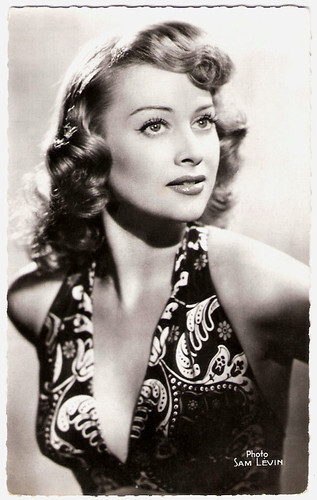
French postcard by Editions du Globe (E.D.U.G.), Paris, no. 132. Photo: Sam Lévin.
Number 3: Italian postcards by Cines-Pittaluga
In 2019, Ivo Blom acquired a great series of Italian postcards from the early 1930s at the Il Cinema Ritrovato Book Fair in Bologna. All the postcards were published by the film company Cines-Pittaluga to promote their own films. The head of this company, Stefano Pittaluga (1887-1932), helped revive Italian film production in the late 1920s and early 1930s. In 1926, he acquired the pioneering film studio Cines from the conglomerate Unione Cinematografica Italiana. Cines produced the first Italian sound film, La canzone dell'amore / The Song of Love (1930), and became the dominant force of the early sound era. Under Pittaluga, the company specialised in musicals and comedies, of which many were later branded 'Telefoni Bianchi' (White Telephone films).
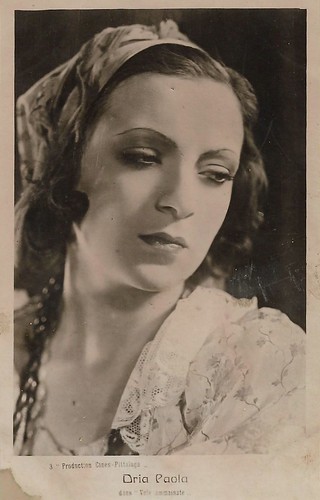
Italian postcard by Cines-Pittaluga, no. 3. Photo: Cines-Pittaluga. Dria Paola in Vele ammainate / Lowered Sails (Anton Giulio Bragaglia, 1931).
Number 2: Sepia postcards by Cinémagazine
This 'New acquisitions' post on 14 Sept 2019 was viewed 24.600 times since then. In 2019, Ivo Blom bought a series of sepia postcards of silent film stars published by Editions Cinémagazine in Paris. Cinémagazine-Edition, or just CE, was the publisher of the film magazine of the same name, which was popular all over Europe. It was a weekly magazine that existed between 1921 and 1935. Charles Ray (1891-1943) was an American actor, scriptwriter, and director of the silent screen, who knew a parable from rags to riches and back again, working for e.g. Paramount, his own company, United Artists and MGM. In the late 1910s and early 1920s, he was a very popular actor and one of Hollywood's best-paid stars.
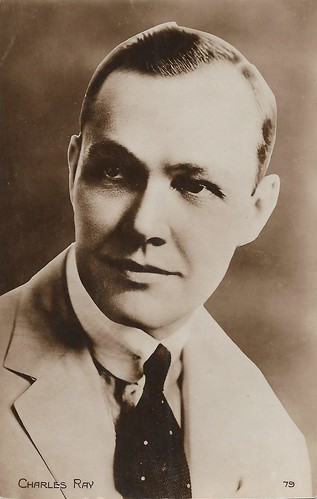
French postcard by Editions Cinémagazine, no. 79. Photo: not indicated but could be made by Evans.
Number 1: Alain Delon (1935-2024)
On 18 August 2024, French film star Alain Delon (1935) died at the age of 88. A day later, we had updated a post about this breathtakingly good-looking 'James Dean of European cinema' in the late 1950s and early 1960s. He proved in such films as Plein soleil / Purple Noon (René Clément, 1960) Rocco e i suoi fratelli / Rocco and his brothers (Luchino Visconti, 1960) and L'eclisse/The Eclipse (Michelangelo Antonioni, 1962) that he was also a magnificent actor. Delon later starred in a series of popular gangster films by directors like Henri Verneuil, Jacques Deray and Jean-Pierre Melville.
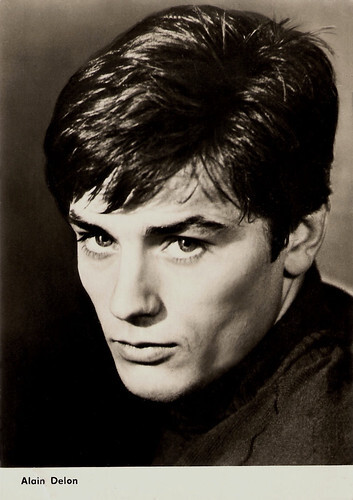
East German postcard by VEB Progress Film-Vertrieb, Berlin, 1967. Retail price: 0,20 MDN. Photo: Alain Delon in Rocco e i suoi fratelli / Rocco and his brothers (Luchino Visconti, 1960).
And thank you for visiting us. We love your comments.
We, Ivo Blom and Paul van Yperen, started this blog in 2008 at a time when blogs were in vogue. Interesting and quirky blogs were popping up like mushrooms, purely for the fun of creating in cyberspace. Now, in 2025, European Film Star Postcards is one of the last of its kind. But just like Asterix and his Gaulish village, we are holding our own in an increasingly commercial online world.
We are happy to continue EFSP. And we are lucky we can do this without advertisements, a paywall or a fundraising campaign, and with friends who write amazing guest posts, like our special guest star Marlene 'La Collectionneuse' Pilaete, others who correct our mistakes like Erhanizzet Oncel, or who share their postcard collections with us, like Egbert Barten, founder of the Geoffrey Donaldson Institute. Thank you! We are also grateful for all the creators of the sources we can (still) use freely and, of course, we salute the publishers, filmmakers, photographers and film stars for their wonderful postcards.
For this special occasion, we selected the 10 most-viewed blog posts since January 2010.
On 31 January 2014, EFSP posted an I.M. for Lebanese actress and former belly dancer Aïché Nana (1940-2014), two days after her death. In 1958, a 'striptease' by the then 18-year-old Nana at a Roman party caused an international scandal. Subsequently, she became one of the icons of ‘La Dolce Vita’, the liberated era of sex, drugs and rock & roll as documented by Federico Fellini. Aïché Nana appeared in 15 European films between 1956 and 1985. Her post was viewed 8.580 times.

Italian postcard by Rotalcolor, Milano (Milan), no. 238.
Number 9: 11 German directors of the silent era
During the 14 years which comprise the Weimar period, the German film industry enjoyed an unprecedented development. Each year, an average of 250 films were produced, and about 230 film companies were active in Berlin alone. This month, we will focus on the men and women who directed these films. The most famous directors in this industry were Fritz Lang, Friedrich Wilhelm Murnau and Ernst Lubitsch, who all later had success in Hollywood and about whom we posted before. On 8 May 2024, EFSP presented 11 directors who were less famous but who all made several interesting silent films during the 1910s and 1920s. The first director in the post was Fern Andra (1893-1974). She became one of the most popular film stars of German cinema in the 1910s and early 1920s. In 1913, aged 19, she appeared in her first German film, Das Ave Maria / The Ave Maria (Charles Decroix, 1913). Soon, she started her own company, even directing her own films. Georg Glen was the manager of her studio, Fern Andra Atelier. The company produced more than 80 films during World War I. This post was viewed 8.820 times.

German postcard by Ross Verlag, Berlin, no. 288/2, 1919-1924. Photo: Fern Andra Atelier. Caption: Fern Andra in ihrem Heim (Fern Andra at her home).
Number 8: Claudia Cardinale (1938-2025) - Part 1
One of Europe's iconic and most versatile film stars was Italian actress Claudia Cardinale (1938-2025). The combination of her beauty, dark, flashing eyes, explosive sexuality and genuine acting talent virtually guaranteed her stardom. Her most notable films include the classics 8½ (Federico Fellini, 1963), Il Gattopardo (Luchino Visconti, 1963), and Once Upon a Time in the West (Sergio Leone, 1968). One post was not enough to commemorate La CC, and Part 2 followed the next day. We updated the post for her death earlier this year, but the original version was published on 1 July 2010 and had 9,960 page views.

French postcard by E.D.U.G., no. 316. Photo: Sam Lévin.
Number 7: Bud Spencer
An I.M. for Bud Spencer (1929-2016) on 10 July 2016 had 10,704 page views. The huge Italian actor with his trademark black beard was the popular star of many Spaghetti Westerns and low-budget action films of the late 1960s and 1970s. In 18 films, he co-starred with his long-time film partner Terence Hill. In his youth, Spencer (then: Carlo Pedersoli) was the first Italian to swim 100 metres in less than a minute. He also had a law degree, and he registered several patents.

German autograph card by BRAVO.
Number 6: Lupu Pick
Lupu Pick (1886-1931) was a Romanian-German actor, film director, producer, and screenwriter of the silent era. His style as a director differed substantially from the macabre, expressionist fantasies prevalent in German cinema at the time. Together with screenwriter Carl Mayer, he introduced Kammerspielfilme (chamber drama films), intimate psychological dramas about ordinary people in extraordinary circumstances. In the mid-1920s, he briefly returned to acting and then made several films in England and France. Our post on 28 November 2024 was viewed 10.800 times.

German postcard by Verlag Photochemie, Berlin, no. K. 199. Photo: Alex Binder, 1916.
Number 5: Marina Vlady
Sensual and alluring French star Marina Vlady (1938) had the makings of just another blonde bombshell, but in 1963, she stunned everybody with her performance in L’Ape Regine / The Conjugal Bed. At the Cannes Film Festival, the feline beauty won that year the Golden Palm for Best Actress. The post on 7 July 2012 counted 13,600 page views.

French postcard by E.D.U.G., no. 74. Photo: Sam Levin.
Number 4: Martine Carol
One of the French cinema's most beautiful women was Martine Carol (1920-1967). During the early 1950s, the French sex symbol was a top box office draw as an elegant blonde seductress in many films and was often compared to Marilyn Monroe. Her private life was filled with turmoil, including a suicide attempt, drug abuse, a kidnapping, and her mysterious death at only 46. Her post, last updated on 21 February 2022, is a continuing success and has 16,200 page views.

French postcard by Editions du Globe (E.D.U.G.), Paris, no. 132. Photo: Sam Lévin.
Number 3: Italian postcards by Cines-Pittaluga
In 2019, Ivo Blom acquired a great series of Italian postcards from the early 1930s at the Il Cinema Ritrovato Book Fair in Bologna. All the postcards were published by the film company Cines-Pittaluga to promote their own films. The head of this company, Stefano Pittaluga (1887-1932), helped revive Italian film production in the late 1920s and early 1930s. In 1926, he acquired the pioneering film studio Cines from the conglomerate Unione Cinematografica Italiana. Cines produced the first Italian sound film, La canzone dell'amore / The Song of Love (1930), and became the dominant force of the early sound era. Under Pittaluga, the company specialised in musicals and comedies, of which many were later branded 'Telefoni Bianchi' (White Telephone films).

Italian postcard by Cines-Pittaluga, no. 3. Photo: Cines-Pittaluga. Dria Paola in Vele ammainate / Lowered Sails (Anton Giulio Bragaglia, 1931).
Number 2: Sepia postcards by Cinémagazine
This 'New acquisitions' post on 14 Sept 2019 was viewed 24.600 times since then. In 2019, Ivo Blom bought a series of sepia postcards of silent film stars published by Editions Cinémagazine in Paris. Cinémagazine-Edition, or just CE, was the publisher of the film magazine of the same name, which was popular all over Europe. It was a weekly magazine that existed between 1921 and 1935. Charles Ray (1891-1943) was an American actor, scriptwriter, and director of the silent screen, who knew a parable from rags to riches and back again, working for e.g. Paramount, his own company, United Artists and MGM. In the late 1910s and early 1920s, he was a very popular actor and one of Hollywood's best-paid stars.

French postcard by Editions Cinémagazine, no. 79. Photo: not indicated but could be made by Evans.
Number 1: Alain Delon (1935-2024)
On 18 August 2024, French film star Alain Delon (1935) died at the age of 88. A day later, we had updated a post about this breathtakingly good-looking 'James Dean of European cinema' in the late 1950s and early 1960s. He proved in such films as Plein soleil / Purple Noon (René Clément, 1960) Rocco e i suoi fratelli / Rocco and his brothers (Luchino Visconti, 1960) and L'eclisse/The Eclipse (Michelangelo Antonioni, 1962) that he was also a magnificent actor. Delon later starred in a series of popular gangster films by directors like Henri Verneuil, Jacques Deray and Jean-Pierre Melville.

East German postcard by VEB Progress Film-Vertrieb, Berlin, 1967. Retail price: 0,20 MDN. Photo: Alain Delon in Rocco e i suoi fratelli / Rocco and his brothers (Luchino Visconti, 1960).
And thank you for visiting us. We love your comments.
Published on October 01, 2025 22:00
September 30, 2025
Carolina Otéro
Carolina Otéro (1868-1965), or La belle Otéro, was a Spanish actress, dancer and courtesan. She had a reputation for great beauty and was famous for her numerous lovers. In 1898, she became 'the first star in the history of cinema'. Countless postcards with her circulated.
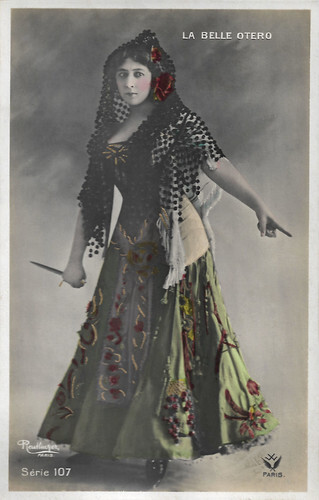
French postcard, Série 107. Photo: Reutlinger, Paris.
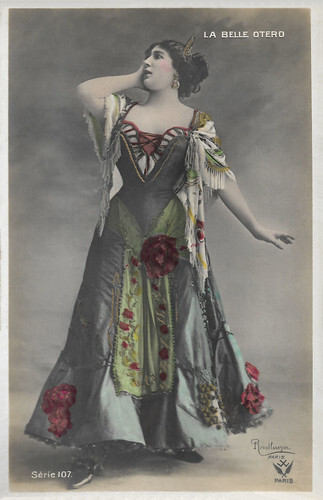
French postcard, Série 107. Photo: Reutlinger, Paris. Caption: La belle Otero.
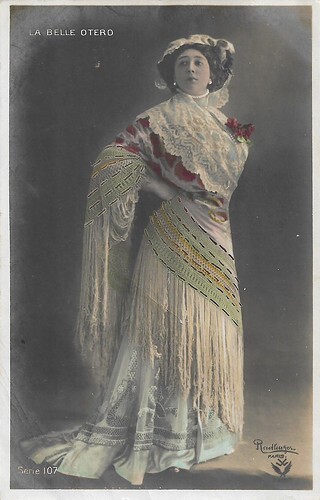
French postcard, Série 107. Photo: Reutlinger, Paris.
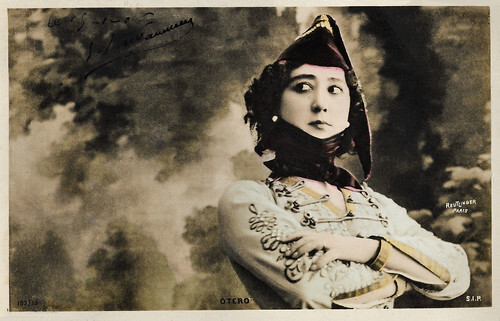
French postcard by S.I.P., no. 193/13. Photo: Reutlinger, Paris.
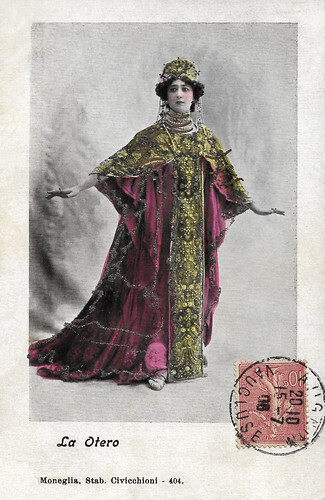
Italian postcard by Moneglia, Stab. Civicchioni, no. 404. Sent by mail in 1906.
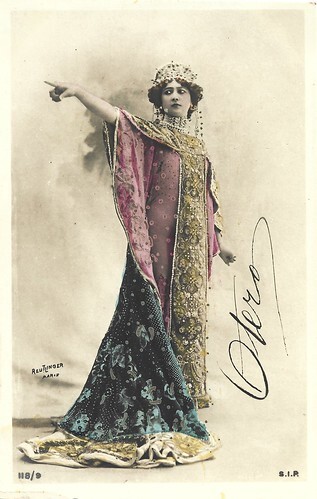
French postcard by S.I.P., no. 118/9. Photo: Reutlinger, Paris. Carolina Otero in 'L'Impératrice', a ballet by Jean Richepin and Paul Vidal, performed at the Théâtre Olympia in Paris in 1901.
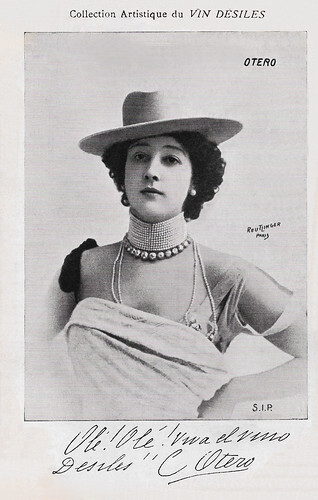
French postcard by S.I.P. in the Collection Artistique du Vin Désiles. Photo: Reutlinger. Caption: Olé! Olé! Viva el Vino Desiles.
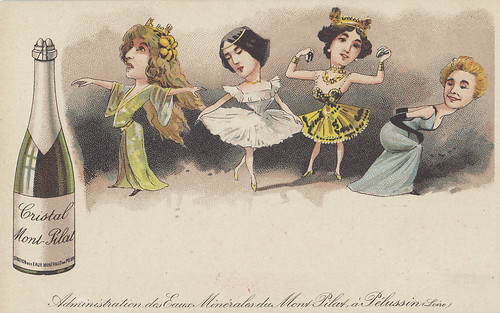
French advertising postcard for Cristal Mont-Pilat (mineral water, alas, not champagne) with caricatures of Sarah Bernhardt , Cléo de Mérode, Carolina 'la belle' Otéro, and Yvette Guilbert . The black gloves were usually a part of Guilbert’s costume. Collection: Marlene Pilaete.
A provocative and fatal woman
Carolina Otéro was born Agustina del Carmen Otéro Iglesias in 1868 into a poor family of modest social status in Valga, in the province of Pontevedra in Galicia. She moved with her family to Santiago de Compostela while still a child, where she began working as a maid.
She suffered - as she later revealed - a rape at the age of 10 that made her sterile, and at the age of 14, she left home with her boyfriend and dance partner, Paco, to work as a singer and dancer in Lisbon. She made her debut in cabaret in 1888 in Barcelona, moving soon after to France, first to Marseille, and then to Paris.
There she became a star of the Folies Bergère. Within a few years, she became one of the most famous women on the entire continent, the sought-after mistress of many powerful and prominent men of the time, such as Prince Albert I of Monaco, King Edward VII of the United Kingdom, the royals of Serbia and Spain, the Grand Dukes of Russia, Peter and Nicholas Nikolaevič, and the famous writer Gabriele D'Annunzio.
In 1890, Otéro was the star of a triumphant tour of the United States, and by the time she returned to Paris two years later, she was the undisputed star of the French stage. She performed in sumptuous gowns and jewellery that enhanced her form to support her reputation as a provocative and fatal woman.
One of her most famous stage costumes involved glueing precious gems onto her breasts, and it was also said that the domes of the Hotel Carlton in Cannes, built in 1912, were modelled on the shape of her breasts.
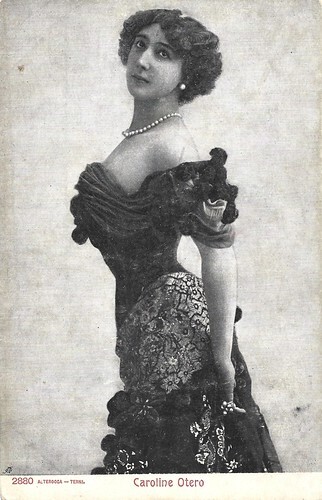
Italian postcard by Alterocca, Terni, no. 2880.
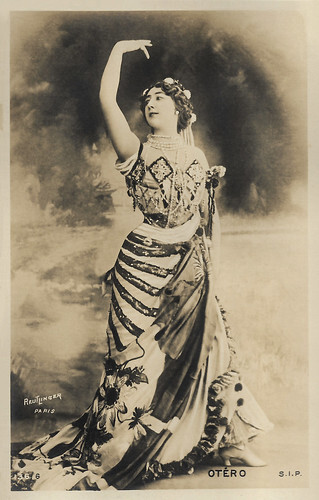
French postcard by S.I.P., no. 136/6. Photo: Reutlinger, Paris.
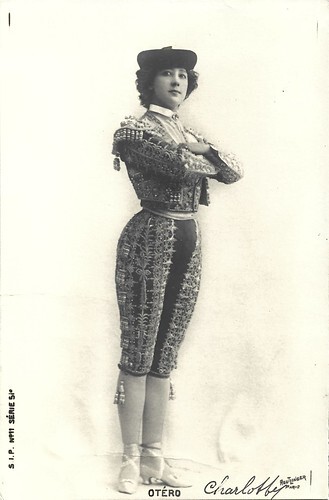
French postcard by S.I.P., no. 11, series 5. Photo: Reutlinger, Paris.
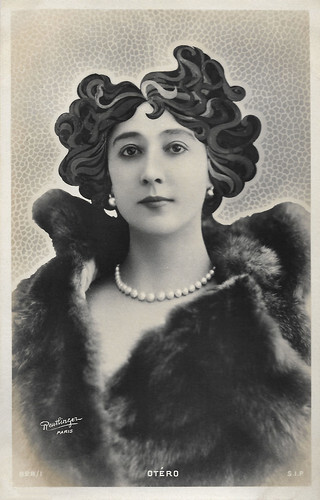
French postcard by S.I.P., no. 828. Photo: Reutlinger, Paris.
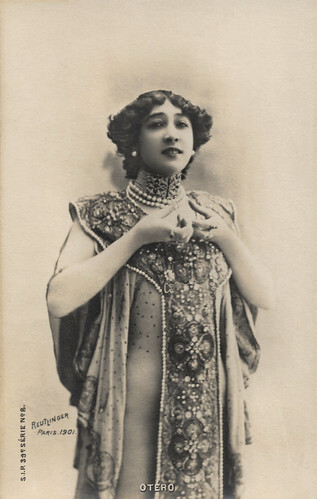
French postcard by S.I.P., no. 8, series 39. Photo: Reutlinger, Paris.
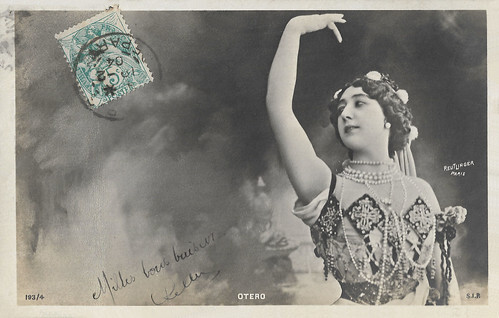
French postcard by S.I.P., no. 193/4. Photo: Reutlinger, Paris.
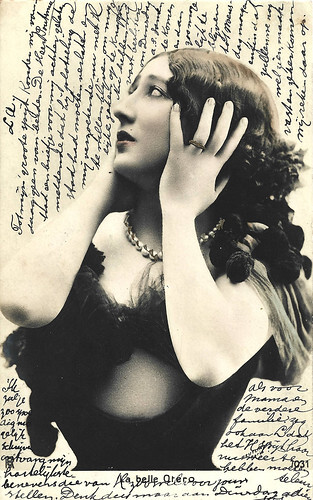
French postcard, no. 1031. Photo: Reutlinger, Paris. The postcard was mailed in 1905, with a message written in Dutch. In these early years of the postcard, one was only allowed to write on the front side of the card. The text addresses the excuses of a person who was unable to attend a private meeting due to an urgent business meeting.
A film scandal in St. Petersburg
In August 1898, in St. Petersburg, the French cinematographer Félix Mesguich, who worked for the Lumière Brothers' company, filmed a one-minute clip showing a dance number by La belle Otéro to the tune of the 'Valse Brillante'.
This made Caroline Otéro probably 'the first star in the history of cinema'. An officer of the tsarist army also appeared in the film, and when it was shown at the Music Hall Aquarium, the scandal was such that Mesguich was expelled from Russia.
She became close friends with the writer Colette and the famous Belle Époque dancer Liane de Pougy, with whom she developed a rivalry. In the 1900s, countless postcards with her circulated.
After the First World War ended, Otéro retired from the stage and bought a property with a sumptuous home for the equivalent of about $15 million. The actress had amassed a considerable fortune over the years, which amounted to around 25 million dollars, but she used it up over the years to support a sophisticated and expensive lifestyle.
She died in extreme poverty, supported by a pension from Monaco's Société des Bains de Mer in Nice, France, in 1965 at the age of 96. Caroline Otéro is depicted in the Monte Carlo Casino, in a painting in the White Room. In 1954, the Mexican actress María Félix played her in Richard Pottier's film La Belle Otero.
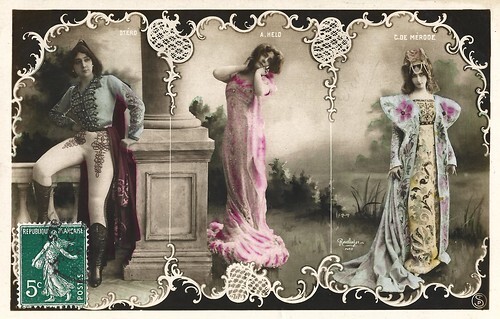
French postcard by S.I.P. Photo: Reutlinger, Paris. Caption: Otéro, A. Held (Anna Held), C. de Mérode (Cléo de Mérode).
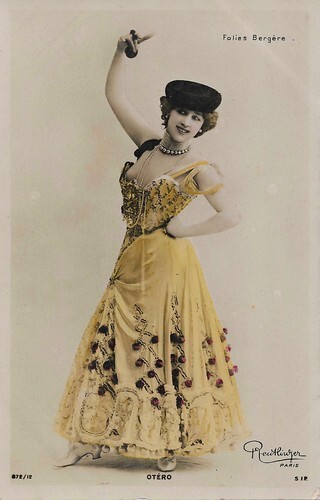
French postcard by S.I.P., no. 872/12. Photo: Reutlinger, Paris. Caption: Folies Bergère.
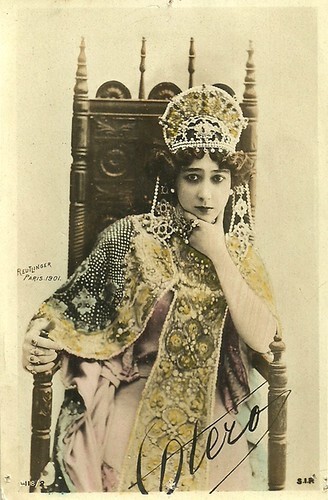
French postcard by S.I.P., no. 118/2. Photo: Reutlinger, Paris. Otero in 'L'Impératrice', a ballet by Jean Richepin and Paul Vidal, performed at the Théâtre Olympia in Paris in 1901.
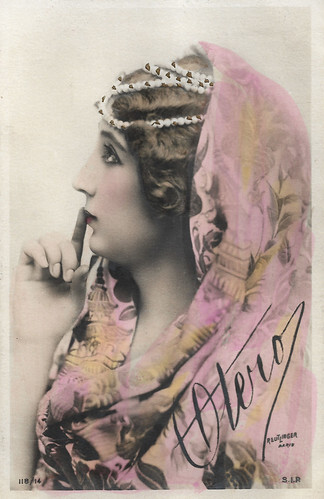
French postcard by S.I.P., no. 118/14. Photo: Reutlinger, Paris.
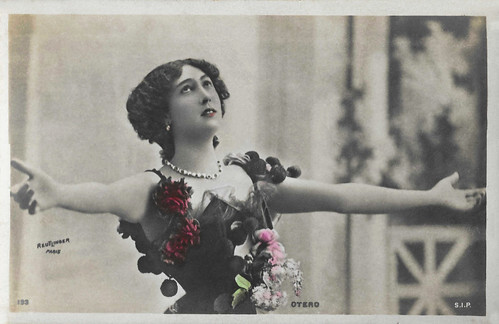
French postcard by S.I.P., no. 193. Photo: Reutlinger, Paris.
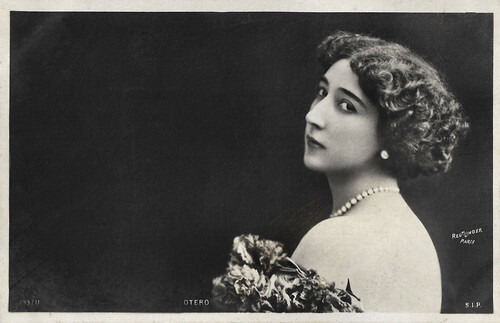
French postcard by S.I.P., no. 193/11. Photo: Reutlinger, Paris.
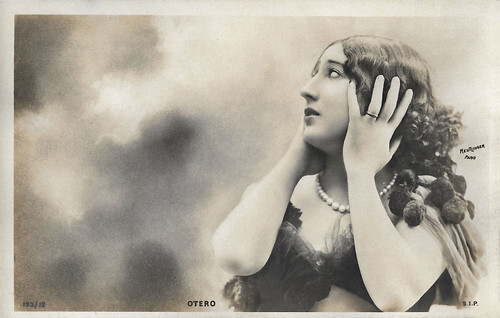
French postcard by S.I.P., no. 193/12. Photo: Reutlinger, Paris.
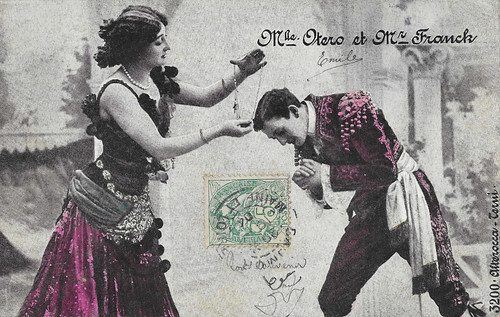
French postcard by Alterocca, Terni, no. 3200. Carolina Otéro and Paul Franck in 'Une fête à Séville' (1900). Sent by mail in 1904.
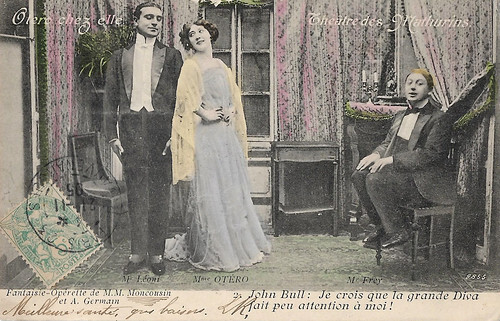
French postcard, no. 9855. Caroline Otero, Léoni and Fernand Frey in the 'fantaisie-opérette' 'Otero chez elle' (1904), by Paul Moncousin and Pierre German and composed by Justin Clérice. It was first performed on 10 October 1904 at the Théâtre des Mathurins in Paris. Caption: 2. John Bull (Frey): I think the great Diva is paying little attention to me. Postcard mailed in 1905.
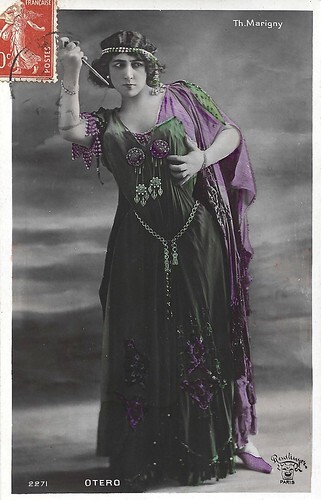
French postcard, no. 2271. Photo: Reutlinger, Paris. This is probably Otero as Giska in the ballet 'Giska la bohémienne' by Edmond Le Roy, with music by Léo Pouget. It was first performed on 2 September 1907 at the Théâtre Marigny (Paris).
Sources: Wikipedia (English and Italian) and .

French postcard, Série 107. Photo: Reutlinger, Paris.

French postcard, Série 107. Photo: Reutlinger, Paris. Caption: La belle Otero.

French postcard, Série 107. Photo: Reutlinger, Paris.

French postcard by S.I.P., no. 193/13. Photo: Reutlinger, Paris.

Italian postcard by Moneglia, Stab. Civicchioni, no. 404. Sent by mail in 1906.

French postcard by S.I.P., no. 118/9. Photo: Reutlinger, Paris. Carolina Otero in 'L'Impératrice', a ballet by Jean Richepin and Paul Vidal, performed at the Théâtre Olympia in Paris in 1901.

French postcard by S.I.P. in the Collection Artistique du Vin Désiles. Photo: Reutlinger. Caption: Olé! Olé! Viva el Vino Desiles.

French advertising postcard for Cristal Mont-Pilat (mineral water, alas, not champagne) with caricatures of Sarah Bernhardt , Cléo de Mérode, Carolina 'la belle' Otéro, and Yvette Guilbert . The black gloves were usually a part of Guilbert’s costume. Collection: Marlene Pilaete.
A provocative and fatal woman
Carolina Otéro was born Agustina del Carmen Otéro Iglesias in 1868 into a poor family of modest social status in Valga, in the province of Pontevedra in Galicia. She moved with her family to Santiago de Compostela while still a child, where she began working as a maid.
She suffered - as she later revealed - a rape at the age of 10 that made her sterile, and at the age of 14, she left home with her boyfriend and dance partner, Paco, to work as a singer and dancer in Lisbon. She made her debut in cabaret in 1888 in Barcelona, moving soon after to France, first to Marseille, and then to Paris.
There she became a star of the Folies Bergère. Within a few years, she became one of the most famous women on the entire continent, the sought-after mistress of many powerful and prominent men of the time, such as Prince Albert I of Monaco, King Edward VII of the United Kingdom, the royals of Serbia and Spain, the Grand Dukes of Russia, Peter and Nicholas Nikolaevič, and the famous writer Gabriele D'Annunzio.
In 1890, Otéro was the star of a triumphant tour of the United States, and by the time she returned to Paris two years later, she was the undisputed star of the French stage. She performed in sumptuous gowns and jewellery that enhanced her form to support her reputation as a provocative and fatal woman.
One of her most famous stage costumes involved glueing precious gems onto her breasts, and it was also said that the domes of the Hotel Carlton in Cannes, built in 1912, were modelled on the shape of her breasts.

Italian postcard by Alterocca, Terni, no. 2880.

French postcard by S.I.P., no. 136/6. Photo: Reutlinger, Paris.

French postcard by S.I.P., no. 11, series 5. Photo: Reutlinger, Paris.

French postcard by S.I.P., no. 828. Photo: Reutlinger, Paris.

French postcard by S.I.P., no. 8, series 39. Photo: Reutlinger, Paris.

French postcard by S.I.P., no. 193/4. Photo: Reutlinger, Paris.

French postcard, no. 1031. Photo: Reutlinger, Paris. The postcard was mailed in 1905, with a message written in Dutch. In these early years of the postcard, one was only allowed to write on the front side of the card. The text addresses the excuses of a person who was unable to attend a private meeting due to an urgent business meeting.
A film scandal in St. Petersburg
In August 1898, in St. Petersburg, the French cinematographer Félix Mesguich, who worked for the Lumière Brothers' company, filmed a one-minute clip showing a dance number by La belle Otéro to the tune of the 'Valse Brillante'.
This made Caroline Otéro probably 'the first star in the history of cinema'. An officer of the tsarist army also appeared in the film, and when it was shown at the Music Hall Aquarium, the scandal was such that Mesguich was expelled from Russia.
She became close friends with the writer Colette and the famous Belle Époque dancer Liane de Pougy, with whom she developed a rivalry. In the 1900s, countless postcards with her circulated.
After the First World War ended, Otéro retired from the stage and bought a property with a sumptuous home for the equivalent of about $15 million. The actress had amassed a considerable fortune over the years, which amounted to around 25 million dollars, but she used it up over the years to support a sophisticated and expensive lifestyle.
She died in extreme poverty, supported by a pension from Monaco's Société des Bains de Mer in Nice, France, in 1965 at the age of 96. Caroline Otéro is depicted in the Monte Carlo Casino, in a painting in the White Room. In 1954, the Mexican actress María Félix played her in Richard Pottier's film La Belle Otero.

French postcard by S.I.P. Photo: Reutlinger, Paris. Caption: Otéro, A. Held (Anna Held), C. de Mérode (Cléo de Mérode).

French postcard by S.I.P., no. 872/12. Photo: Reutlinger, Paris. Caption: Folies Bergère.

French postcard by S.I.P., no. 118/2. Photo: Reutlinger, Paris. Otero in 'L'Impératrice', a ballet by Jean Richepin and Paul Vidal, performed at the Théâtre Olympia in Paris in 1901.

French postcard by S.I.P., no. 118/14. Photo: Reutlinger, Paris.

French postcard by S.I.P., no. 193. Photo: Reutlinger, Paris.

French postcard by S.I.P., no. 193/11. Photo: Reutlinger, Paris.

French postcard by S.I.P., no. 193/12. Photo: Reutlinger, Paris.

French postcard by Alterocca, Terni, no. 3200. Carolina Otéro and Paul Franck in 'Une fête à Séville' (1900). Sent by mail in 1904.

French postcard, no. 9855. Caroline Otero, Léoni and Fernand Frey in the 'fantaisie-opérette' 'Otero chez elle' (1904), by Paul Moncousin and Pierre German and composed by Justin Clérice. It was first performed on 10 October 1904 at the Théâtre des Mathurins in Paris. Caption: 2. John Bull (Frey): I think the great Diva is paying little attention to me. Postcard mailed in 1905.

French postcard, no. 2271. Photo: Reutlinger, Paris. This is probably Otero as Giska in the ballet 'Giska la bohémienne' by Edmond Le Roy, with music by Léo Pouget. It was first performed on 2 September 1907 at the Théâtre Marigny (Paris).
Sources: Wikipedia (English and Italian) and .
Published on September 30, 2025 22:00
September 29, 2025
La Collectionneuse: Pauline Starke
Pauline Starke started her long and prolific silent movie career with D.W. Griffith. Later, she worked with other noted directors such as Frank Borzage, Maurice Tourneur, Allan Dwan, Raoul Walsh, John Ford, Ernst Lubitsch, Victor Fleming or Edmund Goulding. Like many other silent stars, Starke, who was said to have a certain likeness to Gloria Swanson, didn’t succeed in making the transition to sound films and, in 1935, she appeared in her last movie at a Poverty Row studio.
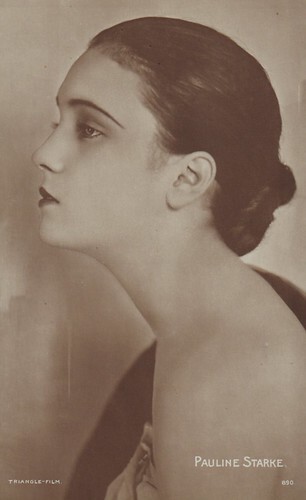
Swedish postcard by Nordisk Konst, Stockholm, no. 890. Photo: Triangle-Film.
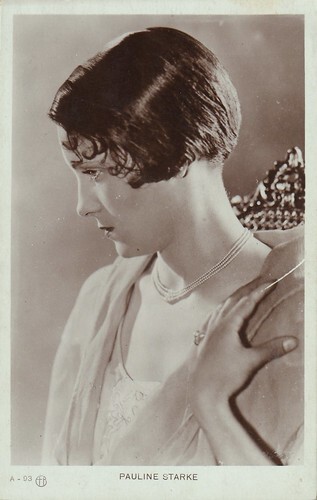
Spanish postcard by Editorial Fotografica Barcelona, no. A-93.
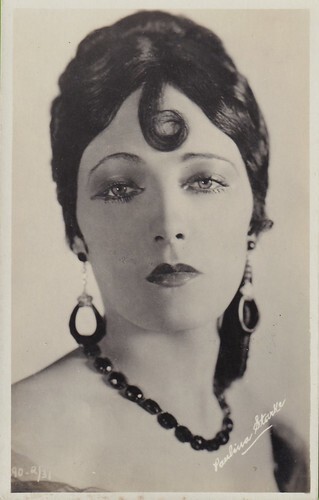
Mexican postcard by Gevaert.
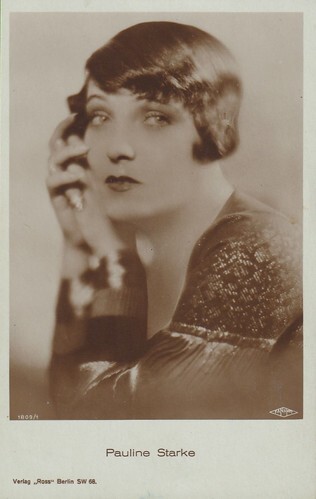
German postcard by Ross Verlag, no. 1809/1, 1927-1928. Photo: Fanamet.
Noticed by D.W. Griffith
Pauline Starke was allegedly born on the 10th of January 1901 in Joplin, U.S.A. However, contemporary sources, such as Stars of the Photoplay or The Picturegoer’s Who’s Who and Encyclopedia, indicate 1900.
According to IMDb , she would have made her movie debut in The Claws of Greed (1914), but the actress never mentioned this short. Furthermore, as there is a child actress in the cast called Ordean Stark, there may have been a mix-up.
According to Pauline Starke herself, she was noticed by director D.W. Griffith, who hired her as an extra in The Birth of a Nation (1915) and later cast her as a harem dancer in Intolerance (1916).
In 1917, Frank Borzage gave her a leading role in Until They Get Me, and she quickly became a promising young star in Triangle Film productions. Borzage directed her again in The Shoes That Danced (1918), Innocent’s Progress (1918) and The Atom (1918).
Her other Triangle films include Alias Mary Brown (1918), for which she was advertised as "The Little Girl With the Big Personality", Daughter Angele (1918) and Irish Eyes (1918).
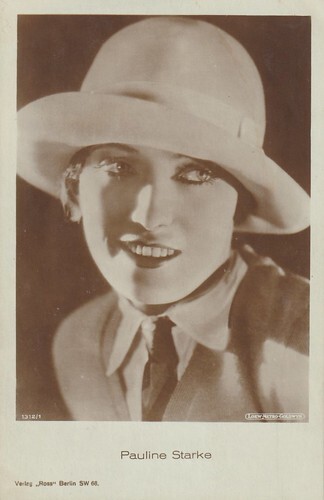
German postcard by Ross Verlag, no. 1312/1, 1927-1928. Photo: Loew Metro-Goldwyn.
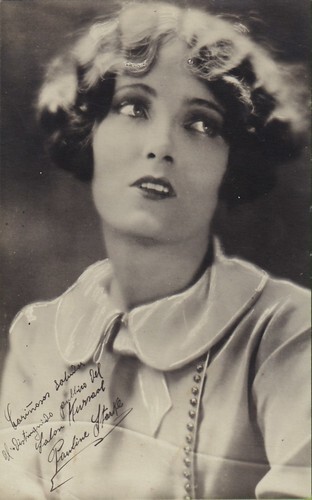
Spanish postcard in the Kursaal series.
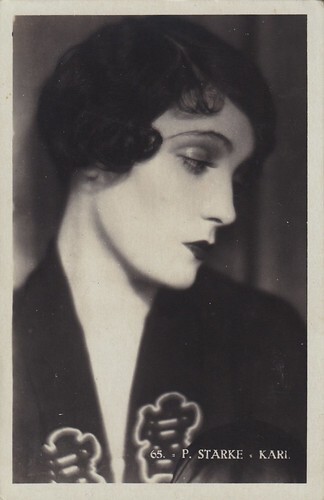
Italian postcard, no. 65.
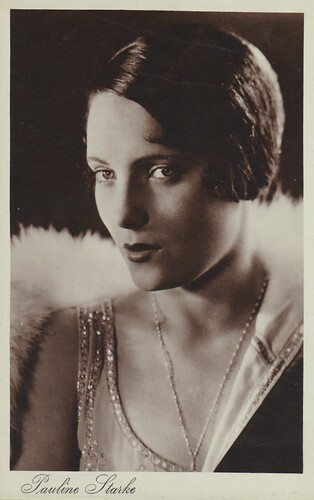
Italian postcard.
Freelance actress and unusual Wampas Baby Star
Pauline Starke then freelanced and appeared in a last Borzage movie, Whom the Gods Would Destroy (Frank Borzage, 1919), which was inspired by President Woodrow Wilson’s will to establish a League of Nations and was produced by the Macauley Photoplays, Inc.
She was also directed by Maurice Tourneur in The Life Line (1919) and The Broken Butterfly (1919) and by Allan Dwan in Soldiers of Fortune (1919).
Films such as The Courage of Mary O’Doone (1920), A Connecticut Yankee in King Arthur’s Court (1921), Snowblind (1921), Salvation Nell (1921), The Forgotten Woman (1921), The Flower of the North (1921), The Kingdom Within (1922), Lost and Found on a South Sea Island (1923), Hearts of Oak (1924), The Devil’s Cargo (1925), As No Man Has Loved (1925), … followed.
In 1922, the creation year of the Wampas Baby Stars, she was among the thirteen singled-out actresses who were predicted a bright future in films. This may seem curious, as she was already a veteran in the movie world and had a long string of leading roles behind her, as was Bessie Love , who was also nominated that same year.
Maybe, as it was their first year of existence, the Wampas committee wanted to play it safe by including in their selection several established and seasoned performers.
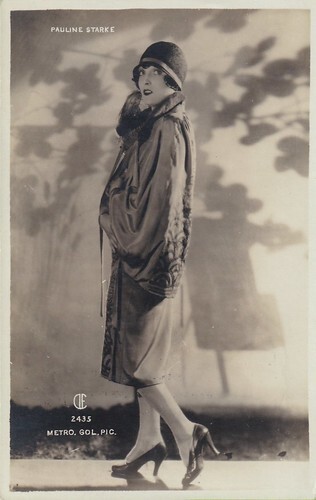
Mexican postcard by CIF, no. 2435. Photo: Metro Goldwyn.
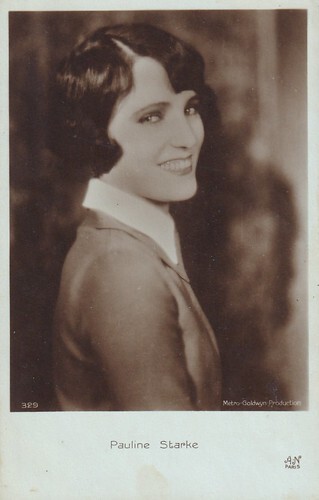
French postcard by A.N., Paris, no. 329. Photo: Metro Goldwyn.
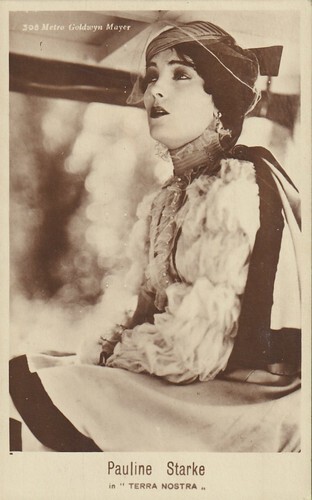
Italian postcard by G.B. Falci, no. 308. Pauline Starke in War Paint (W.S. Van Dyke, 1926).
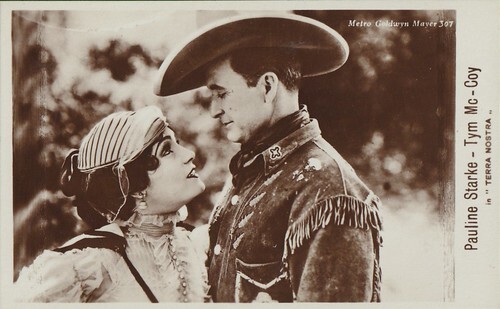
Italian postcard by G.B. Falci-Editore, Milano, no. 307. Pauline Starke and Tim McCoy in War Paint (W.S. Van Dyke, 1926). Photo: Metro Goldwyn Mayer.
Under contract to M.G.M.
In the second half of the 1920s, Pauline Starke was under contract to M.G.M, which gave her a more sophisticated and glamourous movie image and featured her in, among others, Sun-Up (1925), Bright Lights (1925), Love’s Blindness (1926), Women Love Diamonds (1927), in a role turned down by Greta Garbo , and Captain Salvation (1927).
In 1928, she starred in The Viking, which was the first feature made in Technicolour’s dye-transfer process. It was produced by the Technicolour Corporation and distributed by M.G.M. The Viking was released with a synchronised musical score with sound effects, as was also the case for her next film, Man, Woman and Wife (1929) at Universal.
She had no great luck in talkies. She made her talkie debut in Columbia’s A Royal Romance (1930) and Universal’s What Men Want (1930). In February 1932, she appeared on Broadway in 'Zombie', which closed after only 21 performances. Variety magazine called it a "wretchedly acted play".
In November 1932, the Conciliation Committee of the Academy of Motion Picture Arts and Sciences ordered director James Cruze to pay $6,050 in back salary to Pauline Starke. She had claimed that, after a few days of filming on the set of The Great Gabbo (1929), he had unceremoniously replaced her with his then-wife, Betty Compson .
She had her last starring role at Poverty Row’s Monarch Film Corporation in Twenty Dollars a Week (1935). In 1948, she was found unconscious from an overdose of sleeping pills. Her husband declared that she had been in the habit of taking sedatives for more than ten years. Pauline Starke died from the aftermath of a stroke on the 3rd of February 1977.
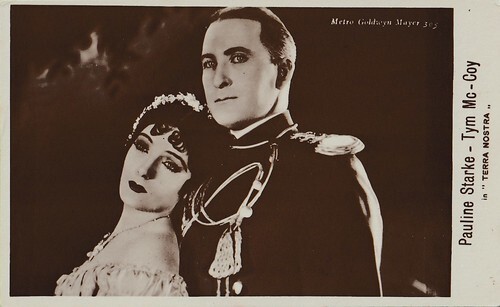
Italian postcard by G.B. Falci-Editore, Milano, no. 305. Pauline Starke and Tim McCoy in War Paint (W.S. Van Dyke, 1926). Photo: Metro Goldwyn Mayer.
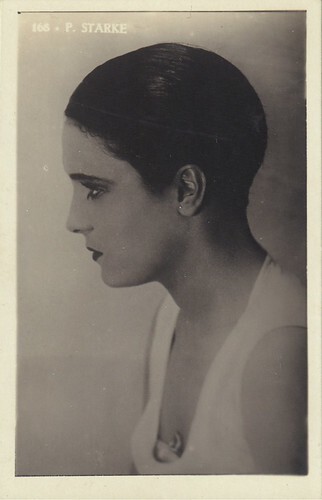
Italian postcard, no. 168.
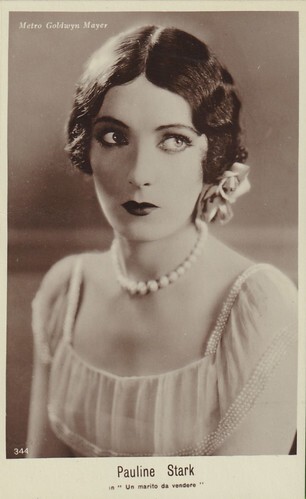
Italian postcard by G.B. Falci, no. 344. Pauline Starke in Love’s Blindness (John Francis Dillon, 1926).
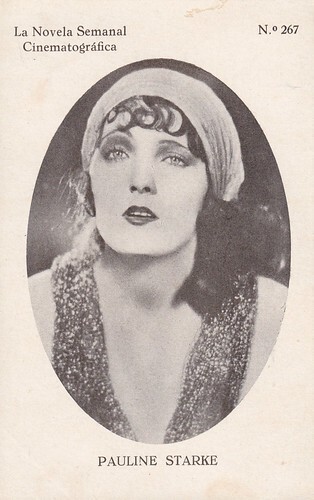
Spanish postcard by La Novela Semanal Cinematografica, no. 267.
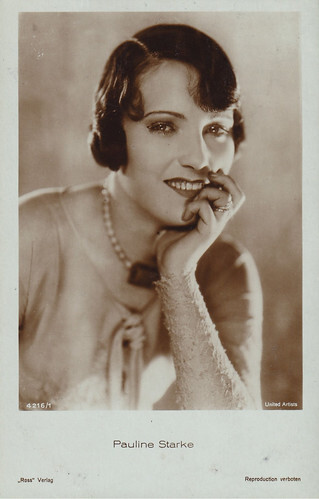
German postcard by Ross Verlag, no. 4216/1, 1929-1930. Photo: United Artists.
Text and postcards: Marlene Pilaete.

Swedish postcard by Nordisk Konst, Stockholm, no. 890. Photo: Triangle-Film.

Spanish postcard by Editorial Fotografica Barcelona, no. A-93.

Mexican postcard by Gevaert.

German postcard by Ross Verlag, no. 1809/1, 1927-1928. Photo: Fanamet.
Noticed by D.W. Griffith
Pauline Starke was allegedly born on the 10th of January 1901 in Joplin, U.S.A. However, contemporary sources, such as Stars of the Photoplay or The Picturegoer’s Who’s Who and Encyclopedia, indicate 1900.
According to IMDb , she would have made her movie debut in The Claws of Greed (1914), but the actress never mentioned this short. Furthermore, as there is a child actress in the cast called Ordean Stark, there may have been a mix-up.
According to Pauline Starke herself, she was noticed by director D.W. Griffith, who hired her as an extra in The Birth of a Nation (1915) and later cast her as a harem dancer in Intolerance (1916).
In 1917, Frank Borzage gave her a leading role in Until They Get Me, and she quickly became a promising young star in Triangle Film productions. Borzage directed her again in The Shoes That Danced (1918), Innocent’s Progress (1918) and The Atom (1918).
Her other Triangle films include Alias Mary Brown (1918), for which she was advertised as "The Little Girl With the Big Personality", Daughter Angele (1918) and Irish Eyes (1918).

German postcard by Ross Verlag, no. 1312/1, 1927-1928. Photo: Loew Metro-Goldwyn.

Spanish postcard in the Kursaal series.

Italian postcard, no. 65.

Italian postcard.
Freelance actress and unusual Wampas Baby Star
Pauline Starke then freelanced and appeared in a last Borzage movie, Whom the Gods Would Destroy (Frank Borzage, 1919), which was inspired by President Woodrow Wilson’s will to establish a League of Nations and was produced by the Macauley Photoplays, Inc.
She was also directed by Maurice Tourneur in The Life Line (1919) and The Broken Butterfly (1919) and by Allan Dwan in Soldiers of Fortune (1919).
Films such as The Courage of Mary O’Doone (1920), A Connecticut Yankee in King Arthur’s Court (1921), Snowblind (1921), Salvation Nell (1921), The Forgotten Woman (1921), The Flower of the North (1921), The Kingdom Within (1922), Lost and Found on a South Sea Island (1923), Hearts of Oak (1924), The Devil’s Cargo (1925), As No Man Has Loved (1925), … followed.
In 1922, the creation year of the Wampas Baby Stars, she was among the thirteen singled-out actresses who were predicted a bright future in films. This may seem curious, as she was already a veteran in the movie world and had a long string of leading roles behind her, as was Bessie Love , who was also nominated that same year.
Maybe, as it was their first year of existence, the Wampas committee wanted to play it safe by including in their selection several established and seasoned performers.

Mexican postcard by CIF, no. 2435. Photo: Metro Goldwyn.

French postcard by A.N., Paris, no. 329. Photo: Metro Goldwyn.

Italian postcard by G.B. Falci, no. 308. Pauline Starke in War Paint (W.S. Van Dyke, 1926).

Italian postcard by G.B. Falci-Editore, Milano, no. 307. Pauline Starke and Tim McCoy in War Paint (W.S. Van Dyke, 1926). Photo: Metro Goldwyn Mayer.
Under contract to M.G.M.
In the second half of the 1920s, Pauline Starke was under contract to M.G.M, which gave her a more sophisticated and glamourous movie image and featured her in, among others, Sun-Up (1925), Bright Lights (1925), Love’s Blindness (1926), Women Love Diamonds (1927), in a role turned down by Greta Garbo , and Captain Salvation (1927).
In 1928, she starred in The Viking, which was the first feature made in Technicolour’s dye-transfer process. It was produced by the Technicolour Corporation and distributed by M.G.M. The Viking was released with a synchronised musical score with sound effects, as was also the case for her next film, Man, Woman and Wife (1929) at Universal.
She had no great luck in talkies. She made her talkie debut in Columbia’s A Royal Romance (1930) and Universal’s What Men Want (1930). In February 1932, she appeared on Broadway in 'Zombie', which closed after only 21 performances. Variety magazine called it a "wretchedly acted play".
In November 1932, the Conciliation Committee of the Academy of Motion Picture Arts and Sciences ordered director James Cruze to pay $6,050 in back salary to Pauline Starke. She had claimed that, after a few days of filming on the set of The Great Gabbo (1929), he had unceremoniously replaced her with his then-wife, Betty Compson .
She had her last starring role at Poverty Row’s Monarch Film Corporation in Twenty Dollars a Week (1935). In 1948, she was found unconscious from an overdose of sleeping pills. Her husband declared that she had been in the habit of taking sedatives for more than ten years. Pauline Starke died from the aftermath of a stroke on the 3rd of February 1977.

Italian postcard by G.B. Falci-Editore, Milano, no. 305. Pauline Starke and Tim McCoy in War Paint (W.S. Van Dyke, 1926). Photo: Metro Goldwyn Mayer.

Italian postcard, no. 168.

Italian postcard by G.B. Falci, no. 344. Pauline Starke in Love’s Blindness (John Francis Dillon, 1926).

Spanish postcard by La Novela Semanal Cinematografica, no. 267.

German postcard by Ross Verlag, no. 4216/1, 1929-1930. Photo: United Artists.
Text and postcards: Marlene Pilaete.
Published on September 29, 2025 22:00
September 28, 2025
Miles Davis
American jazz trumpeter Miles Davis (1926-1991) was one of the most important and influential jazz musicians in history. Davis played various styles, including bop, cool jazz, modal jazz and jazz-rock fusion. His style is recognisable and original and continues to influence jazz musicians decades after his death. His music for Louis Malle's Nouvelle Vague classic Ascenseur pour l'échafaud / Elevator to the Gallows (1957) is one of the greatest Jazz soundtracks in cinema history.
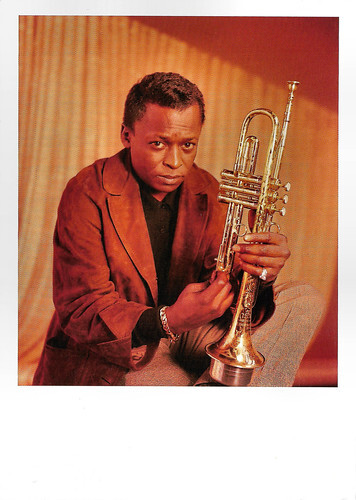
German postcard by Benedikt Taschen Verlag G.m.b.H., Köln, 1997. Photo: William Claxton. Caption: Miles Davis, Hollywood, 1957, from the book 'William Claxton's Jazz Photography'.
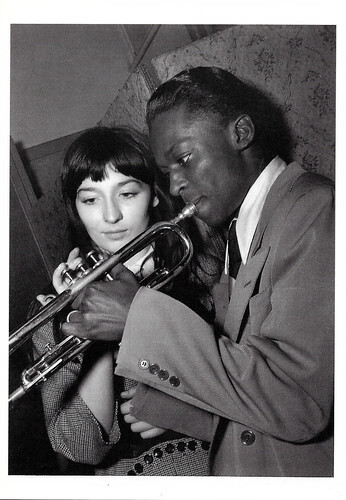
French postcard by Éditions Hazan, Paris, 1995. Photo: Jean-Philippe Charbonnier / Agence TOP. Caption: Juliette Greco and Miles Davis, Halle Pleyel, May 1949.
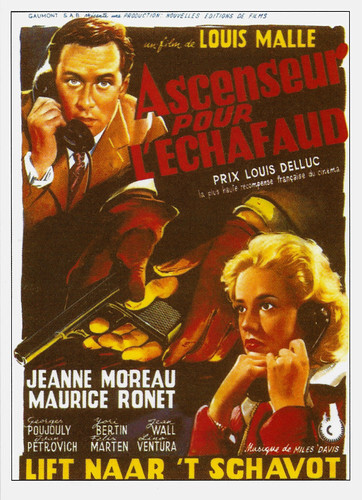
French poster postcard by Encyclopédie du Cinéma, no.EDC 284, VIS 1. Belgian poster for Ascenseur pour l'échafaud / Elevator to the Gallows (Louis Malle, 1957) with music by Miles Davis.
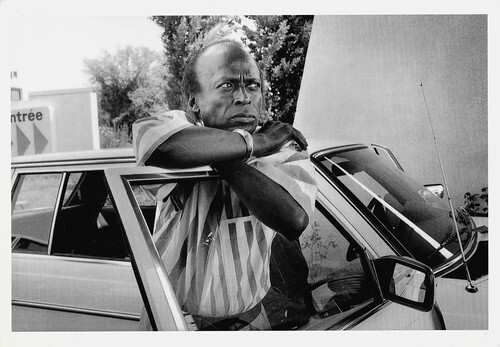
French postcard in the Collection Magie Noire by Editions Hazan, Paris, 1993, no. 6350. Photo: Guy Le Querrec / Magnum. Caption: Miles Davis, Jazz Festival de Nîmes, 20 July 1984.
Kicking his heroin addiction
Miles Dewey Davis III was born in Alton, Illinois, in 1926. Davis was the son of a dental surgeon, Dr. Miles Dewey Davis, Jr., and a music teacher, Cleota Mae (Henry) Davis. He grew up in the black middle class of East St. Louis after the family moved there shortly after his birth. His mother wanted him to learn to play the violin. Instead, his father gave him a trumpet for his thirteenth birthday, which he devoted himself to from then on. The family owned a ranch, where young Miles learned to ride horses.
When Davis was 15, he played for audiences with bandleader Eddie Randall and studied under trumpeter Elwood Buchanan. Against the fashion of the time, Buchanan emphasised the importance of playing without vibrato. Davis retained this distinctive, clear tone throughout his career. William Ruhlmann at AllMusic : "At 17, he joined Eddie Randle's Blue Devils, a territory band based in St. Louis. He enjoyed a personal apotheosis in 1944, just after graduating from high school, when he saw and was allowed to sit in with Billy Eckstine's big band, which was playing in St. Louis. The band featured trumpeter Dizzy Gillespie and saxophonist Charlie Parker, the architects of the emerging bebop style of jazz, which was characterised by fast, inventive soloing and dynamic rhythm variations."
In 1945, Davis moved to New York, ostensibly to study at the Institute of Musical Art in New York City (renamed Juilliard) on a scholarship. In reality, he neglected his education and went in search of his heroes, such as Thelonious Monk and Coleman Hawkins. He regularly went out with Dizzy Gillespie, and they became good friends. By 1949, he had fulfilled his 'probation' as a fellow player, both on stage and on recordings. His own recording career subsequently flourished. That same year, Davis began collaborating with Gil Evans. This collaboration continued over the next 20 years for many of his major works. The records they made in the late 1940s were released on a limited basis for the first decade.
Through New York's jazz clubs, Davis regularly came into contact with both users and sellers of illegal drugs. By 1950, he had a serious heroin addiction, possibly exacerbated by the lacklustre reception of his first personal recordings. In the first part of the 1950s, the talent Davis possessed seemed to be lost. He played several gigs, but these were uninspired. Aware of this, Davis returned to East Saint Louis in 1954, where he tried to kick the habit with the help of his father. The latter mistakenly thought it had to do with his teeth. Davis closed himself off from society until he was free of his drug addiction.
By 1954, he had overcome his heroin addiction, although he continued to use cocaine, among other things. Reborn, he returned to New York and founded the first major version of the Miles Davis Quintet. This band included the young John Coltrane and occasionally some other jazz artists known at the time, such as Sonny Rollins and Charles Mingus. Musically, the group continued where Davis left off in his sessions in the late 1940s. They avoided the rhythmic and harmonic complexity of the dominant bebop, and Davis was given the space to play long, legato and essentially melodic lines, in which he learned to make sense of modal music. This was a lifelong obsession for him.
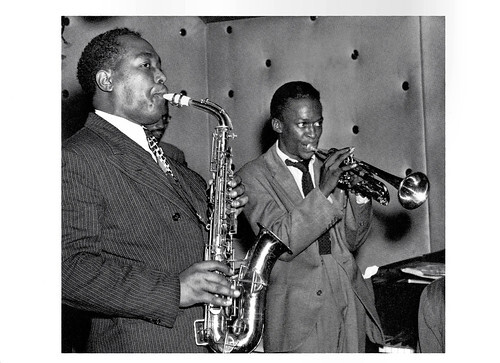
American postcard by Fotofolio, NY, NY, no. M 133. Photo: William P. Gottlieb. Charlie Parker and Miles Davis, 1948.
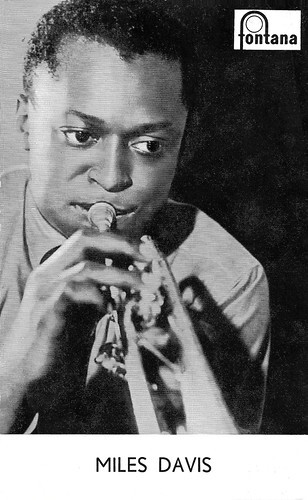
Vintage promotion card by Fontana, no. GF 06421.
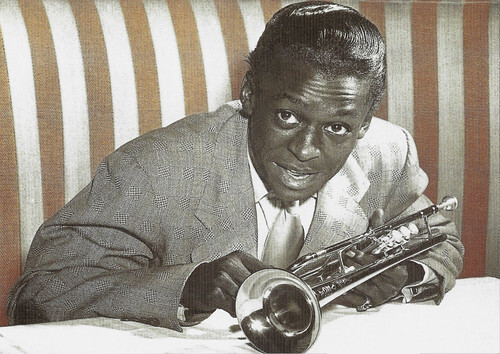
German postcard by Edition Tushita, no. B 985. Photo: Artwork Media GmbH.
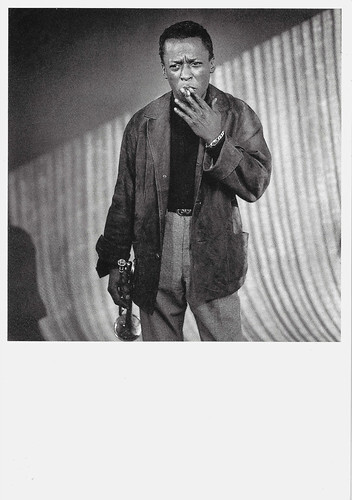
French postcard by Editions du Désastre, Paris, no. WC 4, 1989. Photo: William Claxton. Caption: Miles Davis, Los Angeles, 1956.
The birth of cool jazz
In February 1957, Capitol finally issued the 1949 recordings, together on an LP called 'Birth of the Cool'. He also recorded 'Relaxin' with the Miles Davis Quintet'. These albums defined the sound of cool jazz, one of the dominant trends in music for the next decade and beyond. In December 1957, Miles Davis returned to Paris, where he improvised the background music for the film Ascenseur pour l'échafaud / Elevator to the Gallows (Louis Malle, 1957) with Jeanne Moreau and Maurice Ronet .
Davis recorded the music in a single recording session while he watched a screening. He composed it while watching a rough cut and then invited a quartet of French and US musicians in from 11 pm to 5 am one night, improvising each number and allegedly sipping champagne with Jeanne Moreau and Louis Malle. Claudio Carvalho at IMDb : "The soundtrack with the music of Miles Davis gives a touch of class to this little masterpiece. The result is one of the best thrillers entwined with comedy of errors that I have ever seen."
While the rest of the music establishment was still trying to accept Miles Davis' innovations, he himself was further along. Reunited with Gil Evans, he recorded a series of albums of great variety and complexity, demonstrating his mastery of his instrument in almost every musical context. On the first album, 'Miles Ahead' (1957), he played with a traditional jazz big band. This had a driven brass section arranged by Gil Evans. In addition to jazz numbers (including Dave Brubeck's 'The Duke'), the two took on Léo Delibes' 'Les Filles de Cadix'. This was the first time Davis recorded European classical music.
'Milestones' (1958) captured the sound of his current sextet, which now consisted of Davis, John Coltrane, Julian "Cannonball" Adderley (alto sax), Red Garland (piano), Paul Chambers (bass) and Philly Joe Jones (drums). Musically, this album encompassed both the past and future of jazz. Davis showed he could play blues and bebop (accompanied by Garland), but the centrepiece is the title track, a composition by Davis around the Dorian and Aeolian modes and with the free improvisational modal style Davis made his own.
This modal style flourished on 'Kind of Blue' (1959), an album that became a landmark in modern jazz and the most popular album of Davis' career. It eventually sold over two million copies, a phenomenal success for a jazz record. The sextet improvised on short modal themes that had not been rehearsed beforehand. In the group, Bill Evans took over the piano, bringing classical influences to the group. On one of the tracks, Wynton Kelly played piano. He later became a permanent member of the group. After 'Kind of Blue', the group broke up. Coltrane, Evans and Adderley continued as bandleaders. Miles Davis found less inspiration, and his group changed line-ups regularly.
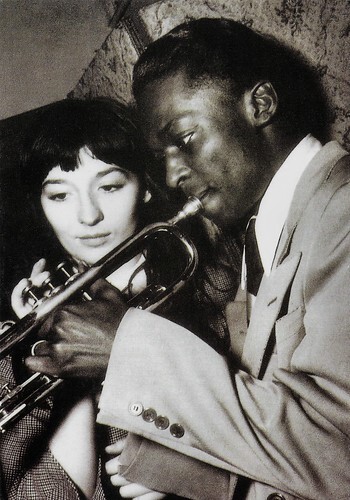
German postcard by Edition Tushita, Duisburg Innenhafen, no. B 511. Photo: Jean-Philippe Charbonnier / ADN, Berlin / Tushita. Caption: Miles Davis & Juliette Greco , Paris Jazz Club.
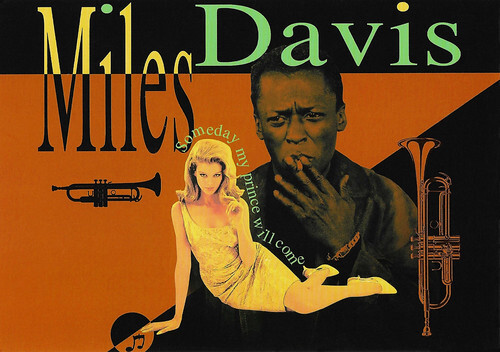
German postcard by Edition Tushita, no. B 1147. Caption: Some Day My Prince Will Come. Miles Davis "the 60ies".
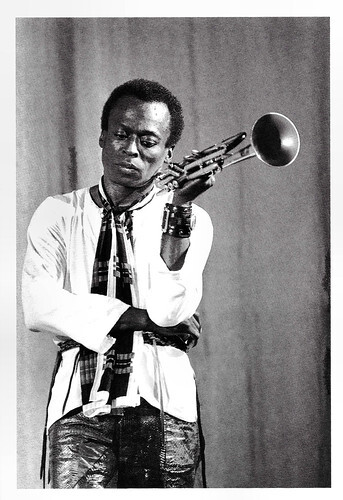
French postcard by Editions Hazan, Paris, 1991, no. 6295. Photo: Guy Le Querrec / Magnum. Caption: Miles Davis, 1969.
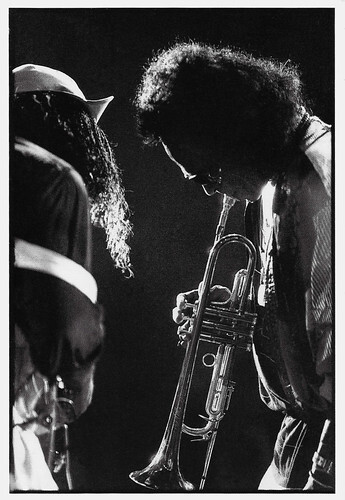
Swiss postcard by News Productions, Baulmes, no. 56221. Photo: Edouard Curchod.
A landmark for emerging jazz fusion music
In 1964, Miles Davis formed his second major quintet. Herbie Hancock on piano, Wayne Shorter on saxophone, Ron Carter on bass and the still young Tony Williams on drums. Davis stated, "You have to know the rules first to then be able to break them." Jazz standards were played live, pushing the boundaries of tradition. Long improvisations with much emphasis on harmonic boundaries and tight group playing allowed him to play with texture more than before.
Live, he played standards and in the studio new work, especially compositions by his saxophonist Wayne Shorter. The limits were reached on 'Live at Plugged Nickel'. It formed a counterpoint to the free jazz of Ornette Coleman, whom Davis reviled in his autobiography. In June 1970, Miles Davis, Chick Corea, Keith Jarrett, Dave Holland, Jack DeJohnette and John McLaughlin, among others, met for four nights at the modest nightclub The Cellar Door in Washington, D.C. A six-song CD of those performances was released in 2006.
In the late 1960s, Davis went electric with an electric piano, electric bass and an electric guitar. The 'groove' became important. After Davis heard 'Machine Gun' by Jimi Hendrix at the Isle of Wight Festival, Davis immediately wanted to start a band with him. "It's that goddamned motherfucking 'Machine Gun'," Miles replied when asked what he thought of Hendrix's music. Due to Hendrix's death, it never took place. In the 1970s, he tried to reach black youth by putting funk influences in his music. As heard on the revolutionary album 'On The Corner'. 'Bitches Brew' (1970) became a landmark for emerging jazz fusion music.
In late 1975, Davis withdrew from music and no longer wanted to play the trumpet. He again struggled with addiction, this time to cocaine and alcohol. Poor health, partly caused by years of excessive drug use, led to a radio silence of almost six years. Miles Davis returned to music anyway. His style changed more to a pop style. He recorded new, intriguing albums such as electronic-driven 'Tutu or Amandla', as well as Spanish-flavoured music for the film Siesta (Mary Lambert, 1987) with Ellen Barkin and Gabriel Byrne.
Miles Davis died in Santa Monica, California, in 1991. He was 65. Already in a coma, he died of pneumonia following a severe stroke and was buried next to Duke Ellington at Woodlawn Cemetery in The Bronx, New York. Davis was married to Frances Taylor (1958-1968), Betty Mabry (1968-1969) and actress Cicely Tyson (1981-1988). He had four children: Cheryl (1944), Gregory (1946), Miles IV (1950) and Erin (1970). Twenty-four years after Davis' death, he was the subject of Miles Ahead (2015), a biopic co-written and directed by Don Cheadle, who also portrayed him. Its soundtrack functioned as a career overview with additional music provided by pianist Robert Glasper and associates. In 2020, the trumpeter was also the focus of director Stanley Nelson's documentary Miles Davis: Birth of the Cool, which showcased music from throughout Davis's career.
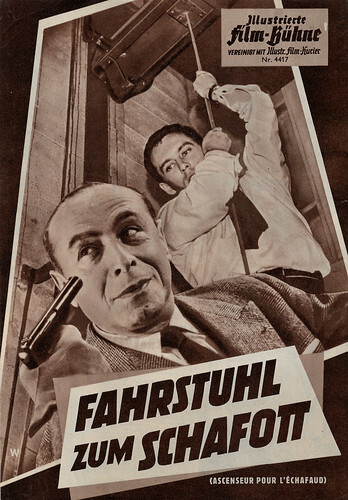
West German flyer by Illustrierte Film-Bühne (merged with Illustrierte Film-Kurier), no. 4417, for Ascenseur pour l'échafaud / Elevator to the Gallows (Louis Malle, 1957) with music by Miles Davis, page 1. Photos: Pallas Film. The German title was Fahrstuhl zum Schafott.
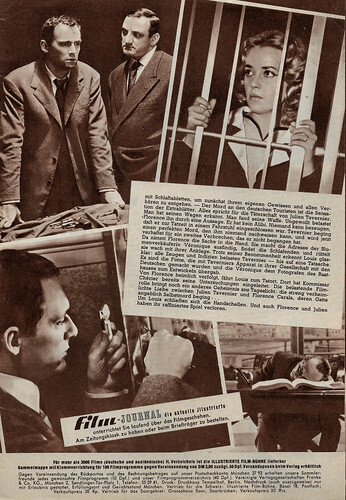
West German flyer by Illustrierte Film-Bühne (merged with Illustrierte Film-Kurier), no. 4417, for Ascenseur pour l'échafaud / Elevator to the Gallows (Louis Malle, 1957) with music by Miles Davis, page 2. Photos: Pallas Film. The German title was Fahrstuhl zum Schafott.
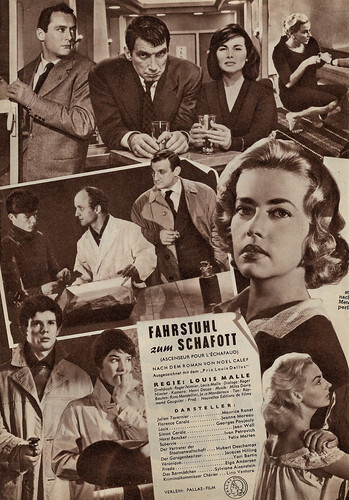
West German flyer by Illustrierte Film-Bühne (merged with Illustrierte Film-Kurier), no. 4417, for Ascenseur pour l'échafaud / Elevator to the Gallows (Louis Malle, 1957) with music by Miles Davis, page 3. Photos: Pallas Film. The German title was Fahrstuhl zum Schafott.
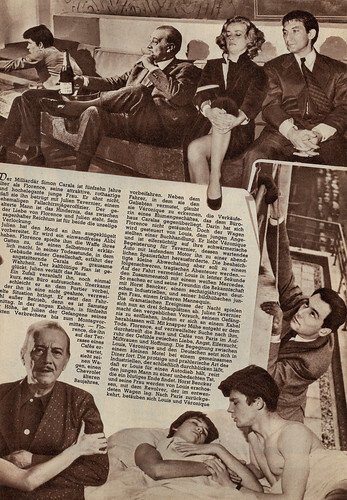
West German flyer by Illustrierte Film-Bühne (merged with Illustrierte Film-Kurier), no. 4417, for Ascenseur pour l'échafaud / Elevator to the Gallows (Louis Malle, 1957) with music by Miles Davis, page 4. Photos: Pallas Film. The German title was Fahrstuhl zum Schafott.
Sources: William Ruhlmann (AllMusic), (IMDb), Claudio Carvalho (IMDb), Wikipedia (Dutch) and .

German postcard by Benedikt Taschen Verlag G.m.b.H., Köln, 1997. Photo: William Claxton. Caption: Miles Davis, Hollywood, 1957, from the book 'William Claxton's Jazz Photography'.

French postcard by Éditions Hazan, Paris, 1995. Photo: Jean-Philippe Charbonnier / Agence TOP. Caption: Juliette Greco and Miles Davis, Halle Pleyel, May 1949.

French poster postcard by Encyclopédie du Cinéma, no.EDC 284, VIS 1. Belgian poster for Ascenseur pour l'échafaud / Elevator to the Gallows (Louis Malle, 1957) with music by Miles Davis.

French postcard in the Collection Magie Noire by Editions Hazan, Paris, 1993, no. 6350. Photo: Guy Le Querrec / Magnum. Caption: Miles Davis, Jazz Festival de Nîmes, 20 July 1984.
Kicking his heroin addiction
Miles Dewey Davis III was born in Alton, Illinois, in 1926. Davis was the son of a dental surgeon, Dr. Miles Dewey Davis, Jr., and a music teacher, Cleota Mae (Henry) Davis. He grew up in the black middle class of East St. Louis after the family moved there shortly after his birth. His mother wanted him to learn to play the violin. Instead, his father gave him a trumpet for his thirteenth birthday, which he devoted himself to from then on. The family owned a ranch, where young Miles learned to ride horses.
When Davis was 15, he played for audiences with bandleader Eddie Randall and studied under trumpeter Elwood Buchanan. Against the fashion of the time, Buchanan emphasised the importance of playing without vibrato. Davis retained this distinctive, clear tone throughout his career. William Ruhlmann at AllMusic : "At 17, he joined Eddie Randle's Blue Devils, a territory band based in St. Louis. He enjoyed a personal apotheosis in 1944, just after graduating from high school, when he saw and was allowed to sit in with Billy Eckstine's big band, which was playing in St. Louis. The band featured trumpeter Dizzy Gillespie and saxophonist Charlie Parker, the architects of the emerging bebop style of jazz, which was characterised by fast, inventive soloing and dynamic rhythm variations."
In 1945, Davis moved to New York, ostensibly to study at the Institute of Musical Art in New York City (renamed Juilliard) on a scholarship. In reality, he neglected his education and went in search of his heroes, such as Thelonious Monk and Coleman Hawkins. He regularly went out with Dizzy Gillespie, and they became good friends. By 1949, he had fulfilled his 'probation' as a fellow player, both on stage and on recordings. His own recording career subsequently flourished. That same year, Davis began collaborating with Gil Evans. This collaboration continued over the next 20 years for many of his major works. The records they made in the late 1940s were released on a limited basis for the first decade.
Through New York's jazz clubs, Davis regularly came into contact with both users and sellers of illegal drugs. By 1950, he had a serious heroin addiction, possibly exacerbated by the lacklustre reception of his first personal recordings. In the first part of the 1950s, the talent Davis possessed seemed to be lost. He played several gigs, but these were uninspired. Aware of this, Davis returned to East Saint Louis in 1954, where he tried to kick the habit with the help of his father. The latter mistakenly thought it had to do with his teeth. Davis closed himself off from society until he was free of his drug addiction.
By 1954, he had overcome his heroin addiction, although he continued to use cocaine, among other things. Reborn, he returned to New York and founded the first major version of the Miles Davis Quintet. This band included the young John Coltrane and occasionally some other jazz artists known at the time, such as Sonny Rollins and Charles Mingus. Musically, the group continued where Davis left off in his sessions in the late 1940s. They avoided the rhythmic and harmonic complexity of the dominant bebop, and Davis was given the space to play long, legato and essentially melodic lines, in which he learned to make sense of modal music. This was a lifelong obsession for him.

American postcard by Fotofolio, NY, NY, no. M 133. Photo: William P. Gottlieb. Charlie Parker and Miles Davis, 1948.

Vintage promotion card by Fontana, no. GF 06421.

German postcard by Edition Tushita, no. B 985. Photo: Artwork Media GmbH.

French postcard by Editions du Désastre, Paris, no. WC 4, 1989. Photo: William Claxton. Caption: Miles Davis, Los Angeles, 1956.
The birth of cool jazz
In February 1957, Capitol finally issued the 1949 recordings, together on an LP called 'Birth of the Cool'. He also recorded 'Relaxin' with the Miles Davis Quintet'. These albums defined the sound of cool jazz, one of the dominant trends in music for the next decade and beyond. In December 1957, Miles Davis returned to Paris, where he improvised the background music for the film Ascenseur pour l'échafaud / Elevator to the Gallows (Louis Malle, 1957) with Jeanne Moreau and Maurice Ronet .
Davis recorded the music in a single recording session while he watched a screening. He composed it while watching a rough cut and then invited a quartet of French and US musicians in from 11 pm to 5 am one night, improvising each number and allegedly sipping champagne with Jeanne Moreau and Louis Malle. Claudio Carvalho at IMDb : "The soundtrack with the music of Miles Davis gives a touch of class to this little masterpiece. The result is one of the best thrillers entwined with comedy of errors that I have ever seen."
While the rest of the music establishment was still trying to accept Miles Davis' innovations, he himself was further along. Reunited with Gil Evans, he recorded a series of albums of great variety and complexity, demonstrating his mastery of his instrument in almost every musical context. On the first album, 'Miles Ahead' (1957), he played with a traditional jazz big band. This had a driven brass section arranged by Gil Evans. In addition to jazz numbers (including Dave Brubeck's 'The Duke'), the two took on Léo Delibes' 'Les Filles de Cadix'. This was the first time Davis recorded European classical music.
'Milestones' (1958) captured the sound of his current sextet, which now consisted of Davis, John Coltrane, Julian "Cannonball" Adderley (alto sax), Red Garland (piano), Paul Chambers (bass) and Philly Joe Jones (drums). Musically, this album encompassed both the past and future of jazz. Davis showed he could play blues and bebop (accompanied by Garland), but the centrepiece is the title track, a composition by Davis around the Dorian and Aeolian modes and with the free improvisational modal style Davis made his own.
This modal style flourished on 'Kind of Blue' (1959), an album that became a landmark in modern jazz and the most popular album of Davis' career. It eventually sold over two million copies, a phenomenal success for a jazz record. The sextet improvised on short modal themes that had not been rehearsed beforehand. In the group, Bill Evans took over the piano, bringing classical influences to the group. On one of the tracks, Wynton Kelly played piano. He later became a permanent member of the group. After 'Kind of Blue', the group broke up. Coltrane, Evans and Adderley continued as bandleaders. Miles Davis found less inspiration, and his group changed line-ups regularly.

German postcard by Edition Tushita, Duisburg Innenhafen, no. B 511. Photo: Jean-Philippe Charbonnier / ADN, Berlin / Tushita. Caption: Miles Davis & Juliette Greco , Paris Jazz Club.

German postcard by Edition Tushita, no. B 1147. Caption: Some Day My Prince Will Come. Miles Davis "the 60ies".

French postcard by Editions Hazan, Paris, 1991, no. 6295. Photo: Guy Le Querrec / Magnum. Caption: Miles Davis, 1969.

Swiss postcard by News Productions, Baulmes, no. 56221. Photo: Edouard Curchod.
A landmark for emerging jazz fusion music
In 1964, Miles Davis formed his second major quintet. Herbie Hancock on piano, Wayne Shorter on saxophone, Ron Carter on bass and the still young Tony Williams on drums. Davis stated, "You have to know the rules first to then be able to break them." Jazz standards were played live, pushing the boundaries of tradition. Long improvisations with much emphasis on harmonic boundaries and tight group playing allowed him to play with texture more than before.
Live, he played standards and in the studio new work, especially compositions by his saxophonist Wayne Shorter. The limits were reached on 'Live at Plugged Nickel'. It formed a counterpoint to the free jazz of Ornette Coleman, whom Davis reviled in his autobiography. In June 1970, Miles Davis, Chick Corea, Keith Jarrett, Dave Holland, Jack DeJohnette and John McLaughlin, among others, met for four nights at the modest nightclub The Cellar Door in Washington, D.C. A six-song CD of those performances was released in 2006.
In the late 1960s, Davis went electric with an electric piano, electric bass and an electric guitar. The 'groove' became important. After Davis heard 'Machine Gun' by Jimi Hendrix at the Isle of Wight Festival, Davis immediately wanted to start a band with him. "It's that goddamned motherfucking 'Machine Gun'," Miles replied when asked what he thought of Hendrix's music. Due to Hendrix's death, it never took place. In the 1970s, he tried to reach black youth by putting funk influences in his music. As heard on the revolutionary album 'On The Corner'. 'Bitches Brew' (1970) became a landmark for emerging jazz fusion music.
In late 1975, Davis withdrew from music and no longer wanted to play the trumpet. He again struggled with addiction, this time to cocaine and alcohol. Poor health, partly caused by years of excessive drug use, led to a radio silence of almost six years. Miles Davis returned to music anyway. His style changed more to a pop style. He recorded new, intriguing albums such as electronic-driven 'Tutu or Amandla', as well as Spanish-flavoured music for the film Siesta (Mary Lambert, 1987) with Ellen Barkin and Gabriel Byrne.
Miles Davis died in Santa Monica, California, in 1991. He was 65. Already in a coma, he died of pneumonia following a severe stroke and was buried next to Duke Ellington at Woodlawn Cemetery in The Bronx, New York. Davis was married to Frances Taylor (1958-1968), Betty Mabry (1968-1969) and actress Cicely Tyson (1981-1988). He had four children: Cheryl (1944), Gregory (1946), Miles IV (1950) and Erin (1970). Twenty-four years after Davis' death, he was the subject of Miles Ahead (2015), a biopic co-written and directed by Don Cheadle, who also portrayed him. Its soundtrack functioned as a career overview with additional music provided by pianist Robert Glasper and associates. In 2020, the trumpeter was also the focus of director Stanley Nelson's documentary Miles Davis: Birth of the Cool, which showcased music from throughout Davis's career.

West German flyer by Illustrierte Film-Bühne (merged with Illustrierte Film-Kurier), no. 4417, for Ascenseur pour l'échafaud / Elevator to the Gallows (Louis Malle, 1957) with music by Miles Davis, page 1. Photos: Pallas Film. The German title was Fahrstuhl zum Schafott.

West German flyer by Illustrierte Film-Bühne (merged with Illustrierte Film-Kurier), no. 4417, for Ascenseur pour l'échafaud / Elevator to the Gallows (Louis Malle, 1957) with music by Miles Davis, page 2. Photos: Pallas Film. The German title was Fahrstuhl zum Schafott.

West German flyer by Illustrierte Film-Bühne (merged with Illustrierte Film-Kurier), no. 4417, for Ascenseur pour l'échafaud / Elevator to the Gallows (Louis Malle, 1957) with music by Miles Davis, page 3. Photos: Pallas Film. The German title was Fahrstuhl zum Schafott.

West German flyer by Illustrierte Film-Bühne (merged with Illustrierte Film-Kurier), no. 4417, for Ascenseur pour l'échafaud / Elevator to the Gallows (Louis Malle, 1957) with music by Miles Davis, page 4. Photos: Pallas Film. The German title was Fahrstuhl zum Schafott.
Sources: William Ruhlmann (AllMusic), (IMDb), Claudio Carvalho (IMDb), Wikipedia (Dutch) and .
Published on September 28, 2025 22:00
September 27, 2025
Directed by René Clair
René Clair (1898-1981) was a French film director and writer who was involved with both the Surrealist and Dadaist movements. From 1922, he began to work as a screenwriter, and shortly afterwards also as a director. In the 1930s, René Clair made an international name for himself as a director of avant-garde and artistically innovative films. In his comedies and socio/political satires, he examined the mores of the middle and upper classes in France. Although he also made films in both Britain and the US, he was happiest working in France, where he felt less subjected to studio interference.
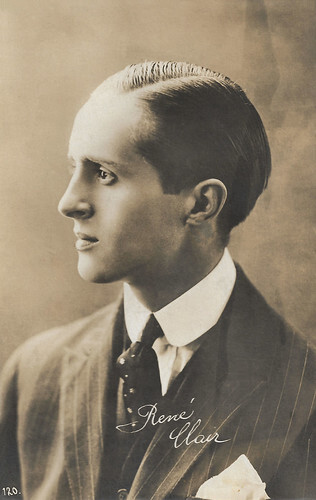
Vintage postcard by Neobrom, no. 120.
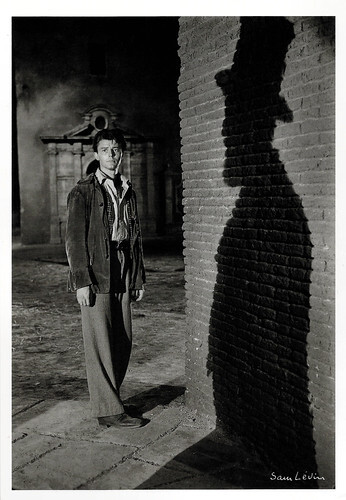
French postcard in the Collection Magie Noire by Editions Hazan, Paris, no. 6192, 1989. Photo: Sam Lévin. Gérard Philipe and the shadow of Michel Simon in La Beauté du diable (René Clair, 1950).
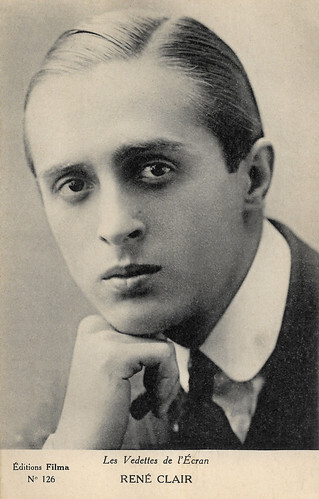
French postcard in the Les Vedettes de l'Écran series by Éditions Filma, no. 126.
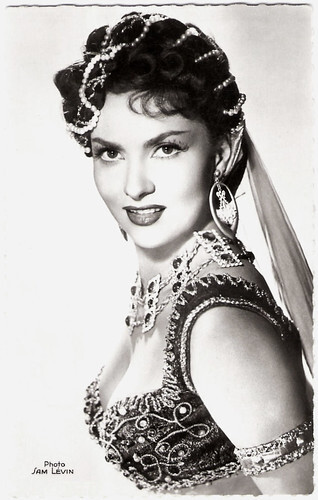
French postcard by Editions du Globe, Paris, no. 325. Photo: Sam Lévin. Gina Lollobrigida in Les belles de nuit / Beauties of the Night (René Clair, 1952).
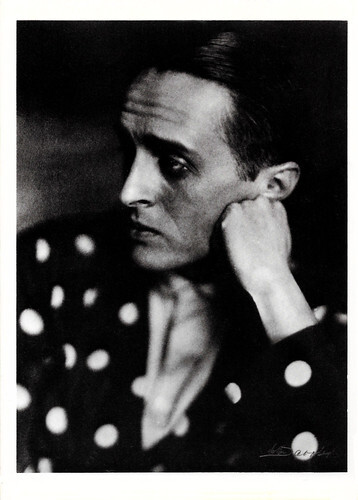
American postcard by Fotofolio, NY, NY, no. LJ5. Photo: Lotte Jacobi. Caption: René Clair, Berlin, c. 1920s.
A series of films with a taste for the fantastic
René Clair was born René Lucien Chomette in Paris in 1898. He was the son of a soap manufacturer. His elder brother, Henri Chomette, later also became a writer and director. René grew up in Paris in the district of Les Halles, whose lively and picturesque character made a lasting impression on him. He attended the Lycée Montaigne and then the Lycée Louis-le-Grand, where he became friends with the poet Jacques Rigaut. In 1917, he was mobilised as a volunteer ambulance driver during World War I. He was deeply affected by the horrors of war that he witnessed and gave expression to this in writing a volume of poetry called 'La Tête de l'homme', which remained unpublished.
In 1918, he started working as a journalist for the left-wing newspaper L'Intransigeant under the pseudonym René Després. He also wrote lyrics for the music-hall singer Damia , under the pseudonym Danceny. Clair was persuaded by her to visit Gaumont studios in 1920, where a film was being cast. With Damia , he made his debut as the lead actor in the silent film Le Lys de la vie / The Lily of Life (Loïe Fuller, Gabrielle Sorère, 1920), written by Queen Marie of Romania.
He went on to play roles in other films like the serials L'Orpheline / The Orphan (Louis Feuillade, 1921) and Parisette (Louis Feuillade, 1921), both starring Sandra Milowanoff , and Le Sens de la mort / The Meaning of Death (Yakov Protazanov, 1922) with Diana Karenne . For these films, he chose the pseudonym René Clair. He also became director of the cinema supplement for the magazine Théâtre et Comœdia illustré.
In 1922, he became Jacques de Baroncelli's assistant on two films. That same year, he began writing the screenplay for Le Rayon diabolique, which he shot in 1923 with the support of the producer Henri Diamant-Berger. The film was released in 1925 under the title Paris qui dort. In the meantime, Eric Satie's ballet 'Relâche', for which Francis Picabia had written the libretto, was to be staged at the Théâtre des Champs-Élysées. The theatre's director, Jacques Hébertot, was also the director of Comœdia. Picabia wanted a short film to be shown during the interval and chose René Clair to direct it. The Dadaist-inspired film Entr'acte (1924), in which Marcel Duchamp and Man Ray also took part, caused a scandal and made Clair famous.
In the following years, Clair made a series of films with a taste for the fantastic. His Sci-Fi comedy Paris qui dort / Paris Asleep (1925) was followed by Le Fantôme du Moulin-Rouge / The Phantom of the Moulin-Rouge (1925) and Le Voyage imaginaire / The Imaginary Voyage (1926), which featured Albert Préjean . In 1926, Clair joined Alexandre Kamenka's Films Albatros company to film a dramatic story, La Proie du vent / The Prey of the Wind (1926), with Charles Vanel and Jean Murat. The film was a commercial success. Clair remained at Albatros for his last two silent films, the comedies Un chapeau de paille d'Italie / The Italian Straw Hat (1928) and Les Deux Timides / Two Timid Souls (1928), based on two plays by Eugène Labiche. Wikipedia : "As the author of all of his own scripts, who also paid close attention to every aspect of the making of a film, including the editing, Clair was one of the first French filmmakers to establish for himself the full role of an auteur." At the same time, René Clair devoted himself to writing a novel, 'Adams', which was published by Grasset in 1926. In 1929, he co-wrote the screenplay for Prix de beauté (1930), which he was initially also to direct. The film was directed by Augusto Genina, and Louise Brooks played the lead role.
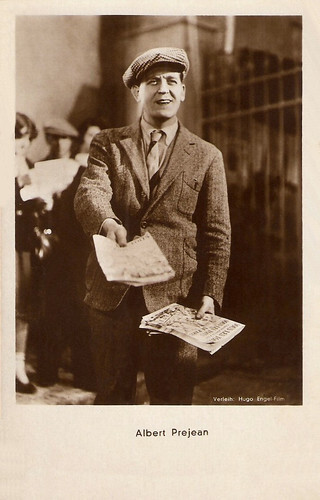
German card. Photo: Verleih Hugo Engel-Film. Albert Préjean in Sous les toits de Paris / Under the Roofs of Paris (René Clair, 1930). Préjean plays a street singer and here distributes the texts of the song 'Sous les toits de Paris'.
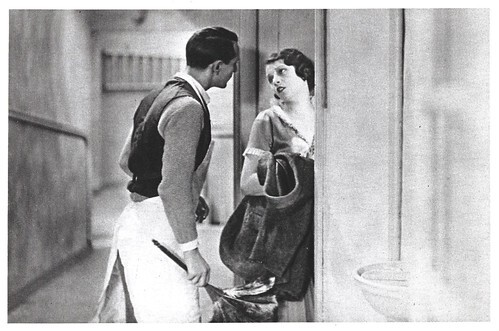
French postcard by Eds. Le Malibran, Paris. Annabella and René Lefèvre in the comedy Le million / The Million (René Clair, 1931).
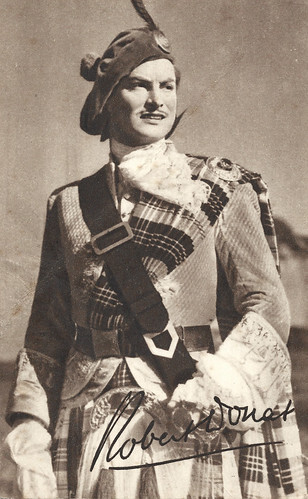
British postcard by. Photogravure. Robert Donat in the British comedy The Ghost Goes West (René Clair, 1935).
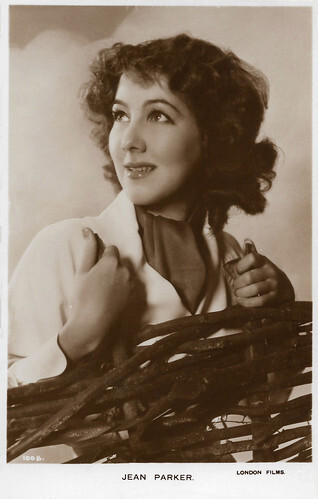
British Real Photograph postcard, no. 100b. Photo: London Films. Jean Parker in The Ghost Goes West (René Clair, 1935).
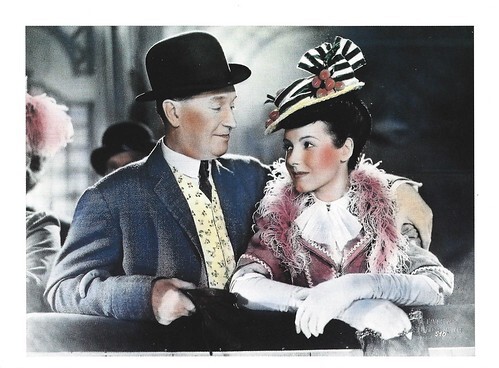
French coloured postcard by Eds. Centre Pompidou / Flammario, 1994. Maurice Chevalier and Marcelle Derrien in Le silence est d'or / Man About Town (René Clair, 1947).
An offer by Alexander Korda to work in London
René Clair was not happy with the arrival of sound film. He thought it would undermine the complex language constructed by the silent cinema over the last three decades. Ironically, it was his first talking film, Sous les toits de Paris / Under the Roofs of Paris (1930), that earned him an international reputation with prestigious admirers including Charles Chaplin and Sergei Eisenstein . He had realised the creative possibilities that sound film offered, particularly if the soundtrack was not used realistically; words and pictures should not be tied together in a clumsy duplication of information; dialogue did not always need to be heard.
His success was confirmed with the musicals Le Million / The Million (1931) with Annabella , À nous la liberté / Freedom for Us (1931), a utopian satire of industrial society, and Quatorze juillet / Bastille Day (1933). These films were made at the Epinay Studios for Films Sonores Tobis, a French subsidiary of the German-owned Tobis company.
When Chaplin's Modern Times came out in 1936. Tobis, which in 1935 had come under the control of Nazi propaganda minister Joseph Goebbels, decided to sue Chaplin for plagiarism of À nous la liberté / Freedom for Us (1931). Clair opposed this action, seeing Chaplin's film, which he admired, as an indirect homage to his film, but Tobis continued to sue Chaplin.
After the failure of Le Dernier Milliardaire / The Last Millionaire (1934), a satirical evocation of the 1929 crisis, René Clair accepted an offer by Alexander Korda to work in London. His first British film, The Ghost Goes West (1935), was a comic fantasy about transatlantic culture clash. It was a success. His next film, Break the News (1938), a musical comedy with Jack Buchanan and Maurice Chevalier , was a disappointment.
He returned to France in 1938 and began shooting a new project, Air pur, in July 1939. Shooting was interrupted by the mobilisation order in September, which sent various members of the film crew off to war, leaving the film unfinished. At the end of June 1940, René Clair left France with his wife and child. They went to Spain and then Portugal, and set sail for New York. The Vichy government stripped him of his French nationality, but reversed the decision later.
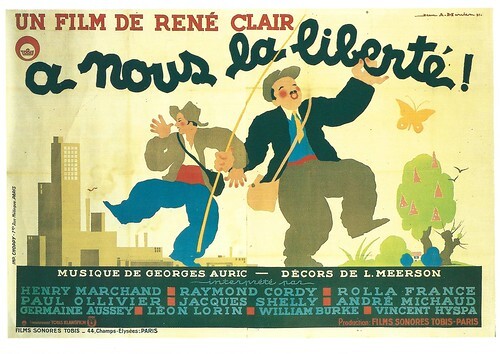
French film poster postcard by Dix et Démi Quinze, Paris, 1995. Affiche by Jean Adrien Mercier for À nous la liberté / Freedom for Us (René Clair, 1931). Released on the occasion of an exhibition on Jean Adrien Mercier.
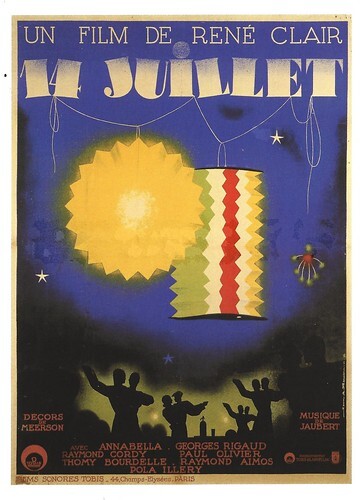
Swiss poster postcard by CVB publishers. Affiche: Jean Adrien Mercier / Collection Cinémathèque Suisse, Lausanne. Affiche by Jean Adrien Mercier for Quatorze juillet / Bastille Day (René Clair, 1933).
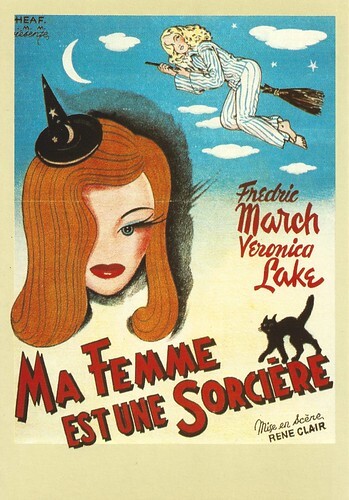
French poster postcard by Eds. Zreik, Paris. Affiche Coll. Télérama, la mémoire du cinéma. French affiche for I Married a Witch (René Clair, 1940).
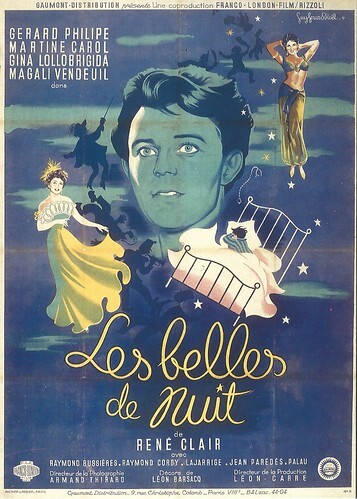
French poster postcard by F. Nugeron 29. Eds. Ramsay, Paris. Affiche: designed by Guy Gérard-Noèl. French poster for Les belles de nuit / Beauties of the Night (René Clair, 1952).
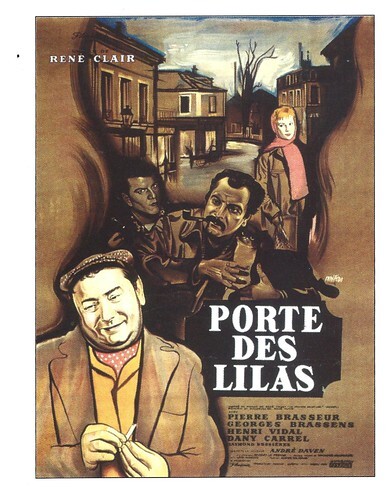
French poster postcard by Encyclopédie du Cinéma. Affiche: designed by René Peron. French poster for Porte des lilas / The Gates of Paris (René Clair, 1957), with Pierre Brasseur , Georges Brassens , Henri Vidal and Dany Carrel .
Four successful films in Hollywood
In June 1940, after the outbreak of World War II, René Clair emigrated to the United States, where he shot four successful films in Hollywood. He made his first American film for Universal Studios, The Flame of New Orleans (1941), starring Marlene Dietrich . The film was a commercial failure. Clair is highly regarded for the whimsical comedy I Married a Witch (1942), for which he effectively discovered latent comedic talents in his star Veronica Lake .
It was followed by It Happened Tomorrow (1944), which did respectably well. His mystery, And Then There Were None (1945), was an exceptional commercial success and is considered one of the most faithful adaptations of an Agatha Christie thriller. In 1946, Clair returned to France and made the romantic comedy Le silence est d'or / Silence is Golden (1947), an amusing evocation of the silent film era. It was Clair's first French film since the aborted project Air pur. Le silence est d'or also marked Maurice Chevalier 's return to the cinema after an absence of seven years.
Clair then made one of his most famous films, La Beauté du diable / Beauty and the Devil (1949), in which he revisited the myth of Faust and directed Gérard Philipe for the first time. Philipe also starred in his next film, the whimsical comedy Les Belles de nuit / Beauties of the Night (1952), also with Gina Lollobrigida . An International success was his film Les Grandes Manœuvres / Summer Manoeuvres (1955), starring Michèle Morgan, Gérard Philipe and Brigitte Bardot . His first film in colour won the Prix Louis-Delluc.
Clair then directed Porte des Lilas / The Gates of Paris (1957), featuring singer Georges Brassens in his only film appearance, playing the role of a singer who resembled him. From the 1950s, Clair also started writing, mainly essays, but also some novels and novellas. In 1960, he was elected as a member of the Académie française, as the first filmmaker. At the same time, the Nouvelle Vague overturned the rules of studio cinema, of which he had become the most prestigious representative. He then alternated between the sketch films La Française et l'Amour / Love and the Frenchwoman (1960) and Les Quatre Vérités / Three Fables of Love (1962) and the feature films Tout l'or du monde / All the Gold in the World (1961) with Bourvil , followed by his last film, Les Fêtes galantes / The Lace Wars (1965).
Clair then devoted himself to writing and directing plays. He restaged Francis Picabia's ballet 'Relâche' in 1970, and tried his hand at opera with 'Orphée et Eurydice' in 1973, presented at the Paris Opéra. In 1974, he was the president of the jury at the Cannes Film Festival. René Clair died in 1981 in Neuilly-sur-Seine, Hauts-de-Seine, France. He was buried in the ancient cemetery in Neuilly-sur-Seine. Since 1928, René Clair had been married to Bronia Clair. At the end of 1924, while Clair was working with Picabia, he first met a young actress, Bronja Perlmutter, who subsequently appeared in his film Le Voyage imaginaire (1926). They married in 1926, and their son, Jean-François, was born in 1927. Since 1994, the Académie has awarded the Prix René Clair for Best Camera Work.
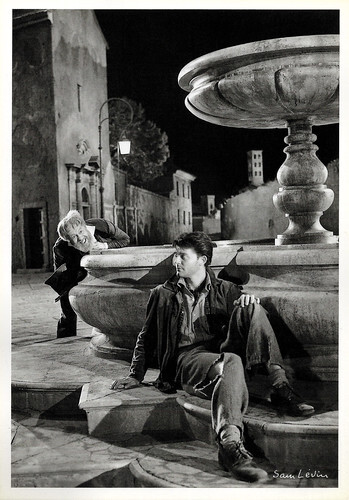
French postcard in the Collection Magie Noire by Editions Hazan, Paris, no. 6195, 1989. Photo: Sam Lévin. Gérard Philipe and Michel Simon in La Beauté du diable (René Clair, 1950).
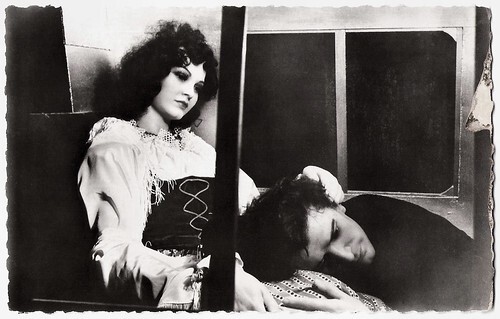
French postcard by Editions P.I. / Editions du Musée Grévin, Paris, no. 4. Photo: Musée Grévin, a wax museum in Paris, recreated a scene with wax figures of Gérard Philipe and Nicole Besnard in La Beauté du diable / Beauty and the Devil (René Clair, 1950). Caption: Voyage de noces a Venise (Honeymoon in Venice).
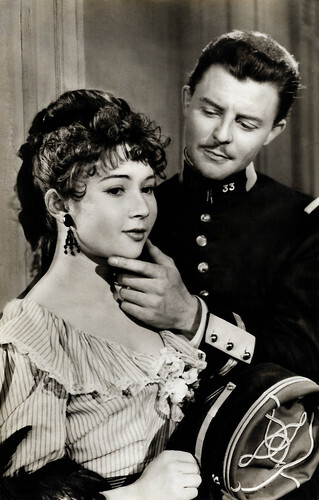
East-German postcard by VEB Progress Film-Vertrieb, Berlin, no. 212. Dany Carrel and Gérard Philipe in Les grandes manoeuvres / Summer Manoeuvres (René Clair, 1955).
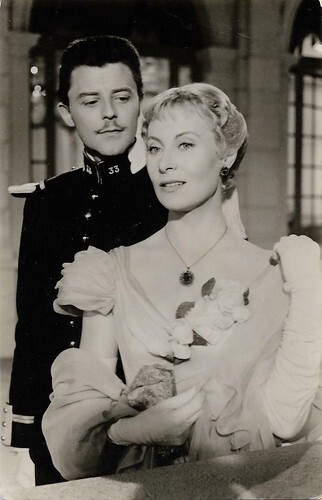
East-German postcard by VEB Progress Film-Vertrieb, Berlin, no. 194. Michèle Morgan and Gérard Philipe in Les grandes manoeuvres / Summer Manoeuvres (René Clair, 1955).
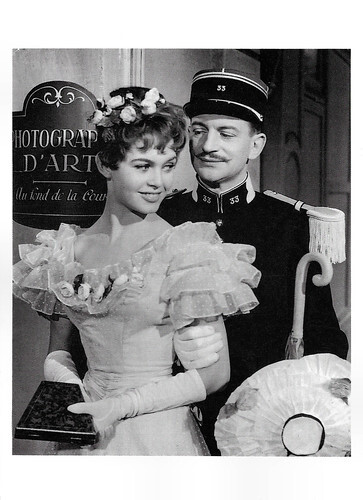
Swiss-German-British postcard by News Productions, Baulmes / Filmwelt Berlin, Bakede / News Productions, Stroud, no. 56501. Photo: Collection Cinémathèque Suisse, Lausanne. Brigitte Bardot and Yves Robert in Les Grandes Manoeuvres / Summer Manoeuvres (René Clair, 1955), produced by Filmsonor and Rizzoli Films.
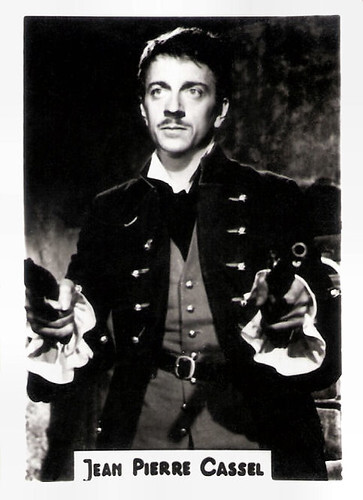
Small Romanian card by Cooperativa Fotografia, no. 2. Jean-Pierre Cassel in Les fêtes galantes / The Lace Wars (René Clair, 1965).
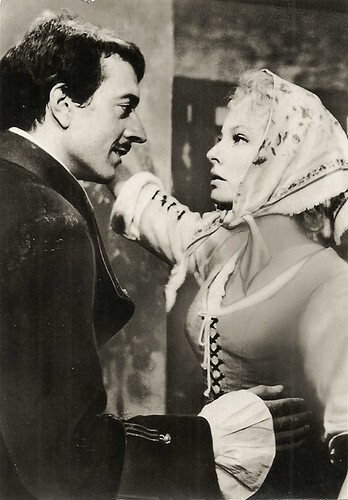
East-German postcard by VEB Progress Filmvertrieb, no. 2686. Jean-Pierre Cassel and Geneviève Casile in the Franco-Romanian coproduction Les Fêtes galantes / The Lace Wars (René Clair, 1965).
Sources: Wikipedia (Dutch, French and English) and .

Vintage postcard by Neobrom, no. 120.

French postcard in the Collection Magie Noire by Editions Hazan, Paris, no. 6192, 1989. Photo: Sam Lévin. Gérard Philipe and the shadow of Michel Simon in La Beauté du diable (René Clair, 1950).

French postcard in the Les Vedettes de l'Écran series by Éditions Filma, no. 126.

French postcard by Editions du Globe, Paris, no. 325. Photo: Sam Lévin. Gina Lollobrigida in Les belles de nuit / Beauties of the Night (René Clair, 1952).

American postcard by Fotofolio, NY, NY, no. LJ5. Photo: Lotte Jacobi. Caption: René Clair, Berlin, c. 1920s.
A series of films with a taste for the fantastic
René Clair was born René Lucien Chomette in Paris in 1898. He was the son of a soap manufacturer. His elder brother, Henri Chomette, later also became a writer and director. René grew up in Paris in the district of Les Halles, whose lively and picturesque character made a lasting impression on him. He attended the Lycée Montaigne and then the Lycée Louis-le-Grand, where he became friends with the poet Jacques Rigaut. In 1917, he was mobilised as a volunteer ambulance driver during World War I. He was deeply affected by the horrors of war that he witnessed and gave expression to this in writing a volume of poetry called 'La Tête de l'homme', which remained unpublished.
In 1918, he started working as a journalist for the left-wing newspaper L'Intransigeant under the pseudonym René Després. He also wrote lyrics for the music-hall singer Damia , under the pseudonym Danceny. Clair was persuaded by her to visit Gaumont studios in 1920, where a film was being cast. With Damia , he made his debut as the lead actor in the silent film Le Lys de la vie / The Lily of Life (Loïe Fuller, Gabrielle Sorère, 1920), written by Queen Marie of Romania.
He went on to play roles in other films like the serials L'Orpheline / The Orphan (Louis Feuillade, 1921) and Parisette (Louis Feuillade, 1921), both starring Sandra Milowanoff , and Le Sens de la mort / The Meaning of Death (Yakov Protazanov, 1922) with Diana Karenne . For these films, he chose the pseudonym René Clair. He also became director of the cinema supplement for the magazine Théâtre et Comœdia illustré.
In 1922, he became Jacques de Baroncelli's assistant on two films. That same year, he began writing the screenplay for Le Rayon diabolique, which he shot in 1923 with the support of the producer Henri Diamant-Berger. The film was released in 1925 under the title Paris qui dort. In the meantime, Eric Satie's ballet 'Relâche', for which Francis Picabia had written the libretto, was to be staged at the Théâtre des Champs-Élysées. The theatre's director, Jacques Hébertot, was also the director of Comœdia. Picabia wanted a short film to be shown during the interval and chose René Clair to direct it. The Dadaist-inspired film Entr'acte (1924), in which Marcel Duchamp and Man Ray also took part, caused a scandal and made Clair famous.
In the following years, Clair made a series of films with a taste for the fantastic. His Sci-Fi comedy Paris qui dort / Paris Asleep (1925) was followed by Le Fantôme du Moulin-Rouge / The Phantom of the Moulin-Rouge (1925) and Le Voyage imaginaire / The Imaginary Voyage (1926), which featured Albert Préjean . In 1926, Clair joined Alexandre Kamenka's Films Albatros company to film a dramatic story, La Proie du vent / The Prey of the Wind (1926), with Charles Vanel and Jean Murat. The film was a commercial success. Clair remained at Albatros for his last two silent films, the comedies Un chapeau de paille d'Italie / The Italian Straw Hat (1928) and Les Deux Timides / Two Timid Souls (1928), based on two plays by Eugène Labiche. Wikipedia : "As the author of all of his own scripts, who also paid close attention to every aspect of the making of a film, including the editing, Clair was one of the first French filmmakers to establish for himself the full role of an auteur." At the same time, René Clair devoted himself to writing a novel, 'Adams', which was published by Grasset in 1926. In 1929, he co-wrote the screenplay for Prix de beauté (1930), which he was initially also to direct. The film was directed by Augusto Genina, and Louise Brooks played the lead role.

German card. Photo: Verleih Hugo Engel-Film. Albert Préjean in Sous les toits de Paris / Under the Roofs of Paris (René Clair, 1930). Préjean plays a street singer and here distributes the texts of the song 'Sous les toits de Paris'.

French postcard by Eds. Le Malibran, Paris. Annabella and René Lefèvre in the comedy Le million / The Million (René Clair, 1931).

British postcard by. Photogravure. Robert Donat in the British comedy The Ghost Goes West (René Clair, 1935).

British Real Photograph postcard, no. 100b. Photo: London Films. Jean Parker in The Ghost Goes West (René Clair, 1935).

French coloured postcard by Eds. Centre Pompidou / Flammario, 1994. Maurice Chevalier and Marcelle Derrien in Le silence est d'or / Man About Town (René Clair, 1947).
An offer by Alexander Korda to work in London
René Clair was not happy with the arrival of sound film. He thought it would undermine the complex language constructed by the silent cinema over the last three decades. Ironically, it was his first talking film, Sous les toits de Paris / Under the Roofs of Paris (1930), that earned him an international reputation with prestigious admirers including Charles Chaplin and Sergei Eisenstein . He had realised the creative possibilities that sound film offered, particularly if the soundtrack was not used realistically; words and pictures should not be tied together in a clumsy duplication of information; dialogue did not always need to be heard.
His success was confirmed with the musicals Le Million / The Million (1931) with Annabella , À nous la liberté / Freedom for Us (1931), a utopian satire of industrial society, and Quatorze juillet / Bastille Day (1933). These films were made at the Epinay Studios for Films Sonores Tobis, a French subsidiary of the German-owned Tobis company.
When Chaplin's Modern Times came out in 1936. Tobis, which in 1935 had come under the control of Nazi propaganda minister Joseph Goebbels, decided to sue Chaplin for plagiarism of À nous la liberté / Freedom for Us (1931). Clair opposed this action, seeing Chaplin's film, which he admired, as an indirect homage to his film, but Tobis continued to sue Chaplin.
After the failure of Le Dernier Milliardaire / The Last Millionaire (1934), a satirical evocation of the 1929 crisis, René Clair accepted an offer by Alexander Korda to work in London. His first British film, The Ghost Goes West (1935), was a comic fantasy about transatlantic culture clash. It was a success. His next film, Break the News (1938), a musical comedy with Jack Buchanan and Maurice Chevalier , was a disappointment.
He returned to France in 1938 and began shooting a new project, Air pur, in July 1939. Shooting was interrupted by the mobilisation order in September, which sent various members of the film crew off to war, leaving the film unfinished. At the end of June 1940, René Clair left France with his wife and child. They went to Spain and then Portugal, and set sail for New York. The Vichy government stripped him of his French nationality, but reversed the decision later.

French film poster postcard by Dix et Démi Quinze, Paris, 1995. Affiche by Jean Adrien Mercier for À nous la liberté / Freedom for Us (René Clair, 1931). Released on the occasion of an exhibition on Jean Adrien Mercier.

Swiss poster postcard by CVB publishers. Affiche: Jean Adrien Mercier / Collection Cinémathèque Suisse, Lausanne. Affiche by Jean Adrien Mercier for Quatorze juillet / Bastille Day (René Clair, 1933).

French poster postcard by Eds. Zreik, Paris. Affiche Coll. Télérama, la mémoire du cinéma. French affiche for I Married a Witch (René Clair, 1940).

French poster postcard by F. Nugeron 29. Eds. Ramsay, Paris. Affiche: designed by Guy Gérard-Noèl. French poster for Les belles de nuit / Beauties of the Night (René Clair, 1952).

French poster postcard by Encyclopédie du Cinéma. Affiche: designed by René Peron. French poster for Porte des lilas / The Gates of Paris (René Clair, 1957), with Pierre Brasseur , Georges Brassens , Henri Vidal and Dany Carrel .
Four successful films in Hollywood
In June 1940, after the outbreak of World War II, René Clair emigrated to the United States, where he shot four successful films in Hollywood. He made his first American film for Universal Studios, The Flame of New Orleans (1941), starring Marlene Dietrich . The film was a commercial failure. Clair is highly regarded for the whimsical comedy I Married a Witch (1942), for which he effectively discovered latent comedic talents in his star Veronica Lake .
It was followed by It Happened Tomorrow (1944), which did respectably well. His mystery, And Then There Were None (1945), was an exceptional commercial success and is considered one of the most faithful adaptations of an Agatha Christie thriller. In 1946, Clair returned to France and made the romantic comedy Le silence est d'or / Silence is Golden (1947), an amusing evocation of the silent film era. It was Clair's first French film since the aborted project Air pur. Le silence est d'or also marked Maurice Chevalier 's return to the cinema after an absence of seven years.
Clair then made one of his most famous films, La Beauté du diable / Beauty and the Devil (1949), in which he revisited the myth of Faust and directed Gérard Philipe for the first time. Philipe also starred in his next film, the whimsical comedy Les Belles de nuit / Beauties of the Night (1952), also with Gina Lollobrigida . An International success was his film Les Grandes Manœuvres / Summer Manoeuvres (1955), starring Michèle Morgan, Gérard Philipe and Brigitte Bardot . His first film in colour won the Prix Louis-Delluc.
Clair then directed Porte des Lilas / The Gates of Paris (1957), featuring singer Georges Brassens in his only film appearance, playing the role of a singer who resembled him. From the 1950s, Clair also started writing, mainly essays, but also some novels and novellas. In 1960, he was elected as a member of the Académie française, as the first filmmaker. At the same time, the Nouvelle Vague overturned the rules of studio cinema, of which he had become the most prestigious representative. He then alternated between the sketch films La Française et l'Amour / Love and the Frenchwoman (1960) and Les Quatre Vérités / Three Fables of Love (1962) and the feature films Tout l'or du monde / All the Gold in the World (1961) with Bourvil , followed by his last film, Les Fêtes galantes / The Lace Wars (1965).
Clair then devoted himself to writing and directing plays. He restaged Francis Picabia's ballet 'Relâche' in 1970, and tried his hand at opera with 'Orphée et Eurydice' in 1973, presented at the Paris Opéra. In 1974, he was the president of the jury at the Cannes Film Festival. René Clair died in 1981 in Neuilly-sur-Seine, Hauts-de-Seine, France. He was buried in the ancient cemetery in Neuilly-sur-Seine. Since 1928, René Clair had been married to Bronia Clair. At the end of 1924, while Clair was working with Picabia, he first met a young actress, Bronja Perlmutter, who subsequently appeared in his film Le Voyage imaginaire (1926). They married in 1926, and their son, Jean-François, was born in 1927. Since 1994, the Académie has awarded the Prix René Clair for Best Camera Work.

French postcard in the Collection Magie Noire by Editions Hazan, Paris, no. 6195, 1989. Photo: Sam Lévin. Gérard Philipe and Michel Simon in La Beauté du diable (René Clair, 1950).

French postcard by Editions P.I. / Editions du Musée Grévin, Paris, no. 4. Photo: Musée Grévin, a wax museum in Paris, recreated a scene with wax figures of Gérard Philipe and Nicole Besnard in La Beauté du diable / Beauty and the Devil (René Clair, 1950). Caption: Voyage de noces a Venise (Honeymoon in Venice).

East-German postcard by VEB Progress Film-Vertrieb, Berlin, no. 212. Dany Carrel and Gérard Philipe in Les grandes manoeuvres / Summer Manoeuvres (René Clair, 1955).

East-German postcard by VEB Progress Film-Vertrieb, Berlin, no. 194. Michèle Morgan and Gérard Philipe in Les grandes manoeuvres / Summer Manoeuvres (René Clair, 1955).

Swiss-German-British postcard by News Productions, Baulmes / Filmwelt Berlin, Bakede / News Productions, Stroud, no. 56501. Photo: Collection Cinémathèque Suisse, Lausanne. Brigitte Bardot and Yves Robert in Les Grandes Manoeuvres / Summer Manoeuvres (René Clair, 1955), produced by Filmsonor and Rizzoli Films.

Small Romanian card by Cooperativa Fotografia, no. 2. Jean-Pierre Cassel in Les fêtes galantes / The Lace Wars (René Clair, 1965).

East-German postcard by VEB Progress Filmvertrieb, no. 2686. Jean-Pierre Cassel and Geneviève Casile in the Franco-Romanian coproduction Les Fêtes galantes / The Lace Wars (René Clair, 1965).
Sources: Wikipedia (Dutch, French and English) and .
Published on September 27, 2025 22:00
Paul van Yperen's Blog
- Paul van Yperen's profile
- 13 followers
Paul van Yperen isn't a Goodreads Author
(yet),
but they
do have a blog,
so here are some recent posts imported from
their feed.



